How to Write and Format a White Paper: The Definitive Guide


Table of Contents
What is a white paper, use and value, how to select a white paper topic:, white paper preparation, white paper format, final thoughts.
You’re ready to compile and share your company’s deep knowledge of your industry. A white paper seems like the perfect format. It’s a useful product to highlight your company’s expertise and a valuable tool in marketing.
But, how do you transform your knowledge into white paper content?
White papers are similar but distinct from business reports. In order to write a successful one, you need to understand the difference and include key elements. This article will help you decide if a white paper is right for you, and if yes, how to prepare and produce one.
To write a white paper, thoroughly research a topic and propose a comprehensive solution in a well-structured, factual, and persuasive document.
A white paper should include: 1. Title (accurate but enticing) 2. Abstract (including the Problem Statement) 3. Background (may be detailed and technical or broad and high-level, depending on audience) 4. Solution (the ‘ta-da’ moment of the white paper) 5. Conclusion (the summary of findings) 6. References (using correct industry format)
A white paper is an authoritative document intended to inform the reader on a particular topic fully. It combines expert knowledge and research into a document that argues for a specific solution or recommendation.
The white paper allows the reader to understand an issue, solve a problem, or make a decision.
White papers are data-centric, text-heavy business documents. Due to a large amount of data and research, white papers are deep reads and tend to have a formal tone.
Businesses write white papers both to record expertise and to market themselves to prospective customers.
White papers are generally written for an audience outside of the business. Therefore, they are a tool to attract readers to the company by offering top-quality, industry knowledge.
However, a white paper is not a sales pitch. It sells the company by highlighting the internal expertise and valuable recommendations, not by bidding for business.
Sales Pitch: 8 Ways ABC Marketing will save money on your social media budget
White paper: Social Media Advertising: Matching marketing needs and platforms

Write an actual white paper with individual instructor guidance.
Our Advanced Business Writing Course + Coaching includes written feedback and two live coaching sessions.
Choosing the right topic is essential to have your white paper read. There are three major factors:
1. Audience
As with any business writing, your audience is your first consideration. The white paper must be written with a target reader in mind. The audience may be long-time customers familiar with the industry or new prospective buyers who are entirely new to the field.
Reflect on the reader’s pain points or major questions. Within these topics, look for ones that have not been fully investigated or the available information is out-of-date.
2. Expertise
Your white paper should match and highlight your company’s expertise.
The entire document should provide a complete investigation, including external research and internal knowledge. The business’s own know-how informs the content that is included and how it is compiled.
3. Problem-based and solution-focused
White papers should identify and address a particular problem. The problem should be relevant and timely in your field. The document may focus on issues such as common dilemmas, new trends, changing techniques, and industry comparison.
The white paper must have a proposed solution or recommendation to answer the problem. This solution is based on thoroughly examining the problem and potential solutions.
The selected topic must be comprehensively researched. Pull information from online references, industry resources, and internal documents. White papers are data-focused, so they should be supported by significant research.
There’s no hard and fast rule on citations but you need to cite any information that is not public knowledge and that you didn’t know before beginning your research. However, understand that the reader’s confidence is likely to increase with an increasing number of cited references.
Of course, all resources must come from authoritative sites. In order to write a valuable document, all research materials must be from credible, reliable sources.
Read other white papers
Are there white papers covering your topic or area already? Read them to determine the knowledge gaps and the opportunities to build on existing content. This review will also ensure that your white paper is novel instead of redundant.
Use a mind-map
It can be overwhelming to keep track of the many sources, ideas, and content involved in preparing a white paper. A helpful organizational tool is the mind-map . A mind-map allows the writer to catalog and connect the many different pieces into one visual overview.
We suggest using the free tool MindMeister to organize your content. It’s simple to use and free.
FreeMind is another alternative but some organizations don't allow it to be used since it must be downloaded.
Don't forget visual elements
When designing a white paper, the written content is most important. However, taking the time to create an aesthetically pleasing design cannot be ignored. It should be remembered that the visuals used can greatly contribute to the overall impact of your white paper. By using visual elements such as images, animations, videos, charts, and graphs that reinforce and illustrate arguments, can greatly increase clarity for the reader while making key points stand out.
White papers generally follow a standard document format. The content order may seem similar to other business reports, but there is one major difference:
A white paper places the conclusion at the end.
Many business communications, such as technical reports or proposals, place the main conclusion at the beginning of the document. This order responds to the desires of the reader and their preference in receiving the information.
In a white paper, the content and research inform the reader and increase their understanding of the problem throughout the document. The final section provides the ‘ta-da!’ moment where the reader now receives the solution which is supported by the evidence in the document.
The reader’s journey and preferences in a white paper and business report differ. The major findings follow suit.
If you’re unsure of these distinctions or are looking to improve your business writing skills, consider enrolling in our online self-paced Technical Report Writing Course (see all of our courses here ).
And, no matter the journey, the document must be easy to understand and include informative headings for easy navigation.
Choose an accurate title
A good title is essential. It should clearly indicate what the reader will learn from the white paper. It should also be enticing.
Bland title example: White paper on Law 123.4 Referencing Environmental Impact Assessments.
Enticing title example: The Rules are Changing: White Paper on the Environmental Impact Assessment Legislation Proposals in 2018
The phrase ‘white paper’ does not necessarily need to be in the title at all. Some audiences are seeking that authoritative indicator. Other readers may be scared off from valuable content because of the term. As always, think of what your audience would prefer.
The abstract offers the reader a brief overview of the white paper’s main points. It allows the reader to ensure they have found a document relevant to their needs. After reading, the reader should be able to know if they are ‘in the right place.’
Problem statement
The problem statement specifies the issue the white paper will address. The problem needs to be defined and placed into a context to ensure it’s understood by the reader.
This section provides the background information required for the audience to grasp the problem and, ultimately, the solution. The content may be detailed and technical or broad and high-level. The content depends on the reader and the problem.
If original research is completed for the white paper, the methods should be communicated.
The ‘ta-da’ moment of the white paper.
Based on the preceding information, the solution is now presented. It is developed and argued for using the gathered evidence and the expertise of the author and their company.
This section summarizes the white paper’s major findings. Recommendations based on the solution are provided.
All sources used to develop the white paper must be collected and cited in this section. It adds validity to the document. It also gives the reader content for further research. Depending on your industry, follow MLA or APA citation formats.

Write any complex document and get personal feedback on your actual business writing.
Our Advanced Business Writing Course + Coaching includes written feedback and two live coaching sessions on any document.
Writing a good white paper is not a simple task. However, the investment of time and skill can produce a valuable document that shares your company’s knowledge, contributing to overall education and progress in your industry. And, a good white paper increases business opportunities. As you develop an informational document such as a white paper, it's helpful to strengthen your writing process with our Advanced Business Writing course.
Related Articles
How to improve your business english writing skills, how to write a request for proposal (rfp) response, 11 best proposal creation software tools, get notified of new articles.

- Business Writing Skills (57)
- Business Grammar (52)
- Technical Writing (33)
- Business Writing Resources (26)
- Business Email Writing (17)
- Business Writing Training (12)
- Business Proposals (10)
- Business Report Writing (7)
- Business Proofreading (4)
- Sales Writing (3)
- Executive Summary Writing (2)
- Customer Support Writing (1)
- Bailey Lang (1)
- Elisabeth O'Quinn (14)
- Grace Cuddy (6)
- Haley Larsen (4)
- Kara Latz (10)
- Katie Almeida Spencer (31)
- Malcolm Stiefel (1)
- Mary Cullen (134)
- Samantha Taylor (6)
- Terrance Collins (1)
- Tom DuPuis (10)

Writing a White Paper (Format, Tips, Examples & Templates)
Get white paper examples by leading companies. Learn how to write & format a white paper for business and marketing. Create, write & design white papers A-Z.
8 minute read

helped business professionals at:

Short answer
What is the best white paper format?
- Executive Summary
- Introduction
- Problem Statement
- Solution Overview
- Benefits and Advantages
- Case Studies or Examples
- Technical Details or Methodology
- Recommendations
- References or Sources
What makes an effective business white paper?
An effective business white paper format is concise, well-researched, and addresses a specific audience's pain points. It offers actionable solutions, incorporates compelling visuals, and establishes the author's authority on the subject.
Key considerations when creating a business white paper
Audience Understanding : Know your target audience's needs and preferences.
Clear Objective: Define the purpose of the white paper.
Visual Appeal: Incorporate relevant charts, graphs, and images.
Credibility : Cite reliable sources and provide evidence.
Engaging Narrative: Craft a compelling story in content and design that guides the reader.
How to write a white paper (step-by-step guide)
Writing a white paper is no small feat. It requires research, understanding, and a knack for presenting information engagingly.
But with the right approach, your white paper can position your brand as an industry leader, driving leads and fostering trust. Remember, it's all about offering value and meeting the needs of your audience.
Step 1: Grasp the white paper's core
Recognize that a white paper is more than just a long article. It's a detailed report on a specific topic, designed to educate and address issues.
Understand its origins from government documents and its evolution into a tool for thought leadership.
Step 2: Define your target audience
Identify who you're writing for: industry professionals, novices, or another group.
Tailor your language, tone, and content depth to their needs and interests.
Step 3: Prioritize value over promotion
Keep the content educational and avoid overtly promotional language.
Aim to establish trust and position your brand as a reliable information source.
Step 4: Embrace the drafting process
Don't aim for perfection in the first go.
Write multiple drafts, take breaks, and seek feedback for refinement.
Step 5: Build your content around a narrative (not facts)
Use storytelling techniques to maintain reader interest.
Introduce problems, provide solutions, and share success stories for context.
Step 6: Dodge common mistakes
Avoid a salesy tone; keep it educational.
Base your content on thorough research.
Invest in good design for readability and engagement.
Ground your content in real-world examples and actionable insights.
Step 7: pay attention to format and design
Use design elements to highlight key information when formatting your white paper.
Stay updated with design trends, but ensure they align with your topic and audience.
Step 8: conclude and review
Summarize the main points and insights.
Review the entire content for coherence, clarity, and value.
16 impactful white paper examples for business and marketing
Discover exemplary business white paper formats from industry leaders to refine your approach. Draw inspiration from best practices and elevate your corporate documentation standards, and learn est practicess based on our in-depth analysis of each example.
Microsoft white paper
The white paper from MSA discusses the future of operational development, emphasizing changes in the operational landscape. It targets professionals in the operational and business development sectors.

Good Points:
Forward-Looking: The document does an excellent job of forecasting future trends and aligning them with current industry practices, making it highly valuable for strategic planning.
Cohesive Structure: The white paper is organized logically, allowing for easy navigation and comprehension of the content.
Inclusion of Data: The use of data, charts, and figures strengthens the arguments and offers readers empirical evidence to support the presented information.
Engaging Imagery: The inclusion of relevant images and diagrams aids in visualizing the concepts discussed. The visuals are not only explanatory but also break the monotony of continuous text, making the reading experience more engaging.
Bad Points:
Generalized Statements: At times, the document can be a bit broad in its statements, lacking specific details that might be beneficial to the reader.
Heavy Text: The document leans heavily on text, with fewer visual elements like charts or infographics, which might make it denser for some readers.
Lack of Actionable Insights: While the paper provides a broad overview of the future landscape, it could benefit from more actionable recommendations for businesses to apply immediately.
Lack of Summaries: While the content is well-structured, there's a missing element of concise summaries or key takeaways at the end of major sections. Providing these could aid readers in recapping the essential points discussed.
Missing Call to Action: The document provides valuable information but lacks a clear call to action, guiding the reader on the next steps or how to further engage with the topic or the organization.
Google Cloud white paper
Google Cloud's white paper emphasizes its commitment to privacy in Generative AI. Targeted at enterprise customers, it belongs to the cloud computing and artificial intelligence industry.

Detailed Explanations: The document provides thorough explanations of how user data is treated, ensuring transparency.
Relevance to Current Trends: Addressing privacy in AI is timely and crucial, making this paper highly relevant to current industry concerns.
Repetitiveness: Some points, especially around data ownership and privacy, are reiterated multiple times, which might make the content feel redundant.
Lack of Practical Examples: While the commitments are clear, real-world examples or case studies would help readers understand the practical implications better.
Visual Enhancements: While the design is clear, it could benefit from more engaging visuals or infographics to highlight key points or statistics, adding an extra layer of engagement.
Interactive Elements: Given the digital nature of the topic and the platform (Google Cloud), the integration of interactive elements or links to online demos, tutorials, or related resources could further enrich the reader's experience.
Amazon AWS white paper
This document from AWS provides a framework for designing and operating machine learning workloads using best practices. It's intended for solution architects and ML practitioners in the tech industry.

Depth and Breadth: AWS dives deep into each of the five pillars of the Well-Architected Framework. It provides thorough explanations, ensuring that readers understand each concept.
Use of Case Studies: Real-world examples and case studies are included, which offer readers practical insights and relatable scenarios.
Relevance: The document clearly understands its target audience. By providing specific AWS service recommendations for different ML scenarios, it offers actionable insights.
Technical Jargon: While it's aimed at professionals, the language can sometimes be overly technical, which might make it less accessible to newcomers.
Length: The document is quite lengthy. While it covers a lot, it might be overwhelming for some readers, especially those looking for quick solutions.
Assumed Prior Knowledge: The document sometimes assumes the reader has prior knowledge of AWS services, which might not always be the case.
Engaging Design Elements: While the document is informative, it could benefit from more design elements, such as infographics or pull quotes, to break up the monotony and highlight key points.
Apple white paper
This document by Apple introduces ProRes RAW, a new video codec, detailing its features and benefits. It's crafted for video professionals, filmmakers, and content creators in the multimedia sector.

Technical Mastery: Apple showcases its technical prowess, diving deep into the intricacies of the codec, which will be appreciated by professionals in the field.
Benefits Highlighted: The document effectively underscores the advantages of using ProRes RAW, making it clear why it stands out from other codecs.
Practical Use Cases: Apple includes scenarios and cases where ProRes RAW can be best utilized, providing context and clarity to readers.
Assumed Knowledge: The white paper assumes a certain level of technical expertise from the reader. While this is okay for its target audience, it might alienate novices.
Limited Comparisons: Although the document does a great job explaining ProRes RAW, it could benefit from direct comparisons with other existing codecs.
Dense Terminology: There's a heavy use of technical jargon without sufficient explanations, which could be challenging for those not deeply versed in video codecs.
Lack of Interactive Elements: Given the brand and the nature of the topic, incorporating interactive elements like QR codes leading to video demonstrations or tutorials could have added significant value.
Missing Call to Action: While the document provides a plethora of information, it doesn't guide the reader on the next steps, whether that's purchasing a product, joining a workshop, or any other related action.
IBM white paper
Market Connections' white paper focuses on enhancing data utility and management. It caters to business leaders, data analysts, and professionals in the data-driven decision-making realm.

Engaging Visual Design: The document uses a vibrant color palette, dynamic shapes, and appealing graphics, which make the content pop. This design approach draws the reader in and keeps them engaged.
Relevance to Current Trends: In today's data-centric world, the paper's focus on supercharging data is timely and resonates with the needs of modern businesses.
Concrete Recommendations: The document provides specific strategies and tools for improving data utility, making it actionable for readers.
Case Studies & Testimonials: The inclusion of real-world examples and testimonials lends credibility and offers a practical perspective on the discussed topics.
Lack of Technical Depth: While the paper is informative, it doesn't delve deep into the technical aspects of data management, which might leave some tech-savvy readers wanting more.
Generic Advice: Some sections offer generalized advice that can be found in many other resources, making them less unique.
Potential Bias: The paper occasionally comes across as promotional for Market Connections' services, which might detract from its objectivity.
Oracle White Paper
This document from Oracle delves into the integration of Oracle Content and Experience with Oracle WebCenter Portal. Targeted at IT professionals, it belongs to the tech and software industry.

Clear Structure: The paper is well-organized with distinct sections, making it easy for readers to navigate and find specific information.
Visual Aids: The use of diagrams and flowcharts helps in understanding complex processes and integrations.
Technical Depth: The paper provides in-depth technical details, ensuring that IT professionals can grasp the intricacies of the integration.
Jargon-Heavy: While it's intended for IT professionals, the heavy use of jargon might alienate readers who are not deeply familiar with Oracle's suite of products.
Lack of Real-World Examples: The paper could benefit from real-world use cases to illustrate the benefits of the integration.
Aesthetic Appeal: The design is quite basic, and a more modern and engaging layout might make the content more appealing to a wider audience.
SAP white paper
SAP's white paper delves into digital manufacturing within regulated environments, emphasizing quality and compliance. It's designed for manufacturing professionals, quality assurance teams, and regulatory compliance officers.

Industry-Specific Insights: SAP offers valuable insights tailored to regulated manufacturing environments, ensuring the content is highly relevant to its target audience.
Holistic View: The document covers a wide range of topics, from digital transformation to compliance challenges, offering a comprehensive overview.
Expertise on Display: SAP's deep industry knowledge is evident, lending credibility to the information and recommendations provided.
Complexity: The document, at times, delves into intricate details which, while valuable, might make it challenging for readers unfamiliar with the topic.
Promotional Tone: There's a noticeable push towards SAP's solutions, which, while understandable, might come off as less objective to some readers.
Lack of Practical Examples: While the paper is rich in information, it could benefit from more real-world examples or case studies to illustrate the discussed concepts.
Lack of Visual Summaries: While the document is rich in content, it misses out on visual summaries (like infographics) that can quickly convey complex information. Given the technical nature of the topic, such visuals would be beneficial for comprehension.
Pfizer white paper
This white paper by Pfizer delves into the significance of community engagement in diversifying clinical trials, particularly focusing on the Pfizer-BioNTech COVID-19 vaccine trial.
It aims to address the healthcare disparities highlighted by the pandemic and the urgent need for diverse representation in clinical trials.
The target audience includes healthcare professionals, researchers, and policymakers in the medical and pharmaceutical industries.

Comprehensive Structure: The document is well-structured with clear headings, subheadings, and a table of contents, making it easy for readers to navigate and understand the content.
Relevant Data and Citations: The white paper provides relevant statistics, data, and references to support its claims, enhancing its credibility.
Clear Objective: The paper's goal is evident from the beginning, ensuring that readers understand its purpose and the importance of the topic.
Lengthy Content: Some sections are quite detailed, which might be overwhelming for readers looking for quick insights.
Lack of Visuals: The document could benefit from more graphs, charts, or infographics to break the monotony and present data in a more engaging manner.
Repetitive Emphasis: While the importance of diversity in clinical trials is a crucial topic, the paper occasionally reiterates the same points, which could be condensed for brevity.
AT&T white paper
This white paper delves into the importance of mobility in the modern collaboration era. It's intended for business leaders, IT professionals, and teams looking to enhance collaborative efforts in the digital age.

Well-Structured: The document is organized in a logical manner, with clear sections and subheadings, facilitating easy navigation.
Actionable Advice: It provides concrete strategies and recommendations on enhancing mobility for collaboration, ensuring readers can take immediate action.
Potential Overemphasis: While mobility is essential, the document occasionally seems to overstate its importance, which might come across as a bit unbalanced.
Lack of Diverse Case Studies: While there are some examples, the paper could benefit from a broader range of case studies across different industries.
Assumed Context: The paper sometimes assumes readers are fully aware of the current collaboration landscape, which might not be true for everyone.
Tesla white paper
Dell Technologies' ESG report showcases their commitment to driving human progress through sustainable technology, emphasizing their efforts in advancing sustainability, cultivating inclusion, transforming lives, and upholding trust.

Highly Specialized Content: The paper zeroes in on a niche topic within the energy sector, providing deep insights that are valuable to a specific audience.
Clear Explanations: Complex concepts related to net billing tariffs are broken down and explained in a comprehensible manner.
Data-Driven Arguments: The use of charts, figures, and empirical data adds weight to the points being made and supports the document's claims.
Narrow Focus: While the specialized content is a strength, it also means the paper might be too narrow for a general audience or those looking for a broader overview of the energy sector.
Stylized Language: At times, the document uses language that's a bit too stylized or technical, which might make it less accessible to some readers.
Potential Bias: The paper seems to advocate for specific tariff structures, which might come off as less objective to some reader mmunities.
CitiBank white paper
This white paper delves into the transformation and disruption in financial market infrastructures, focusing on the evolution of securities services. Intended for financial professionals and industry leaders, it belongs to the banking and financial services sector.

Comprehensive Coverage: The document provides a holistic view of the securities services landscape, touching upon various aspects like settlement transformation, digital assets, and the role of Central Securities Depositories (CSDs).
Data-Driven Insights: The paper is backed by quantitative data, with surveys involving 483 individuals globally, offering credibility to its findings.
Complex Jargon: The document uses industry-specific terms that might be challenging for readers unfamiliar with the financial sector.
Lengthy: While comprehensive, its extensive coverage might be overwhelming for someone looking for quick insights.
Lack of Visual Aids: More charts, graphs, or infographics could have made the data more digestible and engaging.
General Electric white paper
GE's white paper discusses the evolving landscape of global power markets. Intended for energy industry decision-makers. The document provides a holistic view of the energy market, touching on various aspects from production to consumption

Comprehensive Overview: The document provides an in-depth exploration of power markets, encompassing historical data, current trends, and future projections. This thorough approach offers readers a holistic perspective on the subject.
Effective Data Visualization: The use of charts, graphs, and tables is commendable. They present intricate data in a digestible format, allowing readers to quickly grasp key trends and insights.
Segmented Content Approach: The content is divided into distinct sections, each addressing specific facets of power markets. This segmentation aids in navigation and allows readers to delve into areas of specific interest.
Dense Text: Some sections are text-heavy, which might be overwhelming for some readers. Breaking up the content with more visuals or bullet points could improve readability.
Design Uniformity: While the document is rich in content, there's room for improvement in terms of design consistency, particularly in the color schemes and visual elements used.
Static Design: Given the technical and extensive nature of the topic, integrating interactive elements or links to supplementary multimedia resources could enhance the reader's engagement and understanding.
Clarification of Technical Aspects: The document occasionally uses industry-specific terms and concepts. Including a glossary or providing side notes with explanations would ensure accessibility for readers not deeply familiar with power markets.
ExxonMobil white paper
A comprehensive exploration of ExxonMobil's commitment to the energy transition, focusing on innovative solutions for lower-emission marine fuels. Targeted at stakeholders in the marine industry and those invested in sustainable energy solutions.

Relevant Data: The white paper provides specific data points, such as projected energy consumption and emission reduction targets, which lend credibility to the content.
Engaging Visuals: While I couldn't directly view the visuals, the structure suggests the inclusion of charts or images, which can help break up the text and provide visual context.
Lengthy Content: Some sections could benefit from concise writing to ensure the reader remains engaged throughout.
Call to Action: While the document provides valuable information, it could benefit from a clearer call to action, guiding readers on the next steps or how to get involved.
World Economic Forum (WEF) white paper
The World Economic Forum's white paper delves into the emerging concept of the industrial metaverse. It's crafted for industry leaders, technologists, and policymakers keen on understanding the future intersection of industry and virtual realms.

Cutting-Edge Topic: The WEF addresses a novel and emerging trend, making the paper a valuable resource for those looking to stay ahead in the tech and industrial sectors.
Expert Contributions: The document includes insights from industry experts and thought leaders, lending credibility and depth to the content.
Global Perspective: As expected from the WEF, the paper provides a global view, considering the implications and developments of the industrial metaverse across different regions and cultures.
Infographics and Visual Aids: The use of charts, graphs, and other visual aids complements the text and provides a break from long passages. This not only makes the content more engaging but also aids in quicker comprehension of complex data.
Conceptual Density: The topic, being new, is also complex. The paper sometimes delves into highly conceptual discussions which might be challenging for some readers.
Potential Overhype: While the industrial metaverse is undoubtedly exciting, the paper occasionally might come across as too optimistic, without sufficiently addressing potential pitfalls or challenges.
Lack of Practical Guidance: The document is rich in forecasting and analysis but could benefit from more actionable insights or steps for businesses to start their metaverse journey.
Lack of Interactive Elements : For a topic like the metaverse, which is inherently interactive and dynamic, the inclusion of QR codes or links to interactive demos, videos, or web pages might have enhanced the reader's experience.
Siemens white paper
Siemens explores the transformation towards smart manufacturing, emphasizing the integration of digital and physical realms. Aimed at manufacturers, it belongs to the industrial automation and digitalization sector.

Holistic Approach: The paper offers a comprehensive view of the smart manufacturing journey, from challenges to outcomes, ensuring readers get a full picture.
Use of Models: The introduction of concepts like the Digital OODA Loop provides readers with actionable frameworks to apply in their operations.
Human-Centric Focus: Beyond just machinery and processes, the paper emphasizes the importance of human-centric outcomes, highlighting the balance between technology and worker well-being.
Assumed Familiarity: The paper dives deep into specific Siemens solutions without always providing sufficient background, which might be challenging for those unfamiliar with Siemens' offerings.
Limited External Perspectives: The paper heavily focuses on Siemens' solutions. Incorporating third-party testimonials or case studies might have added more credibility and a broader perspective.
Verizon white paper
This white paper emphasizes the importance of network resilience in the face of Distributed Denial of Service (DDoS) attacks. Targeted at C-level executives, it belongs to the telecommunications and cybersecurity industry.

Verizon thought-leadership white paper
Practical Recommendations: The document offers actionable steps for C-level leaders to enhance network resilience, making it a hands-on guide.
Relevance to Current Threat Landscape: By focusing on DDoS attacks, which are prevalent today, the paper addresses a pressing concern for many businesses.
Promotional Content: The inclusion of Verizon's own solution (DDoS Shield) might come off as promotional, potentially detracting from the paper's objective tone.
Lack of Case Studies: Real-world examples or case studies could have added more weight to the paper's arguments and made it more relatable.
How to design a white paper for engagement
White papers are essential tools for businesses, especially in the B2B sector, to establish authority, inform potential customers, and influence their decisions.
But beyond the content, the design of a white paper plays a pivotal role in capturing the reader's attention and ensuring the message is effectively conveyed.
Best practices for white paper design
Readability is Key: Ensure that the text is easy to read. Use short paragraphs, bullet points, and subheadings to break up the content. The choice of font and its size also plays a crucial role in readability.
White Space: Don't clutter the design. Proper use of white space can make the content more breathable and aesthetically pleasing.
Mobile Optimization: With many users accessing content on mobile devices, ensure that your white paper design is responsive and looks good on all screen sizes.
Interactive white paper design
Engage with Multimedia: Modern digital platforms allow for the integration of videos, GIFs, and animations in white papers. These multimedia elements can make the content more dynamic and engaging.
Clickable Elements: Incorporate hyperlinks, clickable infographics, and call-to-action buttons. This not only provides additional resources to the reader but also encourages them to explore related content or take desired actions.
Feedback Loops: Allow readers to leave comments, ask questions, or even participate in polls within the white paper. This interactivity can provide valuable insights into what your audience thinks and feels about the content.
Here is what a static white paper looks like compared with an interactive white paper:

Designing White Papers for Storytelling
Narrative Flow: Just like a compelling story, a white paper should have a clear beginning, middle, and end. Start with an introduction that outlines the problem or challenge, delve into the details in the main content, and conclude with a solution or call to action.
Visual Elements: Use graphics, charts, and images to break the monotony of text and illustrate complex ideas. These visual elements not only make the content more engaging but also help in explaining intricate concepts in a digestible manner.
Consistent Branding: While the white paper should be informative, it's also an opportunity to subtly reinforce your brand. Use consistent colors, fonts, and logos that align with your brand identity.
Here's an example of storytelling white paper design:
Business white paper interactive storytelling templates
With traditional PowerPoint slides, your content may blend into the crowd. Storydoc's interactive white paper templates elevate your content, making it dynamic and memorable.
Unlike static slides, Storydoc's animated, annotated, and narrated templates engage readers, making them twice as captivating as standard reports.
Moreover, they're cost-effective and let you quickly produce your white paper.
I am a Marketing Specialist at Storydoc, I research, analyze and write on our core topics of business presentations, sales, and fundraising. I love talking to clients about their successes and failures so I can get a rounded understanding of their world.
Found this post useful?
Subscribe to our monthly newsletter.
Get notified as more awesome content goes live.
(No spam, no ads, opt-out whenever)
You've just joined an elite group of people that make the top performing 1% of sales and marketing collateral.

Create your best white paper to date.
Try Storydoc interactive white paper creator for 14 days free (keep anything you make forever!)
- Article Writing Affordable Article Writing Services
- Blog Writing Blogs that optimise your visibility
- Product Description Website that optimise your visibility
- Website Writing Website that optimise your visibility
- Proofreading Website that optimise your visibility
- Translation Website that optimise your visibility
- Agriculture Affordable Article Writing Services
- Health & Beauty Blogs that optimise your visibility
- Automotive Website that optimise your visibility
- Sports & fitness Website that optimise your visibility
- Real Estate Website that optimise your visibility
- Entertainment Website that optimise your visibility
- Blogs Affordable Article Writing Services
- Samples Blogs that optimise your visibility
- Case Study Website that optimise your visibility

How to Write a Compelling White Paper: Step-by-Step Guide
A white paper is an authoritative document designed to inform and persuade stakeholders by providing in-depth research and solutions to specific problems. Key elements include the title, abstract, introduction, problem statement, solution, conclusion, and references. Creating a detailed outline is essential for organization and effectiveness. Writing and formatting tips include using clear language, supporting claims with data, and incorporating visuals. Templates and examples can guide the structure and design. The time required to write a white paper varies based on complexity and research needs. Understanding how to write a white paper ensures the creation of a professional and impactful document.
White papers are authoritative documents designed to inform and persuade stakeholders by providing in-depth research and insights on specific issues. They play a crucial role in business and technical fields, helping companies establish thought leadership, generate leads, and drive decision-making.
Understanding how to write a white paper is essential for businesses looking to present comprehensive analyses and propose solutions to complex problems. This guide covers every aspect of writing a white paper, from defining its purpose to finalizing its format. You’ll learn how to create a white paper document, including the essential steps and key elements involved.
We’ll also explore how to format a white paper to ensure it is professional and engaging. Whether you’re wondering how to write a white paper outline or seeking a how to write a white paper example or template, this guide provides detailed instructions and tips. Finally, we’ll discuss how long does it take to write a white paper, offering time estimates based on various factors. By the end of this guide, you’ll have a clear understanding of how to write a technical white paper and be equipped with the tools to create an impactful document.
What is a White Paper?
1. Detailed Definition
A white paper is an authoritative document that addresses a specific issue, provides comprehensive analysis, and proposes a well-supported solution. Originating from governmental use, white papers are now a staple in various industries, including technology, finance, and healthcare. They serve multiple purposes, such as educating stakeholders, influencing decision-making, and establishing thought leadership.
White papers are distinct from other forms of reports due to their depth and detail. They are typically targeted at a professional audience looking for detailed information and insights on a particular topic. Understanding how to write a white paper involves structuring the document to communicate complex ideas and data effectively.
2. Historical Context and Evolution
White papers have their roots in early 20th-century Britain, where they were used by the government to present policy proposals and legislative intentions. The term “white paper” was introduced to distinguish these concise reports from the more detailed “blue books” and preliminary “green papers.” One of the earliest examples is the 1922 Churchill White Paper, which outlined Britain’s policy in Palestine.
Over the years, white papers evolved beyond government use to become essential tools in business and technology sectors. Companies use white papers to present detailed analyses, propose solutions, and establish authority on specific subjects. For example, in the technology industry, white papers often detail new technologies, such as AI algorithms or blockchain platforms, providing comprehensive overviews for investors, users, and regulators.
3. Common Uses in Different Industries
White papers serve multiple purposes across industries. In technology, they explain complex products and innovations. In finance, they analyze market trends and investment strategies. In healthcare, they discuss medical advancements and regulatory changes. Understanding how to write a technical white paper can help you tailor the document to your industry’s needs.
Mastering how to write a white paper outline ensures your document is organized and effective. Whether you’re creating a how-to-write, a white paper example for internal use or a public how-to-create white paper document, the principles remain the same. Use clear language, support your claims with data, and structure your content logically.
By following these guidelines, you can produce white papers that establish your authority and engage your audience. This foundation will help you understand how to format a white paper and make it compelling and informative.
How to Create a White Paper Outline
1. Importance of an Outline
Creating a detailed outline is crucial for the success of your white paper. It helps organize your thoughts and ensures a logical flow of information. An effective outline acts as a roadmap, guiding you through the writing process and keeping your content focused. This is an essential step in mastering how to write a white paper. A well-structured outline allows you to break down complex information into manageable sections, making the writing process smoother and more efficient.
2. Step-by-Step Process to Create an Outline
Define the purpose and audience.
Start by identifying the purpose of your white paper and understanding your target audience. Knowing how to create a white paper involves tailoring your content to meet the specific needs and interests of your readers. Ask yourself what problem your white paper aims to solve and who will benefit from it. This clarity helps you to craft the content that resonates with your audience and achieves your objectives.
Research and Gather Information
Thorough research is the backbone of any effective white paper. Collect data, case studies, and expert opinions that are relevant to your topic. This is a key aspect of how to write a technical white paper, as it provides the necessary evidence to support your arguments. Use credible sources and ensure your information is up-to-date. Organize your research material into categories to make it easier to reference during the writing process.
Organize Sections Logically
Structuring your white paper logically is essential for readability. Begin with a strong introduction that outlines the topic and its significance. Follow with a detailed problem statement explaining the issue at hand. The main body should present the proposed solution, supported by data and examples. Conclude with a summary of key points and actionable recommendations. This logical flow is vital in formatting a white paper effectively.
Detail Each Section with Key Points
Break down each section into key points or sub-sections. For example, in the problem statement, list the specific challenges your audience faces. In the solution section, outline the steps or strategies you recommend. This detailed approach is crucial in how to write a white paper outline as it helps maintain focus and ensures that all relevant aspects are covered comprehensively.
Introduction:
- Define the topic.
- State the purpose.
- Outline the main points.
Problem Statement:
- Describe the problem.
- Explain why it matters.
- Provide context and background.
Solution/Approach:
- Present the proposed solution.
- Support with data and case studies.
- Explain the benefits and advantages.
Conclusion:
- Summarize key points.
- Offer actionable recommendations.
- Highlight the importance of the solution.
References and Appendices:
- List all sources.
- Include additional data or documents.
Creating a detailed outline is a fundamental step in writing a white paper. It ensures that your document is well-organized and easy to follow. Whether you are developing a white paper example or using a white paper template, a comprehensive outline helps structure your content effectively. By following these steps, you can produce a white paper that is clear, persuasive, and impactful, meeting the needs of your target audience and achieving your communication goals.
Writing and Formatting Tips for a White Paper
1. Writing Tips
A) use clear and concise language.
Effective white papers are easy to read. Use simple language and avoid jargon. This is essential when learning how to write a white paper.
b) Adopt an Engaging and Persuasive Tone
Engage your readers with a compelling narrative. Use a tone that persuades and keeps them interested. This is particularly important in writing a technical white paper, where maintaining reader interest can be challenging.
c) Support Claims with Data and Evidence
Back up your arguments with solid data, statistics, and credible sources. This adds credibility and supports your conclusions. Knowing how to create a white paper document involves extensive research to gather this supporting information.
2. Formatting Tips
A) consistent style and structure.
Maintain a uniform style throughout your white paper. Consistent formatting makes your document look professional. Understanding how to format a white paper is crucial to achieving this consistency.
b) Use Headings, Subheadings, and Bullet Points
Break up text with headings, subheadings, and bullet points. This improves readability and helps readers quickly find the information they need. When considering how to write a white paper outline, plan these elements carefully to enhance the document’s structure.
c) Incorporate Visual Elements
Use charts, graphs, and images to illustrate key points. Visual aids make complex information more digestible and can enhance engagement. Examples of how to write a white paper example often include these elements to demonstrate best practices.
3. Additional Writing Tips
A) draft and revise.
Write multiple drafts and revise them. Editing improves clarity and ensures your message is communicated effectively. This step is essential in how to write a white paper and ensures the final product is polished.
b) Use a Professional Tone
Maintain a formal and professional tone throughout your white paper. This will enhance your credibility and appeal to your target audience.
c) Cite Sources Properly
Always cite your sources. This not only gives credit where it’s due but also strengthens your arguments by showing the depth of your research. Proper citations are a key part of how to create a white paper document that is authoritative and reliable.
4. Additional Formatting Tips
A) create a table of contents.
For longer white papers, include a table of contents. This helps readers navigate the document easily and find sections of interest quickly.
b) Ensure Visual Consistency
Make sure that all visual elements are consistent in style and format. This uniformity contributes to a professional appearance and enhances readability.
c) Proofread Thoroughly
Check your white paper for grammatical errors and typos. A well-proofread document reflects attention to detail and professionalism. This is an important aspect of how to write a white paper template that will be used as a model for future documents.
By following these writing and formatting tips, you can create a compelling and professional white paper. Whether you’re seeking a white paper example or developing your own template, these guidelines will help ensure your white paper is effective and well-received. Additionally, considering how long does it take to write a white paper depends on the thoroughness of your writing and formatting efforts. Proper planning and attention to detail can streamline the process and enhance the quality of your final document.
Examples and Templates for White Papers
1. Overview of Useful Templates
Using a template can significantly streamline the process of writing a white paper. Templates provide a pre-designed structure, ensuring that your document is organized and professional. Many resources offer how to write a white paper template that includes essential sections like the introduction, problem statement, solution, and conclusion. These templates can be customized to fit the specific needs of your project, helping you learn how to format a white paper effectively.
2. Analysis of Successful White Paper Examples
Examining successful white papers can provide valuable insights into what works well. For instance, looking at how to write a white paper example from leading companies can show you how to present data, structure your arguments, and use visual elements. Effective white papers often feature clear problem statements, well-supported solutions, and concise conclusions. By studying these examples, you can learn how to create a white paper document that engages and persuades your audience.
Here are some key elements found in successful white papers:
- Clear and Compelling Titles: Titles that grab attention and reflect the content.
- Structured Content: Logical flow with clear headings and subheadings.
- Visual Elements: Charts, graphs, and images to illustrate key points.
- Credible Data: Well-researched and sourced information to support claims.
- Professional Formatting: Consistent style and clean layout.
3. Links to Downloadable Templates
Several platforms offer downloadable templates to help you get started. Websites like Visme , HubSpot , and Piktochart provide a variety of templates tailored to different industries and purposes. These templates serve as a white paper outline, guiding you through each section and ensuring nothing is overlooked.
- Visme: Offers customizable templates with a focus on visual elements.
- HubSpot: Provides comprehensive templates that include tips for each section.
- Piktochart : Features visually appealing templates that can be easily modified.
Using these resources, you can find a template for writing a white paper that fits your needs, making the process of writing and formatting your white paper more manageable.
4. Practical Tips for Using Templates
When using a template, customize it to match your brand’s voice and style. Ensure that all sections are relevant to your topic and audience. Templates are a starting point; your unique insights and detailed research make the white paper valuable.
Remember, templates can guide the writing of a technical white paper by providing a structure that highlights technical details clearly and concisely. This ensures that even complex information is presented understandably.
In conclusion, leveraging templates and examples is an effective way to learn how to write a white paper. They provide a solid foundation, ensuring your document is well-organized and professional. By customizing these tools to fit your specific needs, you can create a compelling and persuasive white paper that stands out.
How Long Does it Take to Write a White Paper?
1. Complexity of the Topic
The complexity of your topic plays a significant role in determining the length of a white paper. Technical subjects or those requiring deep analysis take more time. Understanding how to write a technical white paper often involves extensive research and detailed explanations, which can lengthen the process.
2. Amount of Research Required
The more research is needed, the longer it will take. High-quality white papers rely on credible data and thorough analysis. When considering how to create a white paper document, factor in the time required to gather and verify information from reliable sources. This step is crucial in how to write a white paper that is both informative and persuasive.
3. Writer’s Experience
Experienced writers may complete a white paper more quickly than novices. They know how to format a white paper and can efficiently structure their content. Familiarity with how to write a white paper outline also speeds up the process. Conversely, less experienced writers might need additional time to learn these aspects.
4. Average Time Estimates
Writing a white paper typically takes between a week and several months. Here’s a breakdown of what influences this timeline:
- Simple Topics: Can be completed in 1-2 weeks. These require less research and have straightforward solutions.
- Moderately Complex Topics: Usually take 3-6 weeks. These involve more detailed research and data analysis.
- Highly Complex Topics: This may take 2-3 months or longer. These require extensive research, multiple drafts, and reviews.
For example, if you’re writing a white paper on a new technology, you’ll need to account for the time needed to gather data, analyze trends, and consult with experts. Similarly, using a white paper template can help streamline some processes but won’t eliminate the need for thorough research and review.
5. Efficient Writing Tips
To manage your time effectively, follow these tips:
- Set Clear Deadlines: Break down the project into smaller tasks with specific deadlines.
- Use Templates: Leverage how to write a white paper template to structure your document efficiently.
- Conduct Parallel Tasks: Research while outlining to streamline the process.
- Seek Feedback Early: Get input from stakeholders during the drafting phase to avoid major revisions later.
Understanding how to write a white paper involves recognizing the time investment required for each phase of the project. By planning and using available resources wisely, you can produce a high-quality white paper within a reasonable timeframe. Whether you’re crafting a white paper outline or detailing how to create a white paper document, managing your time effectively is key to success.
Writing a compelling white paper involves several crucial steps. First, understanding how to write a white paper requires defining its purpose and audience. Thorough research and a structured outline are essential. The key elements of a white paper include a clear title, an engaging introduction, a detailed problem statement, a well-supported solution, and a concise conclusion.
To create an impactful white paper, maintain clear and concise language throughout. Use a professional and persuasive tone to engage your readers. Support your arguments with credible data and sources. Ensure proper formatting with consistent styles and use headings, subheadings, and bullet points to improve readability. Visual aids like charts and graphs can enhance understanding and retention of information.
Understanding how to format a white paper and how to write an outline is crucial. These steps help organize your content logically and make it easier for readers to follow. Whether you’re using a white paper template or creating one from scratch, these guidelines will ensure your document is professional and effective.
Armed with these insights and tips, you are now ready to start writing your white paper. Remember, the process may take time, especially depending on how long it takes to write a white paper based on its complexity and the amount of research required. However, with a well-defined outline and thorough research, you can produce a white paper that effectively communicates your message and establishes your authority in the field.
If you’re ever unsure about how to write a white paper, refer back to this guide. By following these structured steps and tips, you can confidently create a white paper document that is both informative and persuasive.
Ready to craft your own white paper but need expert assistance? Check out Content Whale , one of the top content writing services in the US , for professional writing help that can create impactful and persuasive documents. Let their expertise elevate your content and drive your business success.
What is the Primary Purpose of a White Paper?
The main goal of a white paper is to inform and persuade. It addresses a specific problem and presents a well-researched solution. Knowing how to write a white paper helps establish authority and credibility in your industry. White papers are often used to influence decision-makers and generate leads.
How Detailed Should the Problem Statement Be in a White Paper?
The problem statement should be clear and detailed. It sets the stage for the rest of the document. A thorough problem statement includes background information, context, and the significance of the issue. This is a crucial step in creating a white paper that effectively communicates the importance of the topic.
Can I Use Images and Charts in a White Paper?
Yes, incorporating images and charts enhances understanding and engagement. Visual aids help illustrate complex data and support your arguments. When learning how to format a white paper, make sure to use high-quality visuals that are relevant to your content.
How Often Should I Update My White Paper?
Updating your white paper regularly ensures it remains relevant and accurate. The frequency of updates depends on the topic. For rapidly changing fields, consider reviewing and updating the document every 6 to 12 months. This practice is part of maintaining a high-quality white paper.
Is it Necessary to Hire a Professional to Write a White Paper?
Hiring a professional can be beneficial, especially if the topic is complex or if you lack writing experience. Professionals know how to write a white paper outline, conduct thorough research, and present information clearly. They can also ensure the document is formatted correctly. However, with the right resources and dedication, you can learn how to write a white paper example and create a high-quality document yourself.
Understanding these FAQs can help you navigate the process of how to write a white paper effectively. Whether you’re starting from scratch or looking for a how to write a white paper template, these insights will guide you in creating a compelling and professional document.

I am currently pursuing my Masters in Communication and Journalism from University of Mumbai. I am the author of four self published books. I am interested inv writing for films and TV. I run a blog where I write about film reviews.
More details for blogs

35+ Best ChatGPT Prompts for Writing Informative Blogs in 2024
Discover the best ChatGPT prompts for writing blogs to streamline your content creation process. Learn how these blog writing prompts can enhance your productivity and spark creativity. Explore practical examples and ChatGPT writing tips to make the most out of this powerful AI writing tool. Whether you’re looking for ChatGPT blog ideas or ways to […]

5 Advantages of Hiring a Professional Content Writer
Discover the top 5 benefits of hiring a professional content writer to enhance your content strategy and boost your business.

8 Influential Ways to Increase Your Content’s Shareability
Discover 8 effective ways to increase your content's shareability and boost your online presence in 2024. Read the full blog today!
Need assistance with something
Speak with our expert right away to receive free service-related advice.
- Content Writing Services
- Get in Touch
How to Write a White Paper in 10 Steps [Plus 4 Examples]
Updated June 2024: Learning how to write a white paper is a crucial skill for SaaS marketers. Why? Because a white paper is one of the best ways to demonstrate your expertise while providing useful information to prospective clients. It’s also a great marketing tool for generating leads and nurturing them into customers.
That’s why 59% of B2B marketers created white papers in the last 12 months. And white papers also ranked fourth in terms of content that gave content marketers the best results, after in-person events, virtual events and webinars, and research reports.
Because white papers are so important for lead generation , it’s important to understand how to write a white paper that gets results. In this post, we cover every step of the white paper writing process—from identifying your audience to writing and distributing the white paper for maximum leads.
What is a white paper?
White paper vs. ebook: which one should you choose, white paper vs. case study: which one should you create, importance of white papers for saas, 8 types of white papers, how to structure a white paper, how to write a white paper for saas in 10 steps.
- 6 mistakes to avoid when writing a white paper
White paper examples
Frequently asked questions (faqs), need a hand with your saas white paper.
Check out 5 white paper writers and agencies Take a peek at our list of the top 5 white paper writers and agencies .
A white paper is a lead magnet that covers a particular topic in depth. The goal is to create a content asset that educates your target audience and helps them understand and solve an issue that they’re having. The content needs to be valuable enough that your target audience is willing to trade you their email address for the information.
Some people are confused about what a white paper is. If you look up “white paper definition,” here’s the general flavor of what you’ll see:
Hubspot says, “A white paper is a persuasive, authoritative, in-depth report on a specific topic that presents a problem and provides a solution.” CoSchedule adds to the white paper definition with, “It’s a document that helps you establish topical authority and share original insights, data and expertise.”
If lead generation is a priority for your SaaS company, then it’s likely that white papers are already part of your content strategy . They go beyond surface-level content, offering valuable solutions to specific industry challenges backed by independent research.
And because white papers tend to have a higher perceived value than other content assets, they can be powerful lead magnets , incentivizing potential customers to share their contact details.
When learning how to write a white paper that drives leads, you first need to be clear on your goals. And while the goal of white papers is often to nudge your target audience towards your product, they’re NOT a sales pitch. Instead, they focus on solving the reader’s problem by providing clear and useful information, unique insights and perspectives, and measurable data.
Ultimately, a good white paper should:
- Identify and validate the problem that needs to be solved
- Impartially highlight ways to solve the problem
- Pitch your SaaS product as a way to solve the problem
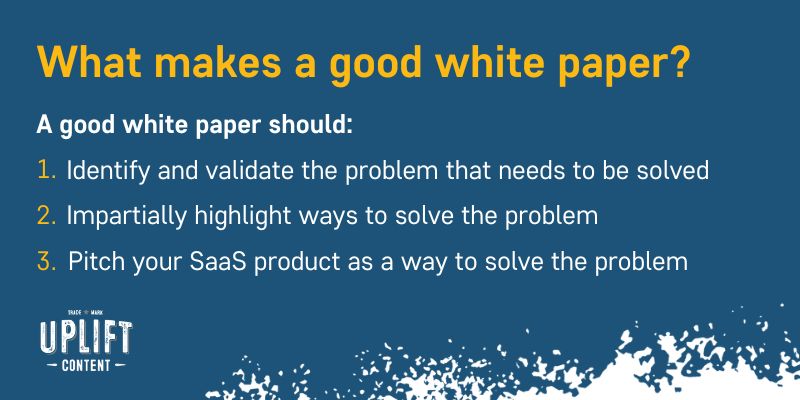
Before you figure out how to write a white paper that drives sales, do you know if a white paper is the right choice? Maybe you’re debating whether you should write a white paper vs ebook .
White papers are research-heavy reports that position your company as a thought leader in the industry. They provide new or unique information on a specific problem and solution.
White papers also tend to dive deep into a narrowly defined topic and use evidence-based research to support the ideas and arguments. Most white papers are led by text and supplemented by diagrams or graphs for greater comprehension.
eBooks also have the goal of educating their audience, except that they’re often written in a more casual tone and include more design elements and white space. This delivers more digestible chunks of content for a lighter read.
eBooks are created with both eye-catching graphics and easy-to-read text so prospects can read and understand them easily.
So which is right for you?
Whether you choose a white paper or an ebook depends on your specific goals. eBooks may be better for providing general “how-to” information or getting people excited about the topic with a brief intro, while white papers are better suited for providing technical and detailed analysis on a specific topic.
Read our post: White Paper vs eBook: Which One Should You Create?
It’s a good idea to consider whether your content goals would be better supported by a white paper or case study before creating either type of asset. Both formats can be very effective, but there are a few key distinctions.
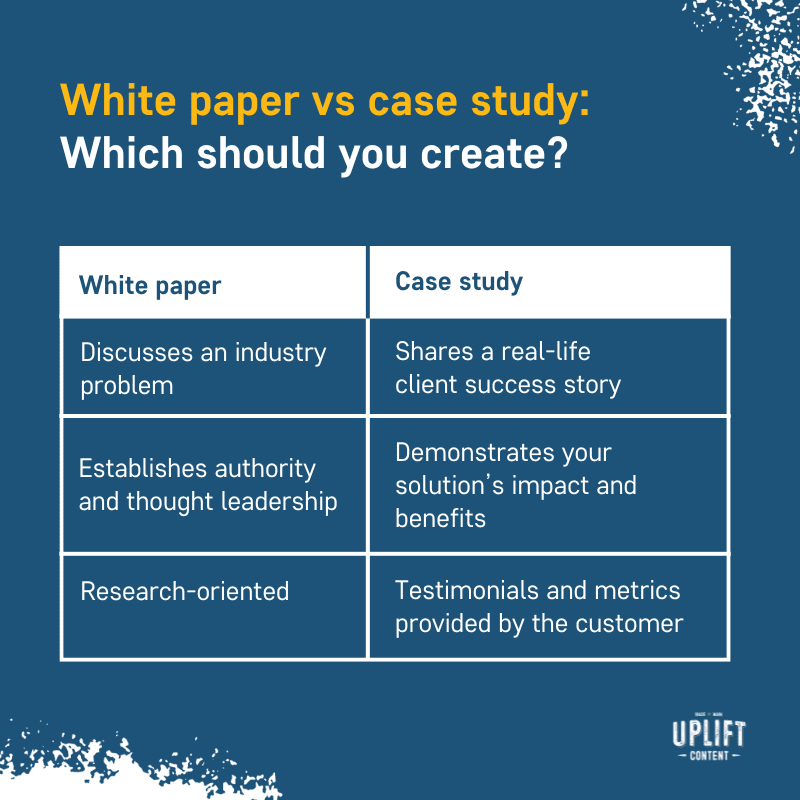
White papers offer new insights or suggestions about a particular topic in your industry. They are data-driven and research heavy.
White papers are meant to position your company as a thought leader and industry expert. Most white papers are gated, so they help you gather leads.
Case studies provide an in-depth look at why and how a customer implemented your solution. They offer success metrics to show the impact of your solution and may discuss the implementation process to demonstrate ease.
Case studies help alleviate concerns that might be keeping potential customers from signing up for your solution. They are rarely gated, as they can play a significant role in encouraging would-be customers to sign up.
To learn more about these content formats and figure out which is best for your content goals, check out our post on the differences between case studies and white papers.
Read our post: White Paper vs Case Study: What’s the Difference?
Rarely are B2B buyers ready to purchase after reading a single blog post or watching a product explainer video. This is especially true for enterprise clients. They need to build trust with your brand and understand how your solution will help solve their particular pain point.
White papers rank among the top content formats for B2B buyers, especially in the early and middle stages of the funnel, according to the 2023 Demand Gen Report .
When researching a solution, buyers gravitate to white papers because they want to validate the legitimacy of a solution through use cases and analytical data. White papers help develop thought leadership and move prospects through the sales funnel.
White papers are also highly shareable. Content packed with quick-hitting facts and shareable stats are the number one driver for sharing content . When passed along to the C-suite, white papers can help influence stakeholders on the purchasing team.
In SaaS marketing, 8 types of white papers exist. Some serve as how-to guides providing step-by-step instructions, while others function as industry reports that deliver valuable insights and in-depth analysis. When learning how to write a white paper that drives leads, choose which type of white paper to use based on your goals and objectives for the asset.

1. How-to or problem/solution white paper
How-to or problem/solution white papers call out a nagging business problem and provide a new and improved solution. Use this type of white paper to attract and educate prospects, usually in the consideration stage of the buyer’s journey. Your audience knows they have a problem and is researching solutions to overcome it.
2. Technical white paper
Technical white papers explain the technical aspects of a product and how it solves a problem. They’re tailored to tech-savvy audiences and feature elements such as technical specifications, flowcharts, tables and diagrams.
3. Business benefits white paper
Business benefits white papers focus on showcasing the specific advantages of a product. Unlike technical white papers that explore the working details of a solution, business benefits white papers focus on the big-picture business outcomes. They’re geared toward decision-makers and non-technical audiences. Sometimes, they provide a cost-benefit analysis and potential ROI to justify the value of the solution.
4. Market research white paper
You may have seen white papers titled “The State of…,” which offer big-picture insights into specific industries. For instance, an IT security company might create a market research paper called “The State of Cybersecurity: Threats, Challenges and Best Practices.” These papers delve deep into the industry’s latest trends, showcase what’s effective and address current challenges.
5. Visionary white paper
Unlike market research white papers which focus on the current state of an industry, visionary white papers project out into the future. Visionary white papers are typically titled “The Future of…” These white papers are best for top-of-funnel prospects that want to learn more about the industry, or high-level professionals who want to stay up-to-date on predictions and trends.
6. Product comparison white paper
Product comparison white papers compare multiple products in a specific industry. Marketers use them strategically for the Decision Stage of the buyer’s journey when the prospects know they need a solution, but need help deciding between a few vendors.
7. Educational white paper
Educational white papers are designed to teach your audience something new. Since these white papers are grounded in factual evidence, you should dig into industry reports when doing your research.
8. Thought leadership white paper
Thought leadership white papers present original viewpoints that often go against conventional wisdom. The goal is to demonstrate expertise, establish credibility and gain influence, particularly among decision-makers or executives. You can put a spin on current issues or take a new approach to address your audience’s pain points.

When crafting a white paper, it’s helpful to adhere to a white paper structure that sets the stage for the proposed solution. Here are the 9 elements you’ll want to include when formatting a white paper:
1. Title page
Create an attention-grabbing title that highlights the problem you’ll solve or the topic covered in the white paper. Make it intriguing enough to entice readers to share their email addresses.
2. Introduction and problem statement
Explain the purpose of your white paper and why your target audience should read it. The introduction describes the business problem your technology solves from the perspective of your target audience. It should be interesting enough to hook readers right away and keep them reading.
3. Background
Here’s where you can provide in-depth background information on the specific problem you’re discussing. This section is usually data and research-heavy. Dig into why the problem is a growing concern in the industry and what detrimental effects it may be having on the readers’ businesses.
4. Proposed solution
This is the meat of your white paper. This section should propose a solution to the stated problem, typically a course of action, product or service. For SaaS companies, that means describing your technology and how it solves your audience’s pain point. It may also compare your solution with competing technologies.
5. Graphics and other visual elements
Nobody enjoys reading a wall of text. White paper design is important because white papers are much more engaging when you add visual elements like charts, tables and infographics. People retain information with visuals better than text, so using graphics is a great way to summarize your points in a digestible manner.
6. Fact-based evidence
Facts help to support your argument and reinforce why you believe something is true. Statistics, metrics and quotes can add context to your points, highlighting the importance of a problem or the effectiveness of your solution. Sprinkle in facts to help bolster your position.
7. Conclusion
Wrap up with the most important points that you want your readers to remember. It should summarize the white paper’s findings and recommendations. Also, emphasize the benefits of your solutions and the risks to readers who don’t take action on resolving the issue. Conclude with the most important points that you want your readers to remember.
8. Call to action
Add a call to action (CTA) to encourage readers to take the next step, whether that be booking a demo or signing up for a free trial. Frame it as a way to start solving their problems. Even the most fact-based research white paper should include some form of CTA to help readers take the next step.
9. About the vendor
The About section is where you can openly sell your solution. Clearly state what your technology does, who it helps and how. You can add another CTA at the end of this section. While there’s no rigid white paper format you need to follow, these guidelines will provide a good starting point.

Now that you know the white paper structure to aim for, let’s get into the step-by-step process of how to create a white paper for your SaaS company.
- Know your audience
- Strategize and plan
- Narrow your white paper topic
- Offer a unique point of view
- Do your research
- Create a white paper outline
- Write and edit your white paper
- Coordinate reviews and approvals
- Draft supporting content
- Design the white paper
- Promote your white paper
1. Know your audience
When thinking about how to write a white paper, the most important step is making sure you know who you’re writing for.
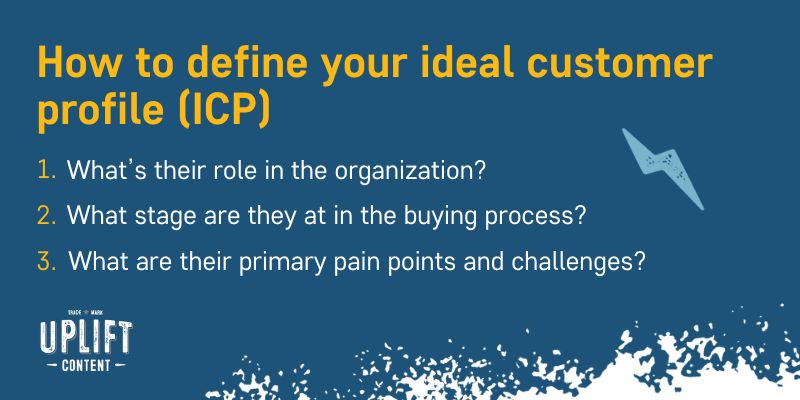
You can define your ideal customer profile (ICP) by asking a few questions:
- What’s their role in the organization? Decision-makers wear multiple hats. Know their job title and company size and tailor your white paper content accordingly.
- What stage are they at in the buying process? Prospects in the Awareness Stage know they have a problem but don’t yet have a solution. Prospects in the Consideration Stage are looking at different solutions. Lastly, prospects in the Decision Stage are ready to buy and looking for reasons to choose your product.
- What are their primary pain points and challenges? Really knowing your prospects’ pain points and challenges enables you to write a white paper that is valuable to them—and one that they’re willing to give you their email address for.
2. Strategize and plan
Figuring out how to write a white paper is all about landing on a great white paper topic . Sit down and brainstorm ideas for your white paper. What is it that your ideal customers want to know? What will help them solve a burning problem?
If you’re stuck for topic ideas, you can turn to a ready source—anyone in your company who speaks directly to customers or prospects. For you, that may be any employee from:
- Marketing
- Partnerships
- Customer service
- Technical support
Your sales department is having targeted conversations with prospects every day. Common questions and pain points come up on these calls every day.
And the conversations don’t have to be a one-way street, either. Run some white paper topics by a focus group panel or your customer advisory board and see which topics intrigue them the most.
3. Narrow your white paper topic
Prospective clients generally prefer topics that are more specific. Topics that are too broad dilute the overall effectiveness of the information. And don’t try to cram everything into one white paper. Instead, focus on the most important and relevant points.
If you know exactly who you’re writing the white paper for and how it fits into your content strategy , it should be easy to narrow your topic. If you want to generate leads in a specific vertical, you may focus on the topic of a new approach to a common industry challenge. However, if you want to support a new product launch, you may decide to discuss the technologies underlying your new solution.
Read our blog post: White Paper Topics: How to Choose the Right One to Generate More Leads
4. Offer a unique point of view
You want to avoid rehashing the same tired information as everyone else. Nobody gets excited about a white paper that covers the same topic as your competitors. This might seem like a no-brainer, but when thinking about how to write a white paper, you need to provide a fresh perspective.
With so much content vying for your prospects’ attention, many companies struggle to stand out. Taking a stance that goes against conventional wisdom can help you win raving fans. Specifically, taking a stance that aligns with the buyer’s values can help to establish credibility and trust.
Even SaaS companies can create a brand identity around their values and causes. For example, Square and Stripe turned the payments industry upside down by creating online payment software tailored towards small businesses. Previously, small businesses relied on traditional merchant accounts that involved high fees, lengthy contracts and complex setups.
Consider what your brand stands for and how it’s different from competitors. For example, how do you solve a problem differently than anybody else?
Think about how to demonstrate your expertise in a way that encourages conversation. Often this unique point of view can come from the subject matter experts you chose to interview. Be sure to create a fully fleshed-out content brief so everyone is on the same page.
5. Do your research
The best white papers come from extensive research. If you want to establish your company as an authority and gain the trust of your target audience, you’ll want to base the claims you share on credible sources.
First, determine where you might find the information you’ll need for the white paper. That will determine the research methods you’ll use. If you’re doing interviews, schedule them at least a day apart so you have time to prepare, as well as digest the information afterward.
You likely have an in-house SME that you can interview, such as a product developer, data analyst or CEO. However, sometimes you may want to find external industry experts or advisors to contribute their knowledge.
When performing secondary research, read industry reports and other white papers on your topic. See what influencers have written about on the topic. Reading will help you discover content gaps and unique approaches your white paper can take. Keep all research material in a single folder.
Be sure to find credible sources for your white paper. Using industry reports, journal articles and publications are great sources.
You can also perform surveys with your customers, which allow you to collect opinions and data on specific topics related to your industry. For example, a project management company can collect specific data from its B2B clients to prove its effectiveness and success rates of completion.
Once you’ve completed your research, be sure to create an outline. Don’t skip this step—it will help you stay more focused and save you time in the long run. Allow your manager and an SME to check that your outline is on track to meeting everyone’s expectations for the white paper.
6. Create a white paper outline
A detailed white paper outline is key to producing a white paper that is compelling and cohesive. Since this type of asset contains so many points, you’ll want to create your white paper outline in several steps to ensure that each section is well-organized and adequately supported by research.
A. Land on a working title or two
You have two primary opportunities to convince your prospects to download your B2B SaaS white paper: the title and the cover. It’s crucial that these elements make a powerful impact. Use your white paper outline to capture a few ideas for persuasive, benefit-driven titles.
B. Brainstorm insights and actionable takeaways
Ask yourself what you want your readers to gain from your white paper, then write down everything that pops into your mind. This section of your white paper outline doesn’t have to reflect your final draft. Rather, this exercise will help ensure that your content covers all the information you want to share with your audience, including educational insights and tips they can put into action immediately.
C. Lump ideas into sections
Your next step is to structure your brain dump into sections. This will help you identify a few major themes for your B2B SaaS white paper. Once you’re finished, if you feel like your topic is too broad, cut any themes that don’t support the main focus of your white paper.
D. Fill the gaps in each section
Review each section in your white paper outline to see what’s missing. Think about this from your prospect’s perspective. Include statistics to help illustrate the points you’re trying to make. Ensure that every question your reader might be wondering has an answer.
E. Edit and organize each section
Now that you’ve put all of the details around your major themes into your white paper outline, it’s time to edit your outline. Step away from your white paper for a while and return to it with fresh eyes to see if you can tighten up the content and ensure it flows as logically as possible without any redundancy.
F. Add links to source material such as data
Statistics help make your white paper as compelling as possible, and they support your credibility by showing that you use research from reputable sources. Add links to these sources to your white paper outline. Stats make great graphic design elements later down the road in the white paper production process.
G. Get feedback from subject matter experts
Get a few sets of eyes on your white paper outline. Subject matter experts and other key stakeholders will likely have valuable feedback to offer that can improve your content. They can help you spot any gaps in information or point out confusing sections that require explanation. They can also provide feedback on the flow of your white paper outline.
6. Write and edit your white paper
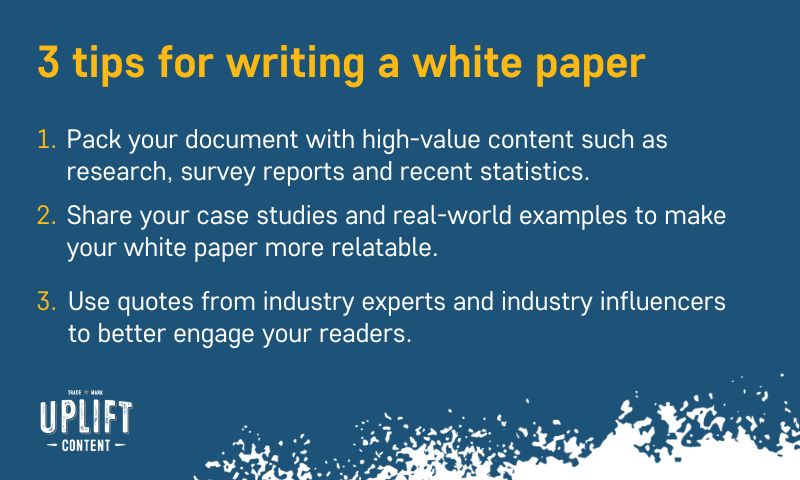
Once your colleagues approve the outline, you’re ready to flesh out your SaaS white paper. Here are 3 quick tips to consider:
- Valuable content: Pack your document with high-value content such as research, survey reports and recent statistics.
- Examples: Share your case studies and real-world examples to make your white paper more relatable.
- Quotes: Use quotes from industry experts and industry influencers to better engage your readers.
Once you’ve completed the first draft, you should step away from your computer for at least 24 hours. Fresh eyes can help you rethink, rewrite and polish your work. Do this a few times until you’ve nailed it.
Edit the white paper for logic, key messages, grammar and style. Often, you’ll need to eliminate buzzwords and hype, improve readability with simpler language or make the text more crisp and compelling. Make every word count—avoid padding it with flabby writing or lazy thinking.
Even the best writers need editors. Get a co-worker or editor to provide a fresh pair of eyes on your work. This can help you catch mistakes you didn’t see or provide a different perspective to strengthen your writing.
7. Coordinate reviews and approvals
Reviews and approvals always take longer than you might think, so make sure you set aside enough time in the project timeline. Before the project even starts, you should determine exactly who will be reviewing and approving the SaaS white paper.
Review by committee is tedious and tough. Conflicting opinions and personal preferences can dilute the original message and cause the review process to go on for far longer than it should. Aim for no more than 3 stakeholders to be involved in the review process. Set firm deadlines for review and approval cycles.
You’ll have a smoother content approval process if you set up the following in advance of starting the white paper:
- Brand guidelines: Brand guidelines ensure your white paper aligns with your brand identity, maintaining consistency across all marketing collateral. This is especially important to pass along to a SaaS content marketing agency if you decide to outsource the white paper writing.
- Content brief: Your content brief should state the content goals, audience and a rough outline for the white paper. Be sure to create a fully fleshed-out content brief so everyone is on the same page.
- Editorial style guide: This is one of the most important documents during the writing and editing phase. It includes standards for tone, grammar, images and vocabulary.
- Workflow: Use a project management tool to easily assign tasks, set deadlines and move the white paper through each stage to completion. The tool allows all team members to see where the project is at and ensures that the white paper gets completed on time.
Once your white paper gets final approval, you’re ready for publishing.
8. Draft supporting content
Opt-in pages are the entry point to gated content like white papers. However, so much can go wrong with the opt-in page that you may never collect your prospect’s email address. If you want to increase downloads, make sure you include 6 crucial elements in your opt-in page .
When designing your opt-in page, make sure to place the unique value proposition, form and call to action above the fold. This helps readers take the desired action without having to scroll.
Hook readers by driving curiosity with a compelling headline that explains the main benefit of downloading the white paper. In the body of the opt-in page, you can add short bullet points to tell them what they’ll learn in the white paper.
The thank you email and thank you page should include a link to the downloadable white paper, along with the next step you’d like prospects to take, such as booking a demo call or signing up for a free trial.
9. Design the white paper
Appearances matter. Get your designer to create a memorable white paper design that is professional and easy to read—and plays into your branding.
If you’ve got some interesting data, don’t bury it in dense paragraphs. Instead, present it using visually engaging charts, graphs and infographics to captivate your audience and make the information more digestible.
Read our blog post: 5 White Paper Design Best Practices to Strengthen Your Credibility
When designing the graphics, you’ll need to know what types of graphics will best highlight your research. Start by defining your visualization goal for each graphic:
- Inform: Convey an important data point or message that doesn’t require much context to understand
- Compare: Show differences or similarities
- Show change: Visualize trends over time
- Organize: Categorize data to show trends
- Reveal relationships: Show correlations among variables
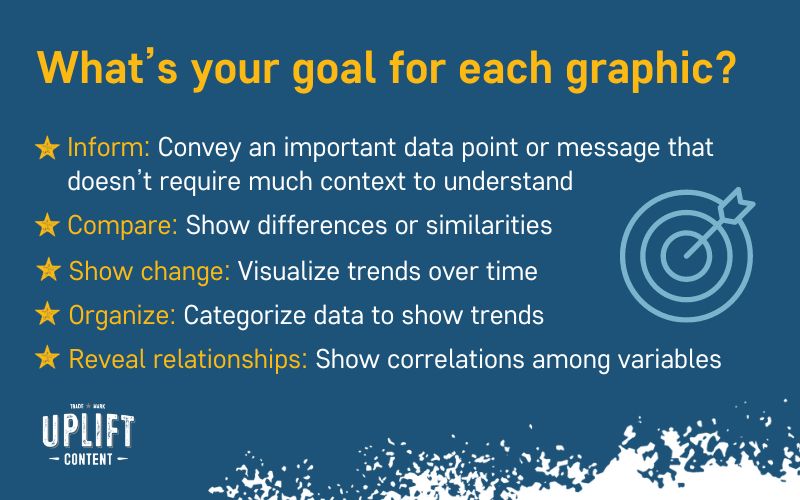
The types of visuals you use depends on the purpose. For example, horizontal bar charts are great for charting survey results. Or you can use infographics as a way to tell a story using facts and statistics. Even adding icons with corresponding text is a great way to make the information easier to read.
If you don’t know how to design a white paper, we recommend reviewing the white paper examples below for inspiration.
Read our blog post: White Paper Templates: 5 Tools to Create Engaging Designs
10. Promote your white paper
Now you know how to prepare a white paper, but do you know how to promote it? A SaaS white paper isn’t valuable unless the right people see it, download it and read it.
Think about how you will use owned channels (like your website, social media and email) and external channels (like conferences, advertising and public relations) to get your white paper in front of people.
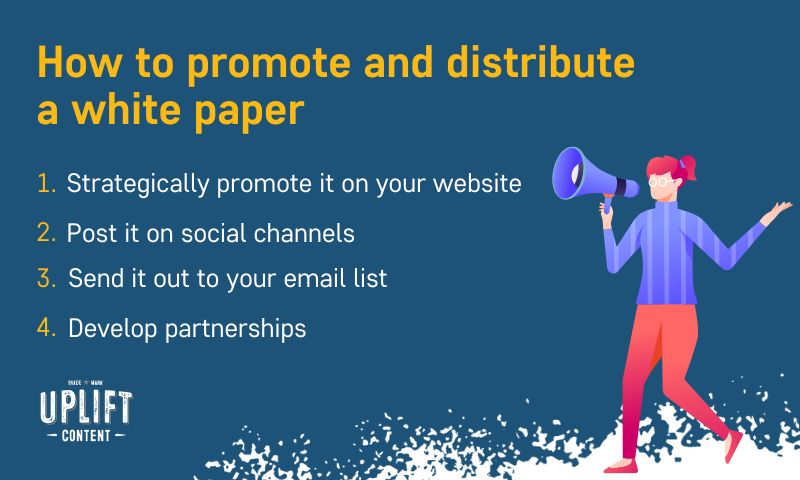
Here are some tips to promote and distribute a white paper :
- Strategically promote your white paper on your website: You should place the white paper in spots on your website where it makes sense as part of the buyer’s journey. Ask yourself when your target audience would be ready for this information. Consider adding it to the Resource section of your website or as a CTA at the end of related blog posts.
- Post it on social channels: Your audience is probably scattered across various social media channels. Create a series of posts focused on key ideas from your white paper. Remember, white papers can be repurposed into different formats—blogs, tweets, social posts, slide decks and even sales material.
- Send it out to your email list: Email marketing has stood the test of time and shows no signs of slowing down. Send a teaser email to your mailing list to build anticipation of the white paper before it’s published. Once published, you can include it in your newsletter or email nurture sequences. You can even have customer-facing team members include it in their email signatures to get it in front of your target audience.
- Develop partnerships: Leverage relationships with content marketers and journalists in your network to include links to your paper from their content. Perhaps, you’ve got original research that would fit perfectly to their content. Send them an email to see if they’ll include a link to your research into their blog content or an article.
Never forget to promote and distribute a white paper. Content that gets lost in the shuffle results in lost opportunities and time that could’ve been spent elsewhere.
Read our blog post: How to Promote a White Paper for B2B SaaS [8 Ideas]
6 mistakes you should avoid when writing a white paper
Many SaaS companies fall victim to common mistakes when writing a white paper, which can derail a stellar piece of content and turn off your readers. The good news is you can write valuable white papers by avoiding these costly mistakes.
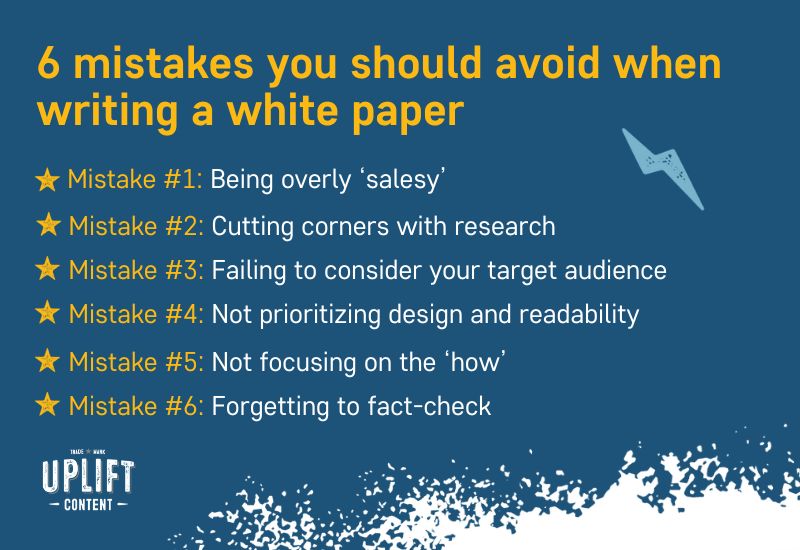
Mistake #1: Being overly ‘salesy’
White papers use facts and logic-based evidence to prove a point. If the white paper is too salesy, readers will tune out once they realize it’s a marketing pitch. They’ll question the objectivity and credibility of the content, leading to a loss of trust. Instead, present a vendor-agnostic view of the problem and solution, and support claims with factual evidence.
Mistake #2: Cutting corners with research
The worst thing to do when writing a white paper is to slap in a few stats you find on Google and call it a day. A bunch of Google searches aren’t going to bring you any new insights on the topic. Not only that, repurposed statistics are blatantly obvious and can instantly undermine your credibility.
Use a combination of primary and secondary research instead. Industry reports are trustworthy sources that add credibility. Primary research brings life to your white paper. Consider leveraging interviews, surveys and focus groups to gather unique and original data points.
Mistake #3: Failing to consider your target audience
White papers are meant to address specific industry challenges, provide solutions and offer valuable insights. If you don’t understand your target audience, you may miss the mark on addressing their needs.
You can make your white paper more relevant by keeping your ideal customer profile (ICP) front and center when choosing a topic, figuring out what subtopics to cover, doing your research and writing the white paper.
Mistake #4: Not prioritizing design and readability
Most people won’t read your entire white paper word for word. The key is to make your white paper scannable so that readers can still get the gist of your complex ideas without reading the entire document.
Visual elements can help you tell a story with only a few words. Line graphs are great for showing comparisons, trends or patterns, while infographics help to summarize key ideas.
Also, use headings, different size fonts and graphics to break up your white paper. This makes your document more easily digestible. With plenty of white paper templates out there, there’s no reason not to have a visually appealing white paper design .
Mistake #5: Not focusing on the ‘how’
Placing too much emphasis on research findings is another mistake. Many white papers will stay in the realm of theory without covering how to use those findings on a practical level.
For example, there are endless white papers discussing the importance of employee engagement. But very few give concrete strategies and examples in specific verticals to help the reader solve their problem.
Mistake #6: Forgetting to fact-check
For your white paper to have its intended effect, it’s important to establish your content as a credible source of information. Spreading false or misleading information will cause you to lose trust and could have legal ramifications.
You can verify statistics and quotes by ensuring you cite the original sources and that they’re accurately represented. Also, check that they’re cited from reputable sources and not just a random blog post from the internet.
The best way to write exceptional white papers is to learn from successful ones. Pay close attention to their structure, design and how they infuse storytelling to persuasively argue their points.
Here are 4 white paper examples to learn from:
1. Databricks – Getting started with unstructured data

This white paper from Databricks gives B2B tech professionals plenty of real-world examples of how a structured data strategy can be used in businesses.
Many tech solutions aren’t so “obvious” to new users. But by giving concrete examples of how customers can use your solution in a non-salesly way, you can nudge readers down the sales funnel toward a purchase.
2. Snowflake – Design patterns for building multi-tenant applications

This Snowflake white paper compares 3 ways to organize data for customers using one of the Snowflake products.
The white paper provides clear recommendations to solve a specific problem. Giving clear recommendations can help tech buyers in the buying process because they often highlight the functionalities or features most relevant to the buyer’s use case.
The white paper also uses workflows and charts to visually demonstrate the solution.
3. ActivTrack – Manager’s guide to productivity measurement

This ActivTrack white paper takes an educational approach by focusing entirely on giving value and only subtly promoting its product at the end.
The white paper includes plenty of visual elements with minimal text to summarize the key points of the section. This allows readers to quickly scan the document and get the gist of what is said.
4. AeroSpike – Streamlining data architectures for IoT analytics

AeroSpike sets the stage in this white paper by describing the importance of scalable and reliable data structures. It uses practical examples, such as connected healthcare for diabetes management and smart city initiatives, to showcase real-world applications of IoT and data architectures.
At the end of the white paper, AeroSpike presents its product and its benefits. It talks about how AeroSpike is a high-performance database that can handle the issues described in the paper.
Want more white paper examples?
Check out our white paper examples post for 9 more examples, plus quick descriptions of their strengths. We’ve even organized the white paper examples by target audience, making it easier to identify patterns and determine which elements your target audience is looking for.
Read our blog post: 9 White Paper Examples to Inspire Your Next White Paper
Should you gate your white paper?
Gating your white paper is great if you want leads, but there are some drawbacks as well. If your target audience has to provide their email address to access your white paper, fewer people will see it since not everyone is willing to give up their email addresses for a piece of content.
If you don’t gate your white paper, you’re making the white paper barrier-free so more people are likely to read it. And by creating the white paper in HTML, rather than as a PDF, you can optimize the white paper for search and get traffic organically.
When making the decision of whether or not to gate your white paper, it’s important to get really clear on your primary goal for the content asset. Are you trying to generate leads? Or are you trying to get the information in front of as many prospects as possible and grow your brand awareness?
How long should a white paper be?
Based on our research, white papers are typically 2,000 to 4,000 words in length, but the range can vary significantly by target audience. After all, a chief operations officer (COO) will typically need a different breadth of information than a marketing manager.
To learn more about the different types of white paper audiences and their content needs, check out our post on white paper length.
Read our blog post: How Long Is a White Paper?
How many pages is a white paper?
White papers should at least be 6 pages long, but on average are between 10 to 12 pages. Gone are the days of lengthy 30- to 50-page documents. Today’s time-pressed tech buyers and executives want shorter white pages. This is just enough content to cover a specific topic in-depth without losing readers’ interest.
What does it mean to write a white paper?
Writing a white paper means crafting an authoritative document that uses logic and facts to promote a recommended solution to a problem. Technology buyers want to educate themselves on their problems and potential solutions before they can evaluate or justify a purchasing decision. Businesses offer white papers as downloadable content on their websites to generate leads.
Can anyone write a white paper?
No, not anyone can write a white paper. To write a white paper, you need to be a strong writer and have experience in a particular topic or consult with subject matter experts. White papers are perceived as highly authoritative documents supported by research and data. As a writer, you need to understand the target audience’s pain points and possess the expertise to present information convincingly.
How many hours does it take to write a white paper?
Generally, it takes 20 to 40 hours, spaced out over 6 to 8 weeks, to complete a white paper. Writing a white paper is an extensive process that requires conducting thorough research, interviewing SMEs, writing the draft and collaborating with other stakeholders for input. Hiring experienced SaaS content writers can expedite the process since they can produce better quality work in less time, minimizing the need for extensive revisions.
If you’re anything like our other SaaS customers, you’re probably slammed. We’re here to help. Check out our white paper writing service .
6 Elements of a High-Converting Opt-In Page Learn how to craft an opt-in page that drives downloads of your B2B SaaS lead magnet.

As the founder of Uplift Content, Emily leads her team in creating done-for-you case studies, ebooks and blog posts for high-growth SaaS companies like ClickUp, Calendly and WalkMe. Connect with Emily on Linkedin
Sign up for the Content Huddle newsletter
Learn from Emily’s 17 years of aha moments, mistakes, observations, and insights—and find out how you can apply these lessons to your own marketing efforts.
You can unsubscribe any time. Visit our Terms of Use for information on our privacy practices.
The 2024 Ultimate Guide: How to Write and Format a White Paper
The step by step guide to succeeding with white paper marketing.
.png)
- 1 What is a white paper?
- 2. White paper examples
- 3 How to write a white paper
- 4 Mistakes a white paper should avoid
- 5 White paper Format
- 6 Gating your white papers
- 7 White paper distribution
- 8 Handling your white paper leads
- 9 Choosing the right white paper template
- 10 Final thoughts
Introduction
White papers are a popular and powerful tool for content marketers. They can be used to position your company as a thought leader and authority on a particular topic by presenting useful and persuasive research findings and technical information about your products and services.
White papers can also be used as a powerful asset to generate more leads when the information is valuable enough for readers to submit their personal details in order to access your findings. This ultimate guide will teach you everything you need to make white paper marketing a formidable addition to your content marketing strategy .
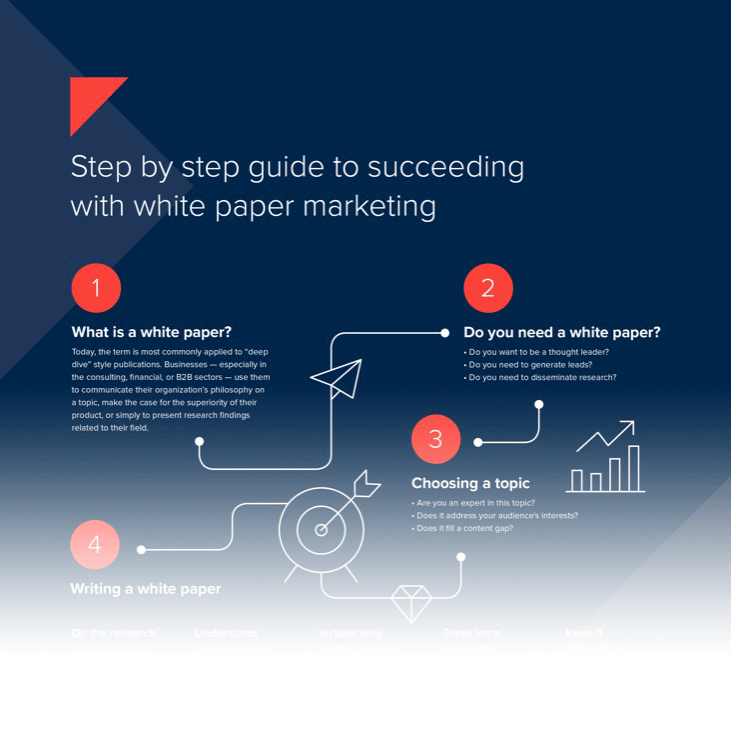
1. What is a white paper and why is it important?
A white paper is an in-depth report or guide informing readers about a specific topic and its problems. It is meant to educate readers and help them to understand and solve an issue. It is important as it helps establish a company as an expert in its field, educates customers, and influences decisions.
In the world of marketing, a white paper is a long-form piece of content , similar to an eBook . The difference between the two is that white papers tend to be more technical and in-depth. The facts and opinions expressed in white papers are often backed by original research or statistics that the publisher has aggregated from reliable sources. They often include data visualizations such as charts, graphs, tables, and more.
The term "white papers" originated in England as government-issued documents. One famous example is the Churchill White Paper , commissioned by Winston Churchill in 1922.
Today, the term is most commonly applied to “deep dive” style publications for marketing purposes. Businesses — especially in the consulting, financial, or B2B sectors — use them to communicate their organization’s philosophy on a topic, make the case for the superiority of their product, or simply to present important points related to their field.
White papers are no less editorial than other forms of content, but the depth of research lends them an authoritative tone. For this reason, they are good candidates for promoting thought leadership .
Who uses white papers?
In the past, white papers were most often produced by governmental agencies, NGOs, think tanks, consultancies, and financial institutions that needed to present the findings of their ongoing research in a succinct format.
With the widespread growth and adoption of content marketing (the creation and distribution of non-promotional content intended to generate interest in a business and its offerings), white papers have become more common in other industries as well. Any organization that engages in content marketing can benefit from producing white papers.
Their popularity across industries is due to their versatility. While all white papers have certain elements in common, a B2B startup will use them differently than a large consultancy, and both will use them differently from a governmental organization.
Types of white papers
There are numerous types of white papers a business might publish.
- One type is the backgrounder , in which the benefits of their product, service, or methodology are explained in depth.
- Another is a problem-solution approach, which walks the audience through the solution to a problem that is common in their industry.
Other types of white papers simply present a summary of useful statistics and information about the state of a particular field or industry. An example of this would be the Content Marketing Benchmarks Budgets and Trends from the Content Marketing Institute.
Whatever type you produce , the contents of your white paper should serve to showcase your expertise in a given area. Your audience is searching for an information document and will look for an authoritative source — a business they perceive as having in-depth knowledge of a subject.
The contents of your white paper should serve to showcase your expertise in a given area.
How can a white paper benefit businesses or organizations?
White papers enable you to build trust with your audience. They show readers that you're reliable, experienced, and adept in a given domain. When potential customers search for an informational document to help them understand a problem or opportunity they're facing, and you provide them with a quality white paper that helps, they'll turn to you again in the future.
This perception of authority can also serve to boost sales in an organization. More than half the respondents to the Eccolo Media B2B Technology Content Survey reported having read a white paper before making a buying decision. Buyers prefer to purchase from vendors they trust and see as experts in their field.
Finally, white papers are extremely useful for lead generation . The Content Preferences Survey from DemandGen found that more than three-fourths of survey respondents were willing to exchange personal information for a white paper — more than for eBooks , case studies, analyst reports , podcasts, brochures , or infographics.
With all of these potential benefits, utilizing white papers in your content marketing strategy can produce great results.
More than three-fourths of survey respondents were willing to exchange personal information for a white paper.
2. White paper examples
When you think about white papers, you probably think of PDF articles with thousands of words. But times are changing and so is the way we produce and consume content.
Nowadays, every marketing collateral (including white papers) needs to be well-written, well-structured, and designed for every type of visitor.
Here are some great examples of white papers doing exactly that.

This unique one-pager presenting findings from the Developers at Work Survey demonstrates how a white paper should be done. The animated, interactive data charts show off just what's possible with our embed feature .
Open white paper example #1

Privacy and the GDPR - BDO
This well-produced special edition produced by BDO and creative agency Monte Media does an incredible job of turning a conventionally dull topic into a piece of content that's engaging and comes to life.
Open white paper example #2
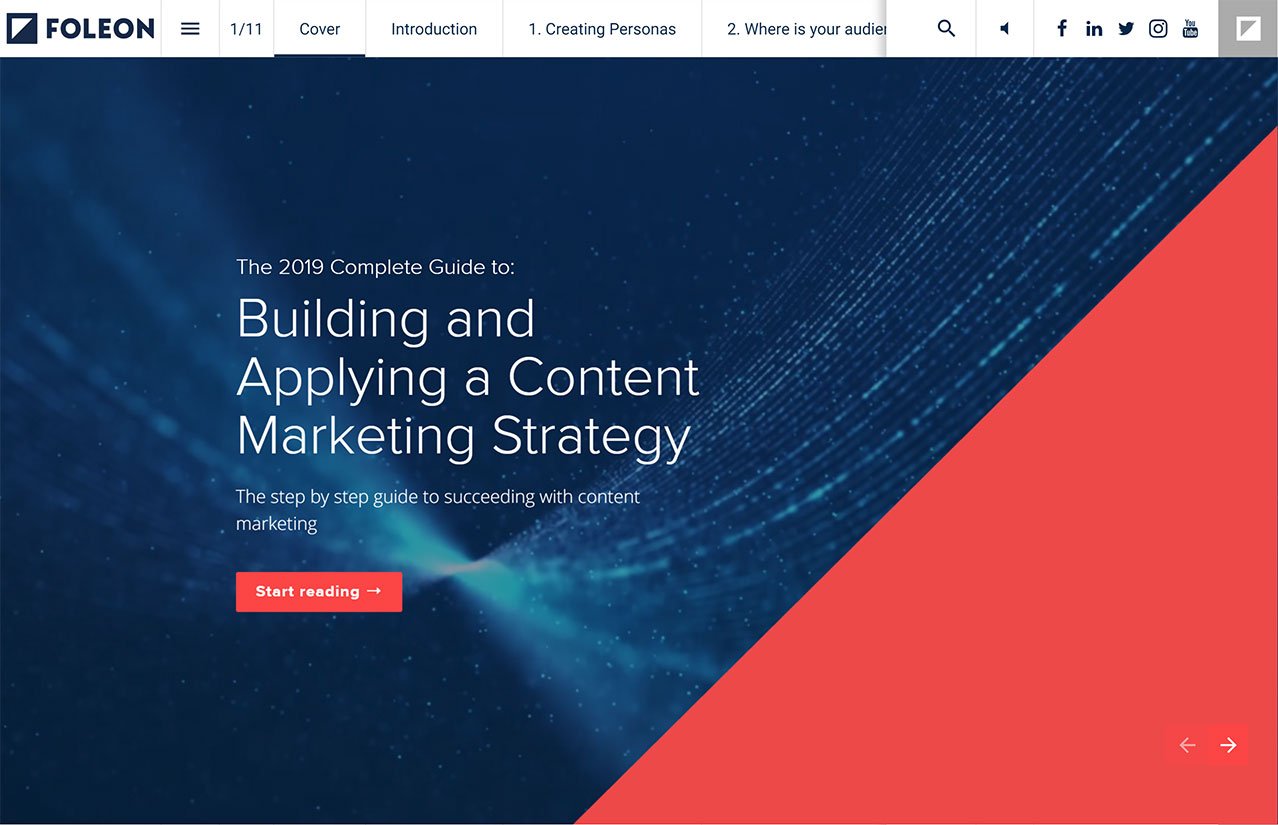
This white paper is a step by step guide to succeeding with content marketing.
See more white paper examples
Start creating white papers with Foleon
3. How to write a white paper
Starting a white paper can be a daunting task. So much information and research are required that it’s easy to get lost in that portion of the work and let it become a roadblock to actually putting things on paper.
Even after the writing itself has begun, white papers are tricky to do well. Simply listing statistics without some form of narrative arc is a surefire way to keep your white paper from ever being read. Luckily, following a few simple guidelines can help keep a white paper engaging and make the process of finishing it much easier.
Pick the right topic
This might seem obvious, but without a topic that resonates with your audience, your white paper is not likely to be read. When choosing the right topic, you should consider three important criteria:
- It should be something you are qualified to write about.
- It should be something your audience is interested in.
- It should address a topic around which little content has been written already and thus fill a " content gap ."
Naturally, finding a topic that brings points 1 and 2 together is vital. White papers are meant to be authoritative pieces of content based upon the author's experience and expertise, so it's important to write about what you know . But you must match this to the interests of your readers if you're to produce something they'll be eager to engage with .
Don't be afraid to crowdsource information from within your organization. If the topic of a white paper is related to engineering, why not interview an engineer or have them look over what you’ve written? The same goes for other roles. Crowdsourcing knowledge means having the power of a true expert in many fields.
Finally, filling a "content gap" will help your white paper get noticed and gain traction. By addressing a topic no one else has written about definitely, your white paper will be more likely to rank highly on search engines and even be featured elsewhere on the web.
Pro tip: You can even ask your audience what they would like to see in your upcoming white paper. You'll get ideas, make your topic more relevant, and you'll generate buzz around your content even before it's finished. In fact, we used the same method for this guide!
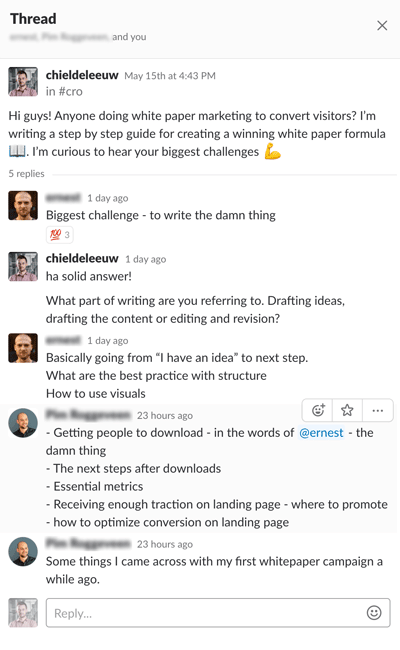
Define your audience
Defining your audience goes hand in hand with choosing the right topic. But moving beyond your audience's interests, it’s important to think of the kinds of people who will be reading your white paper.
- Are they fellow professionals, well versed in your subject?
- Are they likely to be reading something they are relatively unfamiliar with?
Knowing this helps establish the voice you should use and whether industry-specific jargon is appropriate. It also narrows the scope of the research you should include. It’s always important to ensure all arguments are logically sound and well supported, but the stats and information presented should be relevant to the specific audience you're targeting.
Part of defining an audience in the age of Google centers around how people will find the white paper. This means thinking about which platforms specific personas use for research and what search terms they put in. Not only will this help a white paper get found by the right people, but it is useful when outlining the white paper later on.
Optimizing for keywords is important, but remember to write for people, not for search engines. Google is getting better all the time at understanding and matching search intent with relevant content . This has become particularly important with the advent of AI-powered language models which can produce long-form content at scale.
Wrap it in a great intro and outro
Ad with all good writing, your intro should serve to captivate your audience, pique their curiosity, and entice them to read further. It's good practice to provide a brief summary of what they'll find in the white paper and to emphasize exactly what benefit they'll get from reading it.
Your outro is equally important, especially if you're using your white paper to market your products or services. You should avoid any self-promotion in the body of your white paper, but you can certainly mention your relevant product offerings and how to obtain them — perhaps using a compelling call-to-action — at the end.
Pack it with value
White papers are not meant to be advertisements for your company, and you should avoid any overt promotion. Instead, you should provide plenty of useful information that will be valuable to readers even if they don't become customers. Emphasizing value is the key to a great white paper that will get shared and widely read.
Remember, white papers serve to showcase your expertise as a company or brand in a given field. Your readers should come away having learned something useful and with the impression that you're a reliable source of expert information. As pointed out earlier, generating this kind of reputation will lead to greater business success as buyers are more likely to purchase from companies they trust.
Emphasizing value is the key to a great white paper that will get shared and widely read.
Don’t be scared of multiple drafts
No first draft is ever a finished work. Elizabeth Bishop, the renowned and Pulitzer Prize-winning poet, wrote seventeen drafts of her poem “One Art” before it was completed. It’s now considered one of the best villanelles ever written .
While a white paper may not need seventeen drafts, there will undoubtedly be points missed and logical inconsistencies in the first version. Finishing a draft, stepping away, and coming back to it with a fresh mind is the best way to ensure quality. If there’s another good writer at your company, getting another set of eyes on it is even better.
Keep it interesting
White papers should be more detailed and thorough than blog posts or eBooks . This may cause them to be more dry and formal, but this doesn't mean they have to be boring.
A trap that white papers easily fall into is using statistics as a crutch and not maintaining interest throughout. Technical as it may be, you still want your white paper to be read. To make this happen, it’s useful to borrow techniques from fiction and creative nonfiction writers.
There are lots of resources for learning about a plot, but generally, it has five parts, as illustrated in Freytag’s pyramid:
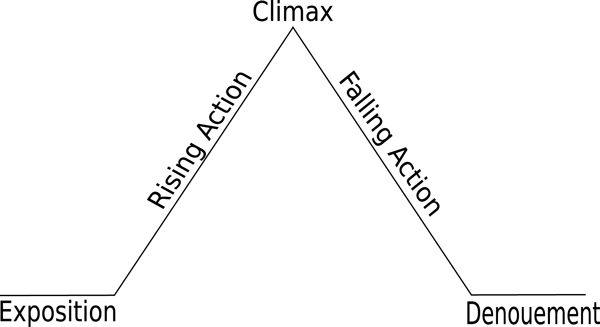
These won’t always correspond perfectly in a factual piece of writing like a white paper, but they can get you thinking about how to create and hold interest. Use those ideas to keep readers’ attention until the very end.
4. Mistakes a white paper should avoid
There are some pitfalls and common mistakes to avoid when writing a white paper. Each of these has the potential to make an otherwise stellar piece of content into a wasted effort. Here's a brief list of things to look out for.
Sounding like a sales pitch
When white papers are used as part of a marketing campaign where businesses showcase their product, a common mistake is to make them sound like a sales pitch . Don't let this happen; it will immediately turn your readers off. In a white paper, your audience is seeking unbiased, educational information that will help them, not try to persuade them. Save the sales pitches for other content, like product brochures .
Lack of adequate research
As previously mentioned, white papers should be well-researched documents. Conducting lengthy original research may indeed be outside a marketing team’s budget, but merely including a few stats from the first page of a Google search simply won’t cut it.
Aggregating statistics and searching through scholarly work may take time, but the result will be worth it. For your white paper to achieve its intended effect, It’s important to establish your content as an authoritative source to which the audience would want to return.
Poor design
We'll go in-depth into design in the next section, but it's worth mentioning here. The written content of a white paper is what matters most, but neglecting design is a big mistake. Design makes your salient points stand out and helps the reader understand what they're reading. Using visuals (like images, animations , videos, charts, and graphs) that support your arguments is crucial.
Check out this white paper example built with Foleon!. Open the white paper
Not telling a story
White papers are informative and factual. We’ve driven that point home already. That doesn’t mean they should be boring. Backgrounders, problem-solution white papers, and research findings all have a story to tell, and the reader is far less likely to make it through the entire piece without some form of narrative to keep them engaged.
Setting up a problem, elaborating on a solution, and including some type of success story is a proven formula for making any type of content more story-like.
Leaving it abstract
Because most white papers will involve sharing research findings, it can be easy to leave them in the realm of theory without explaining how to utilize those findings on a practical level. This is true more of backgrounders but can be the case with problem-solution white papers as well.
A good example is the abundant amount of content on employee engagement. Many B2B cases have covered the importance of employee engagement and the pitfalls of getting it wrong. Too little of this content goes further and gives concrete examples of what companies in specific verticals can do to alleviate the problem.
5. White paper format
Before addressing anything else, we first need to talk about the format you'll use.
A picture is no longer worth a thousand words. Today, its value is in the number of eyeballs it can keep glued to your content and the ratio of those viewers it convinces to click through to other sections of your website.
Your carefully crafted copy and painstakingly gathered statistics won’t earn those clicks on their own. The average human attention span is now less than that of a goldfish . And with 3.3 million Facebook posts, 448,800 tweets, and 149,513 emails sent every minute , competition for your readers' attention is intense, to say the least. Long form mediums like the white paper need serious sparkle just to compete.
How to format a white paper
You'll need more than just black text on a white background. Your design choices regarding things like color, typography, and the use of visuals will play a prominent role in the success of your white paper. Here are a few important principles to keep in mind for creating a quality white paper design.
Keeping mobile visitors in mind
More than 54% of internet traffic is now mobile , and web designers have adapted to this trend by creating what's known as responsive design . Before this, web pages simply scaled according to the size of a user's screen, retaining their layout. Naturally, this made most pages both unreadable and unnavigable on smaller devices.
Responsive design solved this by allowing elements on a page to rearrange, resize, or be completely hidden from view in response to the size of the screen. When a smaller screen is used, font-sizes increase, buttons become larger for touch screens, and the entire layout adjusts to make the page mobile-friendly.
But while this has become standard for web designers in a mobile-first world, producers of other digital content assets like white papers have generally not adapted . Surprisingly, most companies that offer white papers and eBooks on their websites still use PDF format .
The problem with PDFs is that they're unreadable on smaller screens . They're fixed-layout documents — they can't adjust or adapt to different screen sizes. Reading them on a mobile device requires excessive zooming and panning around, which is a terrible experience for users.
Mobile traffic is ever-increasing. If you decide to produce your white paper as a PDF , you risk excluding this vast segment of your audience. It's a design mistake that will cost you views and conversions.
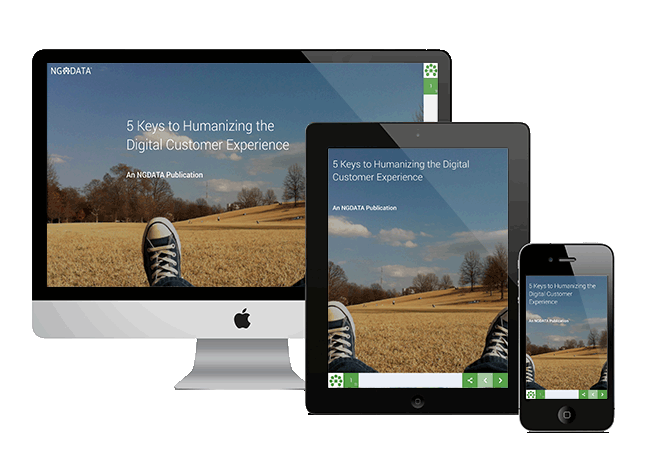
See examples of responsive white papers
Emphasis and readability
Because in-depth white papers contain lots of text and visuals, as well as supplementary information like footnotes, figures, logos and copyright info, the danger is that your design becomes cluttered. Clutter accumulates before you realize it. You may choose a clean layout and color scheme, to begin with, but as you continue to add content, things can get crowded. Often, you must make tough choices about what not to include to strike the right balance between completeness and readability.
Good design makes bold choices and prioritizes important information. These choices and priorities affect layout, placement, color, font size, page order and more.
Use these design elements to create emphasis on vital pieces of information. But be careful. Emphasizing too many pieces of information — or too few — will cause readers to struggle to discern what’s important.
Good design makes bold choices and prioritizes important information.
Have a look at what's trending
Bold fonts and color schemes are in. If you look at the hippest tech companies right now, you’ll see lots of pastels and color gradients. Of course, all that might change tomorrow. But still, a great way to get inspiration when you're just starting is to take a look at what design trends are currently popular.
U2's frontman, Bono, sings "every artist is a cannibal, every poet is a thief." And he's right. Good designers are always drawing inspiration from other designers.
The best way to create a successful design is to spend a lot of time looking at what others are doing successfully. Use Evernote , or a bookmarking service to save white papers and other exceptional designs that you encounter for future reference.
Don’t know where to start looking? Dribbble and Behance are two networks where great designers share their latest work. They consistently have material that’s on the cutting edge of what’s trending.
Design for your audience
While trends may inspire you, it's more important to align your design with your audience and your subject matter.
- Will you be addressing suit-and-tie financial executives or blue-collar management at construction firms?
- Are you writing about changes to privacy regulations in the tech industry, or about the effects of farming on biodiversity?
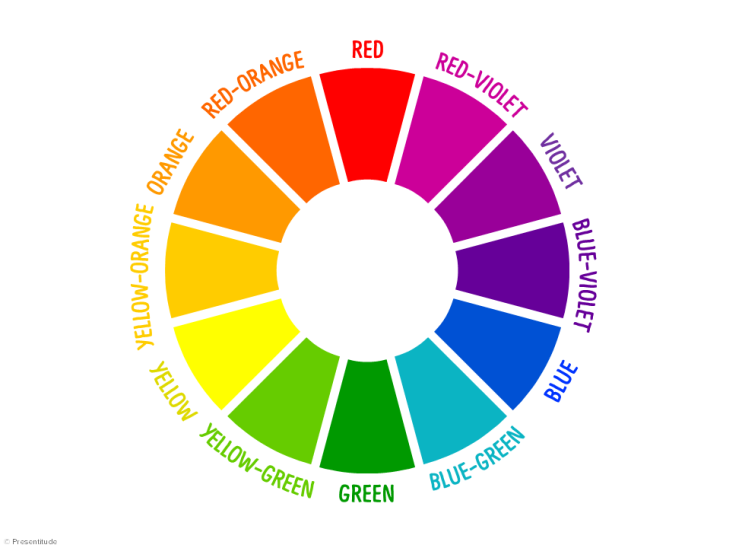
Your design should support and strengthen your topic. The colors and typography should be consistent with what you're writing about, the tone you've chosen, and the audience you've defined.
Writing a white paper for a funeral parlor? Hot-pink headlines might be a bad choice. Taking color psychology into account can help you achieve the look and feel you're after.
Brush up on the basics
No prior knowledge of design? No problem.
If you don’t have a designer working with you in-house, you can still teach yourself the basics of design and check work against those principles. A big part of the battle is knowing the search terms that will get you the knowledge you need. Luckily, good primers on basic graphic design are abundant.
After doing a bit of reading, start creating. Don’t be afraid of making mistakes. If you create a white paper and don’t like the design, try to pinpoint what it is about the design that needs improvement.
After the reading you’ve done, you’ll have the tools to critique your own work and the work of others. This is the best way to improve and create well designed white papers.
Choosing the right tools
At Foleon, we pride ourselves on providing a tool that makes creating responsive digital white papers easy, even for those with no prior graphic design experience.
Choosing a tool like this, which takes the guesswork out of design, will shorten the time it takes for you to produce great white papers. There is a vast ecosystem of tools out there, each of which is geared toward a different purpose and skillset. The right one will enable you as both a designer and a writer.
See how you can scale engaging content creation .
6. Gating your white papers
For most companies, lead generation and growing lists of contacts for the sales and marketing teams are important activities. Attracting visitors to your site and offering them something of value in exchange for their contact information is a proven method for filling the top of your funnel.
But for this type of inbound marketing to work, two things are needed: exceptional content that visitors are eager to acquire, and a method for gating (or walling off) that content behind a form.
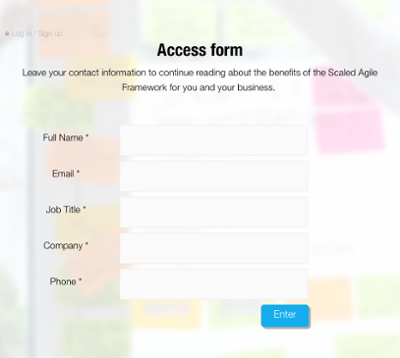
Many brands skip the first part and move straight to the second. They quickly produce something mediocre and put it behind a form. This might work in the short term for generating lists, but keep in mind that users expect more from content they “pay” for. The quality of your gated content serves as an indicator of the quality of your brand will affect your ability to turn prospects into customers down the road.
So how do white papers fit into your b2b content marketing funnel ? They may act either as lead generation tools themselves or can be used to direct readers to other parts of a website that captures lead information.
What is gated content?
Walling expert content off behind a form designed to capture personal details is one of the most common techniques for generating leads. Gated content is any content that a reader cannot access until after they input some personal information, such as their name and email address. White papers and eBooks are two of the most common types of content used for this purpose.
Typically, a company will create a landing page that includes a description — and perhaps a preview — of what information readers can expect to find inside. The landing page will include a form for visitors to enter their personal information and thus gain access. After entering the required information, visitors are either presented with a download button or receive the gated content in their inbox.
There are plenty of variations on this formula, but the basic technique of providing “free” content and asking readers to “pay” by providing their personal information has been very important part of content marketing for a long time.
To gate or not to gate
While gating your best content is great for lead generation, there are some drawbacks as well. Walling off your white paper will mean it gets read by fewer people as not everyone is willing to give away their contact details.
An open-access white paper will be read by a wider audience. If it’s in-depth and authoritative, it may also do well organically and improve your search rankings. Gating it behind a form, however, will prevent search engines from indexing it.
It’s important to consider what the primary goal of your white paper is: disseminating information and gaining brand awareness or generating leads. If the latter is more important, then gating is a great option.
Semi-gating
Another variation on gated content — and one that’s growing in popularity — is semi-gating . This can give you the best of both worlds by allowing your white paper to reach a wider audience while still retaining the ability to generate leads.
Semi-gating gives readers a taste of your white paper without requiring them to give up any info. You can, for example, make the first few pages of your white paper open access, and then make visitors fill in a form to read more. This works well because digital content is so abundant and brands must offer more for free or risk visitors turning elsewhere.
Allow your white paper to reach a wider audience while still retaining the ability to generate leads.
Offering more content for free also builds trust and brand loyalty among your readers. Let them know your white papers are valuable and helpful, and they’ll be more interested in giving you their personal information. You’re also more likely to gain qualified leads if readers have a chance to sample your white paper before converting.
Of course, semi-gating doesn’t mean giving away your entire white paper. Typically, there’s at least one section of the white paper that is exclusive to those who go through the gating process. Semi-gating can help reach a wider audience, build trust and loyalty, increase lead quality, and still help you capture the contact information you need.
There’s a concept in marketing and design known as friction . Friction is anything that causes the sales process to slow down. It’s like a roadblock that makes it less likely prospects will convert, sign up, download, or purchase. It can be caused by a multitude of things including poor design, confusing navigation, subpar copy, too many form fields, and more.
Your ability to generate leads with a gated white paper will largely depend on how much friction is involved. Asking for more information than you really need is one common and unnecessary source of friction that can lead to losing potential readers.
The entire field of conversion rate optimization is geared toward removing friction — or making user interactions easier. CRO specialists make forms simpler, navigation more intuitive, and design CTAs that are more likely to be clicked. Optimizing your landing page for conversions is a vital part of any lead generation campaign.
But the reality is, asking for personal information will always be an obstacle for a large number of people. So the key here is to make the process easy and noninvasive as possible.
An excellent way to do this is by reducing the number of form fields to the bare minimum and using mid-gating to ensure your ask is timely and yields immediate value for the reader: "Fill out this form to get access to the rest of this white paper, we've saved the best for last!".
Create white papers and eBooks that integrate with your favorite CRM or marketing automation platform. Get started
7. White paper distribution
So, after following the tips in this guide, you create an engaging, informative white paper that inspires readers to take action and deepen their relationship with your company. You mid-gate (or semi-gate) it to capture readers’ information and gain valuable insight into the interests and demographics of your consumer base.
Now, you publish it on your website, sit back, and wait for your Pulitzer.
Only, the traffic never comes… Where did you go wrong? You didn't think about your white paper distribution strategy .
The importance of distribution
The internet isn’t the same as it once was. Thanks to the massive amount of content produced every day for and an ever-growing number of channels, it’s a lot harder to get noticed. Unless you’re Gabriel García Márquez back from the dead, simply writing something and posting it online doesn’t guarantee readership.
To get eyes on your white paper, you need to be smart not only about writing and design but distribution as well. Some content marketing thought leaders go so far as to claim that you should spend 20% of your time on content creation and 80% on promotion.
Distribution is all about identifying traction channels where your ideal customers consume content and making your white paper highly visible on those channels. Depending on the audience you defined in the beginning, some will be more relevant for you than others.
Social promotion
If you’re at all familiar with marketing, advertising, or online media, chances are you’re aware of how important social media is to visibility. People from all walks of life, and from all over the world, are on Facebook, Twitter, and LinkedIn. Ensuring that you share your content regularly on these platforms will give you a solid base of promotion on which to build.
But it's not enough to simply write a post and tweet it into the void. Try to find communities like Facebook and LinkedIn groups where your target audience is likely to congregate. Search for relevant hashtags on Twitter and Instagram . Find subreddits relevant to your industry.
Once you’ve found your audience, it’s much easier to connect with them. If you contribute to these spaces regularly, you’ll have an easier time keeping their attention and distributing your white paper.
Influencers and earned media
Public relations isn’t what it once was; influencer marketing has taken its place as the way to get noticed by the masses.
These days, influencers — people with large, engaged followings on social media and newsletters — are better equipped to amplify your content than traditional journalists. They play a growing role in shaping public opinion and even in setting business trends . Shares from an influencer can even help you land spots in major publications the way press releases used to.
Social media is the best place to find influencers in your vertical. When you investigate the best communities in which to promote your white paper, look for the content that people are already referencing and sharing. Eventually, you’ll start to get a picture of who’s putting out content that’s getting widespread traction. These are the people whose voices can amplify your brand.
Start by interacting with them. Begin a conversation, comment on their pieces with regularity, and give them feedback on their work. There are great tools, like Voila Norbert and ContactOut , to help you quickly track down email addresses.
After building enough rapport, try offering to collaborate on future white papers or other types of content. This process can take some time because your goal here is to build a relationship.
Eventually, you can ask an influencer to share your white paper. You might even consider quoting them in the white paper itself — anything that gives them an incentive to share your work is helpful.
Pro tip: Try to find an expert in your white paper related subject and interview them. It will add value to your white paper and you'll increase the chance that the expert shares your content with his or her extensive network.
Email marketing
The jungle of online content may thicken daily, but there are a few places you can still get readers’ attention. Email distribution has stood the test of time in this regard. It provides greater ROI than social , and it shows no signs of weakening.
If the purpose of your white paper is lead generation, email marketing will not be applicable. But for boosting sales, building trust, and establishing your brand as a trustworthy source of information, it's important not to neglect your existing contact base.
Although email may not have the appealing viral possibilities associated with social media, it does have other advantages. Namely, anyone who subscribed to your email list chose to be there. This means you can expect a higher level of engagement from this audience than those who come in via other channels. Capitalize on their loyalty and engagement by encouraging contacts to share your white paper with their networks and thus multiply your distribution efforts.
This was discussed in the previous section, but it's worth mentioning again here: another big advantage of Foleon's gating features is that when your existing contacts share your white paper with their contacts, those people will be confronted with a login form that will allow you to capture their info and expand your email list further.
Going beyond the basics
The techniques discussed above are essential items in your white paper distribution toolbox. However, they’re not the only ones. The best way to distribute your white paper depends largely on your target audience and the industry to which your content speaks.
Take some time to critically evaluate and research how knowledge is shared in your industry. Every industry will be slightly different. Reaching people in these places is the best guarantee of effective distribution.
8. Handling your white paper leads
As we've discussed, white papers can serve a variety of objectives. They’re commonly used for thought leadership and to disseminate important research, relevant to a specific industry.
When it comes to content marketing, however, the most common use for white papers over the last several years has become lead generation. In chapter 6, we discussed how to bring readers to your white paper and capture their information.
Once you've properly gated your white paper and set up a solid distribution strategy, it's time to think about how you'll handle the leads that come in. If not properly tracked and nurtured, leads will quickly become cold and won't lead to increased sales for your company. So how do you follow up with leads and maximize the opportunity you’ve created with your white paper?
How to track your white paper leads
The buyer’s journey outlines the steps a person goes through, from becoming aware of a problem they have, to learning about different solutions to that problem, to eventually purchasing a product or service (hopefully yours) that solves their problem.
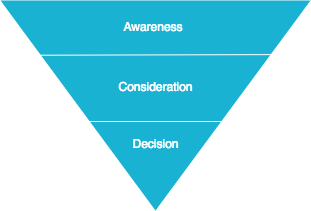
To maximize the chances your new leads become paying customers, you must take the abstract concept of a buyer’s journey and map it to your specific content ecosystem. The actions your prospects take on your website can be indicative of what stage of the journey they're in.
For example, you may see someone read a blog post on your site, then come back a day later to get your white paper, and then finally sign up for a free trial or an email list. After that, they might decide to make a purchase. As patterns begin to emerge around the journey your customers take, you'll learn what actions on your part can help them to advance.
There are many tools available to help you analyze this journey for yourself. Google Analytics is probably the most widely used. It lets you track and compile data regarding user behavior on your website. You can define goals and generate reports that will show you steps users tend to take before completing those goals.
Targeting stages of the buyer’s journey
As it becomes more clear what actions visitors take before purchasing, you'll better understand where to use your white paper in the buyer's journey.
The question you should seek to answer is, where does it provide the most value to your potential customers? Do you see greater success when accessing your gated white paper is a prospect's first interaction with your company? Or is it perhaps more effective to use it as an offer once visitors have returned a second (or third) time to your site?
You can see that white papers don't exist in isolation but act as a member of an ecosystem. The related blog posts, landing pages, emails, social messages, and follow up sequences must all be carefully orchestrated and properly timed.
This process takes practice. It takes trial and error, and you must be a keen observer of trends . However, that effort will pay off.
...white papers don't exist in isolation but act as a member of a content ecosystem.
Following up with your leads
Depending on where in the buyer's journey you use your white paper, the way you'll want to follow up with leads will be different.
- If, for example, your white paper targets the awareness stage and the leads you gather are relatively unfamiliar with your company, it might be smart to enroll them in an email sequence that highlights other pieces of content on your site such as blog posts that are relevant to the topic they showed interest in.
- Suppose your white paper is for people in the consideration stage, and leads are already familiar with what you have to offer. In that case, you might consider following up by sending them special offers or exclusive deals — again, closely related to the topic of interest.
- If you're taking a highly targeted approach to distribution and using your white paper to generate hot leads that you think are already close to making a purchasing decision, the best way to follow up might be for a sales representative to reach out directly by phone.
This is what it means to nurture leads. By proactively keeping in touch with leads and offering them more relevant content, you maximize the likelihood of them becoming a customer.
9. Choosing the right white paper template
In 2021, Hubspot reported that 82% of marketers actively invest in content marketing. Thus, the need to create interactive content experiences that stand out amongst your competitors has never been more critical in your content marketing strategy as the volume of published white papers grows yearly.
For this reason, the visual representation of your white paper has become increasingly crucial for retaining your audience's interest. In addition to the value your white paper content provides your audience, the single most significant factor at your disposal to maintain content engagement is how your white paper is visually presented.
For whitepapers, the white paper template you opt for to present your content can significantly influence the success of your publication. The template is more than just a matter of aesthetics; it represents a strategic decision that affects user engagement, experience, and even how your brand is perceived.
Below are some factors you should carefully weigh when choosing your white paper template .
Target audience and content
The two biggest influences that will determine the selection of your white paper template are your target audience and the purpose of your content.
For example, if you create an annual report that provides Financial Services information or a research piece exploring trends in Software & IT salaries, you’ll want to use a template that easily represents data-rich elements such as tables and eye-catching statistics. In contrast, visually-oriented templates containing hi-res imagery or videos are better suited for online catalogs or digital magazines .
Think about your target audience's needs and how your template's layout can optimize your content's engagement.
Creative control with flexible features
You’ll get the most value out of your interactive white paper with a content creation platform that allows you to harness professionally designed white paper templates that are easy to use and fully customizable with a drag-and-drop interface. This will allow everyone in your team to create content quickly with no coding experience required.
Custom templates set your white paper up for success by providing a starting foundation to help guide the layout and structure of your content. Custom features allow you to design your white paper any way you like by quickly changing blocks, fonts, and colors according to your brand guidelines with the added ability to add or remove sections.
Mobile experience and device responsiveness
As of September 2023, over 55% of website traffic is from mobile devices. Therefore, it is essential that your white paper is responsive across all devices.
Most content creation platforms have integrated tools that automatically adapt your content to different screen sizes. However, to ensure the best possible user experience, you should always test your white paper on multiple devices as part of your content creation process before publishing.
Finally, website speed is one of the most significant factors influencing user experience and playing a pivotal role in organic rankings. According to section.io , 32.3% of visitors bounce from a webpage if it takes more than 7 seconds to load. Ensuring that your content creation platform and hosting services are optimized for website performance is critical in maximizing your readership when choosing your white paper template.
10. Final thoughts
Be prepared to write a lot more content.
By this point, you should have all the ingredients you need to make your white paper a rousing success. However, you’ll notice by now the reality that your white paper fits into a larger ecosystem of marketing actions and content.
In today’s business world, producing quality content is one of the best ways to get your target market's attention. But not everyone will be ready for the same piece of content at the same time.
From white papers to blog posts, to podcasts, the type of content that will drive conversions for your business is something you'll discover over time. What’s certain is that one type won't satisfy all your audience's needs. Because of that, you should be prepared to fill the rest of your buyer’s journey with other appropriate content.
This means lots of writing. There’s no way around that. It means coming up with content ideas, creating them, distributing them, and measuring their success — then rinsing and repeating. After this primer, you should be fully equipped for success writing not only white papers but whatever content you choose along your journey.
Foleon Guide
Marketing power plays.
Whether you're in content, comms, or demand gen, here are some novel tactics from Foleon’s Marketing team.

See your brand in a Foleon Doc
Want to see your content in a Foleon Doc without lifting a finger? Here's your chance! Let us create a mock-up that's packed with media-rich features — just for you.

Send us an email
How to write a white paper that inspires a year-long content strategy
Written by by Katherine Kim
Published on November 11, 2020
Reading time 7 minutes
When it comes to establishing one’s brand as an authority, few resources get the job done like a data-driven white paper.
Longer than your typical blog post and more in-depth than an ebook, a white paper is a well-researched piece of content designed to educate readers on a specific topic. It allows you to position your brand as an expert in your field and demonstrate you have a solution to your audience’s problems. And because marketers often gate white papers behind an email form, these reports can help support goals like lead generation and sales.
But with a little foresight, a white paper can do more than capture leads. It can also fuel an entire year’s worth of content and support teams across sales, customer success and even design. From developing social media content to webinars to workshops, there are a number of ways you can extend the life of your white paper.
In this article, we’ll walk you through how to write a white paper as well as how to turn those data and insights into new content for the entire year.
What makes a white paper valuable?
Traditionally, a white paper is defined as an informational document to promote a product or service and is used by marketing and sales to persuade buyers to purchase from one brand over another. In marketing, a white paper can be used to provide in-depth research on a particular subject (like the state of social marketing) and gives brands an opportunity to build credibility with their audience.
Consider this data-driven white paper example: the Sprout Social Index™ . The Index™ is our annual 30+ page white paper filled with unique data based on consumer and marketer surveys. We look specifically at the state of social marketing, and offer insights on topics like consumer behaviors, marketers’ social goals and what differentiates one brand’s social presence from a competitor.
This is our ninth year of #trend forecasting with the Sprout Social Index: Social Media Trends for 2022 and Beyond We surveyed over 1,000 U.S. consumers and 500 U.S. social marketers to understand how social has transformed. 🧵 pic.twitter.com/6XgNkv64ps — Sprout Social (@SproutSocial) May 17, 2022
It takes roughly three months and collaboration across marketing, design and sales for the Index™ to come to life. On the other hand, this blog post you’re reading took me about one week to complete. To illustrate how to plan and develop a white paper with legs beyond its initial launch, we’ll share how we create the Index™ and the various assets that come from our annual report.
Phase 1. Planning for success
Before diving into topic ideation, establish the goals and objectives you want to achieve with your white paper. Goals can include everything from raising brand awareness in your target audience to fueling new business acquisition by generating leads. And determine which key performance indicators (KPIs) you’ll use to track your progress toward your goals, like net new users and content downloads. From there, develop a project plan with clear expectations around responsibilities and due dates, like when to expect a first draft or design assets for social promotion.
Once your goals and project plan are in place, then you can focus on narrowing your white paper to one specific topic. When in doubt, start by identifying your audience and brainstorming the different problems you can help them solve.
For the Sprout Social Index™, we look at a couple of factors to inform our direction:
- Our audience’s needs. Think about who is going to read your white paper and what problems they’re hoping to solve with the information provided. For the Index™, we know we’re speaking to social media marketers of all industries and experience levels, from solo practitioners to directors managing a team. So the data we offer needs to help our audience advance their careers, strengthen their strategies and sharpen their skill sets. We’ll consider things like top goals and challenges for social marketers, how social is viewed within an organization and what skills marketers hope to develop.
- The state of the industry. In addition to specific audience needs, we also look at what’s happening within the industry at large. Are there emerging trends our audience wants to understand? How are other brands responding to industry changes and what can readers learn from these examples? To ensure the Index™ is relevant for social marketers of all industries, we’ll look at big trends in the overall social marketing landscape like which platforms are most popular among consumers and what types of content generate the most engagement.
If you plan to use your white paper to inspire a year’s worth of content, take a moment to evaluate if the topic will be relevant a year from now. Timely data, while it can be extremely valuable as part of your content strategy, gives you less runway to develop content six, seven or eight months post launch. Additionally, you’ll need to have enough data to work with in the future. Keeping the topic broad enough will enable you to drill down into specific angles for future content.
Phase 2. Writing a white paper from start to finish
With a plan in place, it’s time to conduct your research, develop your white paper structure and deploy any surveys for data collection.
With the Index™, we use a platform like SurveyMonkey to conduct two different surveys: one for 1,000 consumers and one for 1,000 social marketers. We ask consumers questions like which social platforms they use the most and what actions can turn them off to a brand’s social presence. In the marketer survey, we ask them how they use social data, what their greatest challenges are and what factors influence their approach to social.
If you’re unsure how to analyze the data , try creating a separate Google Doc or spreadsheet to house your key findings, organized by question number. When reviewing the Index™ data, we look at things like:
- Responses to all questions without any filtering or comparisons
- Results when we narrow our focus to one particular subgroup (e.g. marketers at companies with only 1-50 employees)
- Responses that contradict our original hypothesis
- Contrasts between the two audiences (e.g. marketers versus consumers)

Remember: you won’t use every single data point in your actual report. Instead of tossing unused data to the side, consider using that information as inspiration for a future piece of content.
With your data in hand, it’s time to put pen to paper. Writing a white paper can take several days, or even weeks, and it’s helpful to start with a comprehensive outline to plan out the report flow. In the outline for the Index™, we include examples of the quantitative data to highlight and brand examples discovered during the research stage. Allocate about one week for outlining and drafting, which should include chart mockups of the data you plan to use.
For reviews, ask for feedback from your key stakeholders, including those who don’t work in content directly. Index™ feedback from our social team ensures we’re giving our target audience what they need while our PR team can recommend future storylines inspired by the report.
Phase 3. Bringing the data to life with creative
Another facet that distinguishes a white paper from a blog post is that white papers are often packaged as a designed PDF.
In addition to creating the PDF version of the Index™, our design team creates graphic assets and charts for use in content, on social and beyond. One of the reasons we ask our social team to review the final draft of the Index™ is to get feedback on which stats and insights will make for compelling graphics on social.
For example, one of the charts included in the Index™ talks about actions consumers take when they follow a brand on social..

Using the feedback from social, we identified one standout data point from this graph, and the design team turned it into a separate social graphic.
Fact: Fewer people are using hashtags for social discovery. Find out where consumers are turning their attention instead in this year's Sprout Social Index. https://t.co/YuWeXmiWBk pic.twitter.com/rcdzFDJNpx — Sprout Social (@SproutSocial) May 18, 2020
Developing a unique design system and color palette for each white paper creates a consistent visual identity so every asset looks like it belongs to the Index™ campaign. This also gives designers the flexibility to create new assets like GIFs throughout the entire year because they have a wide range of colors and motifs to pull from.
With your report ready to launch, remember you still need to track your progress toward your goals. Tracking not only shows you if you’ve achieved your goals but also if you need to adjust your distribution strategy to make up for lost ground.
Phase 4. Giving your white paper longevity
So you’ve officially published the final white paper PDF and all of your design assets—congratulations! But just because you hit that publish button doesn’t mean the work behind the scenes suddenly stops.
To kick off the Index™, we published a teaser post for an executive audience . The article preview some of the salient data points and highlight how the report will address marketers’ challenges, ultimately encouraging readers to download the Index™.
50% of consumers say they’re most likely to use social media during a major personal milestone. Create messages that consider your audience’s future plans and show how your brand can help them get there. https://t.co/ov3g4vd8fg — Sprout Social (@SproutSocial) May 5, 2020
To keep that momentum going, our social and creative teams collaborated to create the #DataDance, a series of short dance moves inspired by findings from the Index™. We encouraged our followers to both learn and share their own #DataDance with us on social.
How to #DataDance : a thread👇 pic.twitter.com/CfwlOJKDXR — Sprout Social (@SproutSocial) May 4, 2020
We also created new content like webinars and articles with industry-specific benchmarks months after the publish date. We also repackaged the Index™ as part of a larger toolkit for marketers as they begin planning for 2021. Finally, we included data from the report in our Data in Action workshop for social marketers, five months after the Index™ launched.
Takeaway #1: Tell people about your product! #SproutDataInAction pic.twitter.com/BUWe7XhBf5 — Sprout Social (@SproutSocial) October 15, 2020
When you can repurpose the data and insights from your white paper, you stand to reach new audiences, reinforce your original argument and demonstrate your expertise in a particular topic.
Breathe new life into your white paper
White papers are not only a great resource for brands to establish their expertise and build authority with their audience, they also can inspire entirely new pieces of content post launch. By repurposing your report and turning it into new content, you can extend the longevity of your data and ensure your white paper continues to drive traffic for the entire year.
Looking for more inspiration for your content strategy? Check out what marketers and consumers say makes a brand’s social best in class and other content insights in the Sprout Social Index™ today.
- Marketing Disciplines
- Team Collaboration
How to build a marketing tech stack that scales your business
- Customer Experience
Brand trust: What it is and why it matters
- Leveling Up
The 43 best marketing resources we recommend in 2024
Executing a successful demand generation strategy [with examples]
- Now on slide
Build and grow stronger relationships on social
Sprout Social helps you understand and reach your audience, engage your community and measure performance with the only all-in-one social media management platform built for connection.
👀 Turn any prompt into captivating visuals in seconds with our AI-powered design generator ✨ Try Piktochart AI!
A 2024 Guide to White Papers (with Templates and Examples)

White papers are an essential tool for establishing thought leadership, educating audiences, and generating leads. They offer a unique opportunity for companies to showcase their expertise and establish themselves as industry leaders. Plus, they’re not too difficult to create, especially with the right tools.
In this article, we’re going to look at what exactly white papers are and why they matter. We’re also going to give you white paper examples to inspire your next project, and what types of data visuals and designs you can include in your white paper to provide the most value.
If you want a hassle-free way to create these visuals, sign up for a free Piktochart account and use our platform to create professional-looking white papers in minutes.
Table of Contents
What is a white paper, types of white papers, elements of an effective white paper, compelling title and cover page, table of contents and executive summary, logical flow and organization, skimmable format, thought leadership and expertise, design and branding, call-to-action, white paper best practices and tips, inspiring white paper examples, conclusion and next steps, frequently asked questions.
A white paper presents information, research, or findings on a specific topic comprehensively and authoritatively. It presents research findings, incorporates expert opinions, and offers evidence-based recommendations. White papers are written in a clear, authoritative, and unbiased tone to establish the writer’s knowledge as respectable.
White papers are often used as marketing tools by businesses to show off their expertise and inform the target audience about a specific issue or solutions to a problem.
Because they provide valuable insight and solutions to problems that might be encountered by prospective customers, white papers are also a highly effective way of generating leads.
White papers are known for their in-depth analysis and research-based approach. They provide readers with a thorough understanding of the subject, supported by credible sources of information.
White papers can fit into four main categories, each with its own focus and purpose.
- Backgrounder/Product – Provides an in-depth look at a specific product/service. Highlights key features, benefits, and successful use cases.
- Numbered List/How-to – Written in a step-by-step format and contains instructions for readers for solving a problem or achieving an objective.
- Problem/Solution – The most common type of white paper, they identify a specific issue or challenge faced by the target audience and present a solution offered by the company, often to promote a product or service.
- Survey Findings/Market Research – Presents data and information from surveys or market research carried out by the organization used to showcase industry trends and consumer preferences, or to promote a product or service.
The elements you should include in a well-drafted white paper are:
Your white paper’s title and cover design form readers’ vital first impression. Craft a compelling title that clearly conveys the value readers will get. Use meaningful keywords to help it get found.
An eye-catching cover image can also help hook readers and set your white paper apart. But keep it professional – avoid cheesy stock photos.
A table of contents makes it easy for readers to navigate through the document and allows them to jump quickly to sections of interest.
Follow this with a concise executive summary. An executive summary presents a short overview of key points covered by the white paper. Call out the key problem, main takeaways, and a teaser of the solution. This sets expectations and motivates readers to dive in.
A well-crafted white paper follows a logical flow and is organized in a way that makes it easy for the reader to follow. By flow, we mean it should have a clear introduction, main body, and conclusion. The main body should be divided into sections with catchy headings to keep the reader engaged. Then, these sections should “flow” into one another with transition words and sentences.
Having a logical flow not only improves readability but also adds credibility to your white paper. It shows that you have put thought and effort into creating the document, which reflects positively on your brand.
Not all readers will have the time or patience to read through your entire white paper. Use a skimmable format to make it easier to navigate and digest, no matter who your reader is.
Make an effort to include:
- Short paragraphs, centered around one idea at a time
- Bullet points, to emphasize lists that might get lost in paragraphs
- Headings and subheadings, to break up and organize your content
- Call outs and quotations, to highlight key points
- White space, to give your readers’ eyes a rest
- Visuals, to convey information quickly and make it easy to understand
White papers aren’t just about promoting your products or services – they should be well-researched and provide valuable insights and information. This is where thought leadership comes in. By showcasing your expertise, you establish credibility and trust with your readers.
For example, if you’re a software company specializing in data analytics, you can create a white paper discussing the latest trends and best practices in the industry. By referencing your data, you demonstrate that you have unique and valuable knowledge from the field.
It’s important to design and brand your white paper to draw attention and build credibility. Maintain consistency with the company image by following brand guidelines on color, font, and images. A professional and polished appearance will build trust with your audience and give your paper an authoritative feel.
In view of the growing popularity of digital formats, it is important to create interactive white papers that allow readers to engage with them through features like clickable links, videos, and animations. As a result, the reading experience is enhanced and sharing on social media platforms is made easier.
Ending your white paper with a clear call to action (CTA) is key. After reading, what are the next steps your reader should take? Prompt them to schedule a consultation, sign up for a newsletter, buy a product, or check out a resource. Whatever your paper hints at, this is the moment to bring it to the surface to make it easy for your reader to try.
White papers may also be gated, meaning that readers have to provide contact information before they can access the content. Businesses can use this to generate leads and build their email list.
Let’s take a look at some good practices and tips to create an efficient white paper.
You need to know the target audience and their pain points if you’re going to make it through your white papers.
What’s the challenge they’re facing? What’s the information they need to solve this problem? Use these insights to shape your white paper’s focus, structure, and language. The more relevant it is to readers’ needs, the more impact it will have.
A common mistake marketers make is to use white papers as a thinly veiled sales pitch. Instead, focus on educating the reader and providing them with valuable information. In this way, you build trust and demonstrate your credibility in your space.
Remember: you’re the authority, and you want to prove that, but your readers can’t always match that. Write clearly and simply without too much jargon or technical terminology to make your white paper accessible.
Don’t just post your white paper and pray. Actively promote it across multiple channels, such as:
- your websites
- email marketing
- social media platforms
- advertisements
The more touchpoints you create, the more likely it is that potential customers will read your white paper.
White papers are a valuable source of content because they are great for repurposing . You can, for example, turn key points from your white paper into blog posts, infographics, or even video content. This enables you to reach a variety of people and maximize the impact of your white paper.
Looking for inspiration for your next white paper? These examples from various industries showcase the diverse possibilities of the format.
Source: Infigo
1. “The State of Marketing Automation” by Ascend2
This paper highlights research on the current state of marketing automation and its implications for businesses. You’ll notice Ascend2 utilizes stacked bar charts to visualize the data they include, making it more accessible. Stacked bar charts are available with Piktochart’s functions.
2. “The Ultimate Guide to Social Media Advertising” by Mayple
This is an in-depth analysis of the trends, strategies, and best practices for businesses advertising on social media, made into an article. They know what they’re doing by posting this white paper as an article, using pre-written content to boost engagement on their blog. Piktochart has tons of templates that can help you do this for any format.
3. “The Future of Work” by ILR CAHRS
The future of work and how technology will shape it in the years to come is explored in this Cornell white paper. While it may not be the most dynamic of our examples, they use branding that carries through at the top and bottom of every page to keep things consistent.
4. “The Power of Personalisation” by Infigo
This white paper looks at how web-to-print software can help your printing business grow through personalization. It illustrates this point perfectly with stunning visuals and dynamic colors throughout that keep you engaged while reading, hence why they are our example above. Piktochart can help you create something just as visually beautiful that will keep your audience looking.
5. “The State of Cybersecurity 2023” by Sophos
This white paper provides a comprehensive overview of the current state of cybersecurity, its challenges, and emerging threats. Based on a survey of 3,000 IT professionals in 14 countries, it’s a report with lots of hype around it, but Sophos utilizes the paywall method to keep this valuable information to only those who give them more valuable information.
6. “The Ultimate Guide to Email Marketing” by AWeber
A step-by-step guide on creating effective email marketing campaigns is presented in this white paper. It’s a lengthy document, so AWeber breaks it up using headers and a table of contents so you can navigate to the info you need quickly.
7. “The State of Virtual Events 2023” by Kaltura
The results of a survey that asked over 500 marketing professionals about event planning in the face of worldwide uncertainty can be found in this paper. This is another whitepaper that uses a pay/information wall, which positions their white paper as a method for gettting capital.
8. “Your Ultimate Guide to eCommerce SEO” by Pimberly
This white paper provides an in-depth analysis of search engine optimization (SEO) and its importance of online businesses. Pimberly does a great job of gauging interest up front, not only by asking for an email, but also by providing a summary and an expected read time, 15 minutes.
9. “Challenging the Modern Myths of Remote Working” by IBM
This white paper explores the rise of remote work and its potential benefits for businesses. IBM uses plenty of white space and visuals to keep their paper interesting, formatting you can recreate easily with Piktochart’s dynamic templates.
10. “The Power of Video Marketing” by Craig Charters
The benefits of video marketing for businesses, including the impact on customer engagement and brand awareness, are dealt with in this white paper. While video is hard to capture in a physical document, Charters uses links and tons of photos to get physical examples in his work, making it accessible and fun as well as informative.
White papers are a vital tool for businesses who seek to establish themselves as though leaders and draw up leads. Through research and a clear tone of voice, they provide useful information and solutions to audiences. If you take the advice given above, you’ll be well on your way to producing a persuasive and visually stunning white paper.
If you’d like some extra help, Piktochart provides any white paper template you might need to start your business, including the following:
- Simple white paper
- Government white paper
- Social media white paper
- One page white paper
Here’s an example of what your white paper could look like with our help:
Source: Piktochart
Our easy-to-use platform makes it simple for non-designers to create professional-looking white papers in minutes. And if you need additional assistance or guidance, our team is always available to help.
A white paper shouldn’t be hard to make or read. Sign up with Piktochart today and start making next-level content that pushes your business further than ever before!
How to Write a Whitepaper?
Writing a white paper can be tough, but it can be an effective lead generation tool by providing valuable in-demand content to your target audience. We have a few steps to follow to help you start:
- Choose a Topic: Select an appropriate and efficient topic based on your business/industry experience.
- Research: Conduct extensive research on the selected topic so that you have solid data, statistics, and insights for your white paper.
- Outline: Create an outline that includes key points you want to cover in each section of the white paper.
- Introduction: There’s a reason you’re writing this white paper and why your audience is reading it, so start with an attractive introduction that clearly sets out the purpose.
- Body: Present your findings, data, and analysis in a logical order with supporting evidence and examples.
- Conclusion: Summarize your main points and come up with recommendations/solutions based on the information you provided.
- Design: Use graphics like graphs, charts, and illustrations to make your white paper more interactive and easier to read.
- Proofread: Prior to publication, make sure all grammatical and spelling errors have been rectified.
What is a White Paper Template?
A white paper template is a pre-planned document which can be used as a starting point to draw up a paper. It’s composed of sections like:
- introduction
- problem statement
- research and analysis
- recommendations
The time needed to complete the white paper can be reduced by using templates, with a view to ensuring that its structure is consistent. It is also a good way to ensure that you don’t miss anything of importance in each section.
What is the Difference Between a White Paper and a Report?
While both white papers and reports present information, there are some important differences.
Reports are often more factual and objective than white papers, while white papers usually use a more persuasive tone to convince readers of a specific point or solution. Compared to reports, white papers tend to be more detailed and complex.
They can also be used at different times. Reports are generally drawn up after a project is completed, while white papers are often used at the beginning of projects or for proposing solutions.
What are White Papers Examples?
White papers can cover a wide range of topics and industries. While we have some specific examples listed above, here is what they would generally look like in some of the most prominent industries:
- Technology – A white paper that discusses the benefits fo using cloud computing for businesses.
- Healthcare – A white paper that examines the impact of telemedicine on patient care.
- Finance – A white paper that analyzes the use of blockchain technology in financial transactions.
Why is it Called a White Paper?
The term “white paper” originated in the United Kingdom’s government as a way to present policy proposals. They were called white papers because they were typically printed on white paper and presented factual information without any bias or opinion, making them pure or “white”.
Who Writes White Papers?
White papers are usually written by experts in a specific field, such as industry professionals or academics. They have the knowledge and expertise to provide valuable insights and analysis on complex topics.
Within a company, white papers can be written by various departments, such as marketing, research and development, or product teams. It is important to have a strong understanding of the topic and access to relevant data when writing a white paper, so think about who in your company would be best qualified to talk about the task at hand authoritatively when deciding who will write your white paper.
How Long Should a Whitepaper be?
Typically, white papers range from 6 to 20 pages. However, the length can vary depending on the complexity of the topic and the amount of research and data presented. For simpler topics, or those that they plan to repurpose as a social media post, some companies prefer to use a one page white paper .
What are Good White Paper Topics?
White papers are usually focused on a specific industry or problem that your business addresses. Some examples of topics for white papers could be:
- The Future of Artificial Intelligence in Healthcare
- The Impact of Social Media Marketing on Consumer Behavior
- Sustainable Solutions for Environmental Conservation
It is essential to choose a topic that aligns with your business and can provide valuable insights to your target audience.

Other Posts
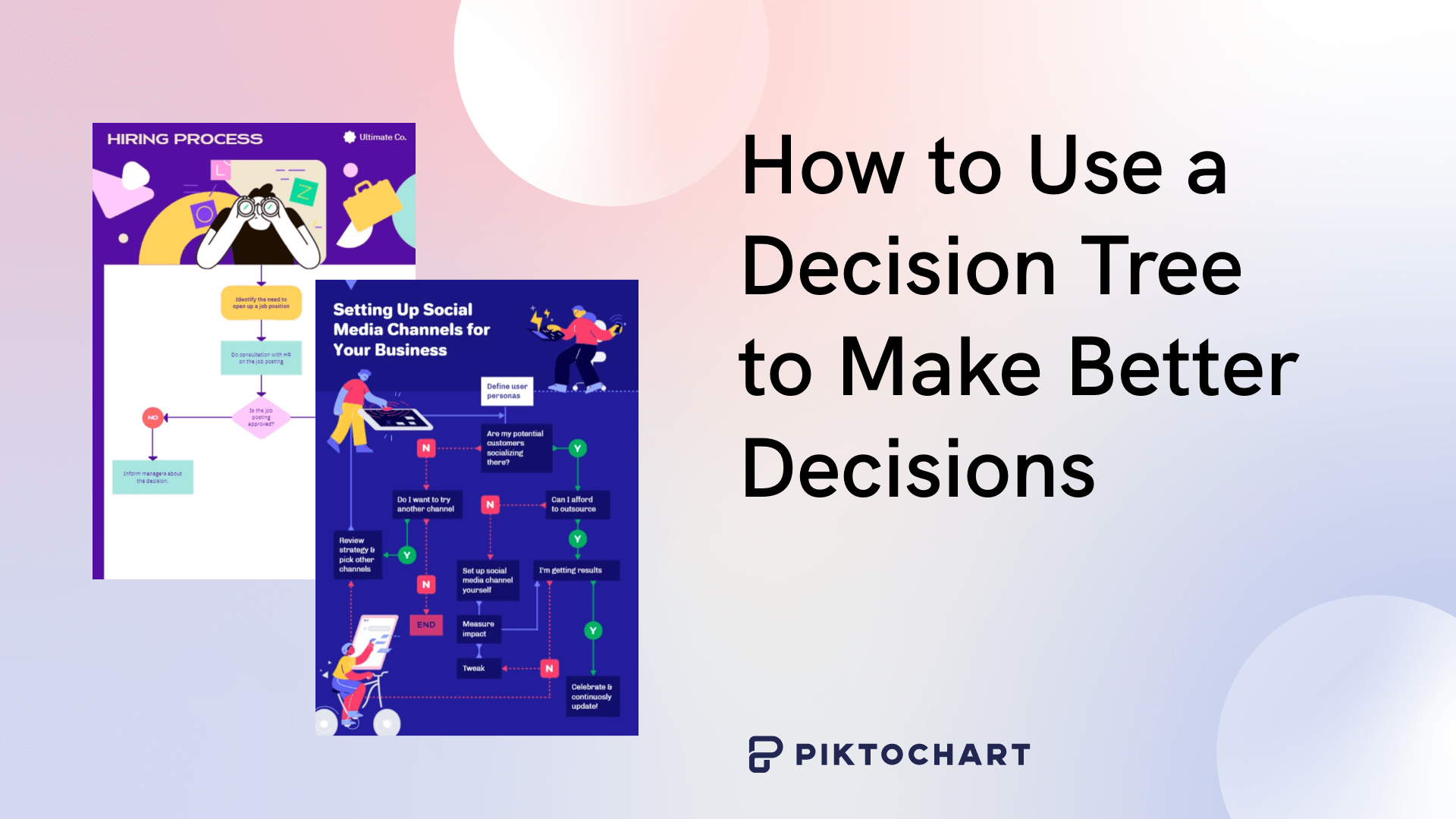
How to Use a Decision Tree to Make Better Decisions (with Examples)

11 Stunning Travel Brochure Examples Plus Tips to Help You Stand Out

The Best Free Project Plan Templates for 2024
Writing a White Paper Like a Pro: 9 Essential Steps for Success
Writing a white paper is the heavyweight bout of content creation . And just like boxing, crafting a white paper requires strategy, finesse, and a game plan. It’s not just about throwing punches — it’s about knowing the right time to jab with statistics, slip in case studies, and use compelling insights and analysis to deliver a decisive hook. Execute it well and your white paper can position your brand as an industry champion who’s adept at addressing your customers’ needs.
Creating this type of content is more of an art than a science, but there are general guidelines you can follow to help you out along the way. Here are some tips for writing a white paper, from choosing a topic to sharing your content with the world.
1. Choose a compelling topic
White paper topics should focus on things people actually want to read about. This seems obvious, but finding the right topic can be your biggest challenge. First, figure out who your audience is; who are you trying to reach? Then, choose an issue that’s interesting to them — perhaps a common problem they’re faced with, or a case study of successful companies in your industry.
Contently recently helped a staffing agency put together a white paper on the current talent landscape. It offered data and insights on how to attract talent, interview candidates, onboard employees, and keep staff happy for the long run. That’s exactly the type of insight the agency’s audience of employers needs to help fill roles. Plus, the white paper positioned the staffing agency as a go-to expert on talent recruitment.
You don’t need to reinvent the wheel to find white paper topics that will resonate with your audience. Take a look at the topics of content you’ve already created, like blogs, social media posts, and podcast episodes, for inspiration.
2. Write an outline
While you might be able to wing it with a blog post, long-form content like white papers require more planning. Knowing how to write a white paper outline can help you organize your content in a coherent way and make sure you cover the topic thoroughly.
Here are some common sections of white papers you can consider including in your outline:
- Executive summary
- Introduction and background
- Description of the problem (or problems) the paper will address
- Recommendations
- Conclusions
Making sure your white paper is organized upfront can save you a lot of time at the writing stage. It will help you focus on exactly what you need to cover and where.
3. Gather your references
Writing a white paper requires you to use a variety of different materials to make your points clearly and effectively. Gather up everything you’ll need to lay out the problem and proposed solutions. This can include:
- Case studies
- Internal data
- Industry reports
- Research from third parties
- Historical information
- Academic studies
Some brands also include quotes from their executives or leaders to emphasize points and expertise in their white papers. If that’s a strategy that makes sense for your content, this would be a good time to conduct interviews or ask for quotes.
Having your research and references ready to go can streamline the writing process. You can focus your attention on craft and form rather than trying to dig up another source. Keep the materials organized by subtopic and where you expect to use them in your outline.
4. Craft an attention-grabbing intro
Be captivating when writing a white paper introduction. You want to catch people’s attention right off the bat. Pique their interest, and then tell them what they’re going to learn by reading your white paper. This means writing a summary of your white paper and including an organized list of topics.
Emphasize the value you will create. Your white paper is not a billboard for your business — it is an opportunity to create an image of expertise and insight that will help your readers.
Not sure where to start? Take a look at the most compelling statistics you found in your research. You can use a staggering number that illustrates the problem you’re covering or solution you’re proposing as the hook for your introduction.
5. Start writing
Armed with a body of research and a captivating introduction, you’re ready to start writing a white paper. Get your thoughts down while they are still fresh in your mind. Just start writing.
Your white paper can be as little as five to six pages long or extend well beyond 25 pages, depending on the subject matter and depth of the content. If you’re used to writing shorter pieces of content, it can feel overwhelming to try to fill all those pages.
That’s where your outline can come in handy, though. Think of each section as its own mini piece of content.
Be descriptive and professional. Writing a white paper is not the same as writing a blog. You need to use a business writing style and be fairly descriptive.
In your conclusion, explain how your company can help. If you are selling a product or service that will help your readers, make sure to mention it at the end. You shouldn’t use the body of the white paper to sell your product or service, so make sure to use a catch that is naturally incorporated when you summarize the paper.
Don’t worry about editing until you have completed the draft. You will have no problem going back and making everything flow well afterward. If you can’t think of ways to make a smooth transition between sections in your first draft, you can add them later.
6. List your sources
Citing your sources is not only important for crediting the sources of the research you used — it also helps establish transparency and credibility to your white paper. Showing that you looked at high-quality reports and research helps build trust with your audience.
You have a few different options for citing sources in a white paper. For its white paper, “ Why Learning is Pivotal to Business Transformation ,” Conduent used footnotes at the bottom of each page. This method gives white papers a more academic feel without interrupting the flow of the text.
You could cite your sources at the end in a “references section.” While this minimizes visual distractions in your white paper, it comes with the trade-off of forcing readers to flip to the end to see where you got your material.
Some white papers opt to use in-text citations. It’s a more editorial style that can make your white paper read like a magazine story. However, it adds a lot of extra words to the text, so avoid this method if you have tons of sources to cite.
The method you use depends on the style of your white paper and your audience. But as long as you cite your sources clearly and consistently, you’re in good shape.
7. Proofread your white paper
After writing your white paper, it’s time to break out your (digital) red pen and proofread it to perfection. Go back over your draft and see what needs to be done to make it read better.
Ask for other people’s opinions, because they may be able to catch mistakes you overlooked. Read it out loud to ensure there are no run-on sentences or awkward phrases.
If you have the budget, consider contracting with a professional editor or proofreader to give it a final read. A white paper is a powerful sales and marketing tool, so you’ll want to make sure it’s polished, professional, and free of typos.
8. Invest in a visually stunning design
The design of your white paper can make a big difference in motivating people to read it. Don’t take the term ‘white paper’ too literally — it’s often full of color and design elements that make it more enjoyable to read.
Start by choosing a clean and professional layout that aligns with your brand’s identity. Use consistent fonts, colors, and formatting throughout the white paper to maintain consistency. Make sure your heading and subheadings stand out to increase readability.
Break up big blocks of text with other visual elements. Images can go a long way to driving a point home and keeping your audience engaged. Incorporate graphs and charts to help data stand out. You can also use pull quotes from leaders at your brand to build expertise throughout the white paper.
Pay particular attention to your title page, too. It should include your company logo, the title of your white paper, and an eye-catching photo or image. This is your chance to make a great first impression, so use this space wisely.
9. Put it out in the world
After you’ve put the final touches on your white paper, it’s time to publish and distribute it. Promote the white paper to your network. Create enticing teasers to generate curiosity and drive traffic to a dedicated landing page where visitors can download the white paper in exchange for their contact information. This turns your white paper into lead-generating content .
Consider collaborating with industry influencers or partners to expand your reach and tap into their networks. This helps your white paper reach a wider audience and make a bigger impact.
You can also repurpose the content from your white paper to make it even more engaging. The insurance company Travelers transformed its white paper on managing the risks of AI into a multimedia webinar . Get creative, and think about ways to turn your white paper content into social media posts, videos, infographics, and even podcast episodes. It gives your audience more ways to interact with the content you’ve worked hard to create.
Writing a white paper is your brand’s chance to shine like a beacon of authority. With strategic planning, compelling content, and a striking design, you can grow your audience and spark genuine interest in what your brand has to offer.
Ask The Content Strategist: FAQs About Writing a White Paper
How can a brand measure the effectiveness of a white paper after it has been published.
Brands can measure effectiveness through metrics like downloads, social shares, and website traffic, while gathering feedback through surveys or feedback forms to assess reader satisfaction and comprehension.
What are some common pitfalls to avoid when writing a white paper?
Common pitfalls include lack of clarity in defining objectives, overloading with technical jargon, insufficient evidence, neglecting audience interests, and ignoring visual appeal.
How can brands ensure that their white paper content remains relevant and up-to-date in a rapidly evolving industry landscape?
To maintain relevance, brands should monitor industry trends, update content regularly, engage with experts for fresh perspectives, and encourage feedback from readers.
If you’re looking for more examples of great content, check out Contently’s case studies page .
Get better at your job right now.
Read our monthly newsletter to master content marketing. It’s made for marketers, creators, and everyone in between.
Trending stories

A Guide to Crafting the Perfect Content Format Mix for Audience Engagement

In Tough Times, Self-Aware Marketing Helps You Stand Out & Save Money

‘Branding Moments’: Brand Storytelling Examples to Get Your Message Across

How to Onboard and Work with Freelance Writers
5 Financial Content Marketing Insights From The Best Email Newsletters
You are here: Influencer Marketing Hub » Social Media » 10 Amazing WhitePaper Examples (& Useful Tips To Stand Out)
10 Amazing WhitePaper Examples (& Useful Tips To Stand Out)
White papers are highly effective marketing tools when used right. They allow businesses to explain a specific product or service to clients or establish their company as an authority in the industry they serve.
It is typically published as an official company document and distributed to potential customers, investors, and other stakeholders. Businesses often use white papers to promote their services or products.
They usually include an in-depth analysis of a particular topic and a conclusion that offers value to target readers.
Many companies use white papers to attract leads, particularly in industries such as technology or consulting. However, creating a good one can be challenging—particularly if you're not familiar with technical writing.
Learn all about white papers in this guide. It covers 10 white paper examples and tips on how to write one yourself.
How to Write a White Paper:
1. temenos white paper, 2. zendesk white paper, 3. cognizant white paper, 4. nucleus white paper, 5. bdo white paper, 6. bbn white paper, 7. mdg white paper.
- 8. Cisco White paper
- 9. ADP White Paper
10. Sungard Availability Services White Paper
Frequently asked questions, what is a whitepaper.
A white paper is an authoritative report or guide that helps readers understand a complicated issue and offers recommendations for approaching it.
Traditionally, white papers were used to educate readers about products and services, but they are now often created as marketing documents intended to persuade potential customers of their value.
eBook vs. White paper: What is The Difference?
White papers and eBooks are often used interchangeably or in the same context. But a few distinctions exist between the two, and it is important to know which one is appropriate for your business.
There are many types of eBooks, but the most common ones are used to give an overview of a subject. They use a more casual tone geared toward readers who aren't experts in a field; thus, they're more conversational in style.
White Papers
White papers are best suited for readers who are already familiar with the subject discussed and want to learn more about a specific subtopic. White papers tend to be more accurate, formal, and based on solid analysis.
What Is the Purpose of Writing a White Paper?
In marketing , a white paper is a short document that describes a new product or idea in-depth. It typically contains detailed information about all aspects of that product, including advantages and potential disadvantages. A white paper can be used as an overall marketing product in numerous situations.
Using white papers to educate the general public about new goods, services, or procedures is an excellent way for businesses to reach out to them.
Companies in B2B marketing utilize white papers to share information about their products and services with other firms in the industry. Social media agencies can also use white paper to analyze different content strategies for various demographics.
Who Uses White Papers?
For many years, government agencies, social media agencies, consulting firms, and financial institutions have used white papers to share ongoing research findings.
As a result of the sporadic growth of content marketing and social media, white papers have become increasingly common. They can be shared on LinkedIn , Facebook , or even Twitter to direct followers to read more about a report.
- 50 Blog Post Ideas for Content Creators When Writer’s Block Stri...
- Executive Summary Examples & Tips to Write Your Own
- 10 of the Best AI Tools for Journalists to Help You Write Faster a...

Types of White Papers
There are different types of white papers , but these four are the most common.
Comparison White Paper
This type of white paper compares different items to assist customers in making an informed decision. When a potential buyer is already interested in a product but doesn't know which one to choose, these white papers are often used as a guide.
Overview White Paper
This type of white paper presents an in-depth analysis of a product's characteristics and advantages. By reading this white paper, customers may learn more about a product or service.
Numbered List White Paper
There are many similarities between this form of white paper and a blog post or an article. The list structure of this white paper makes it simple for a reader to take in information, such as advice or examples.
Solution-Based White Paper
The solution-based white paper addresses an issue affecting the company's industry, along with current solutions that aren't working and a new solution or approach that outperforms the previously outlined solutions.
How to Write a White Paper (step by step)
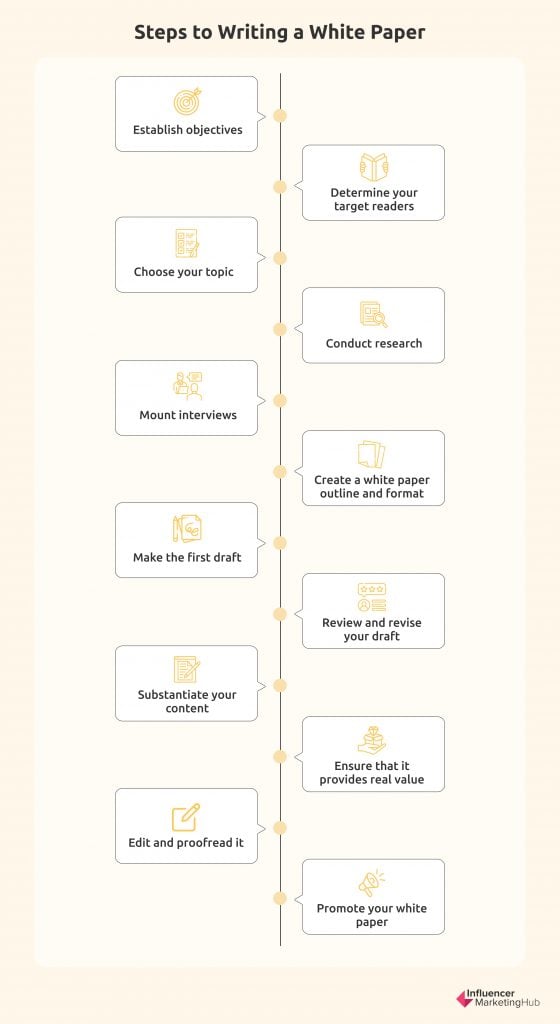
We'll walk you through the steps to generate your white paper for your company in the following sections.
1. Establish objectives
It is essential to have clarity on the purpose of your white paper and ensure that your goals are aligned with the organization's needs.
2. Determine your target readers
This next step involves identifying who your white paper is written for. Knowing and understanding your target readers can help you ensure that your white paper is cohesive and impactful. If you know your audience, you’d be able to establish a focus point that would be relevant and beneficial to them.
Creating buyer personas might help you pinpoint the precise demographics of your target market. A buyer persona is a typical consumer demographic and psychographic profile that you may use to target your marketing efforts.
3. Choose your topic
Pick a subject that you are familiar with and have vast knowledge about. It's essential to have adequate information and evidence to back up your claims in white papers. In addition, you must choose a topic that would resonate with your audience.
To get the outcomes you want, you need to make sure your topic is helpful and appealing to your readers. If you're feeling stuck, there are a few things you can do:
- Find out what your consumers' most prominent issues are by analyzing their feedback through surveys, reviews, testimonials, etc.
- Encourage your employees to develop new ideas based on what they've learned from their interactions with clients.
- Find out what people are inquiring about in your sector by conducting market and SEO research.
4. Conduct research
A white paper should focus on a particular subject to demonstrate an organization's expertise. If you can, perform outstanding research or hire someone to do the work. You can include results from your findings in the white paper.
Independent sources are mostly reliable when it comes to substantiating your claims. A common practice in white papers is using footnotes or an APA-style citation structure.
5. Mount interviews
The expertise and knowledge of key personnel within an organization and outsiders will probably be required.
Interviews should be conducted and after you have finished some of your research ., you will be more aware of the specific knowledge gaps you need to bridge.
6. Create a white paper outline and format
Plan the flow of your white paper and begin crafting a streamlined table of contents. For the most critical parts of your material, use high-level headers and subheadings to break it into different sections further.
Each part should have a list of ideas and significant elements to address. You will do both internal and external research to support these ideas.
7. Make the first draft
Start with an executive summary, which should be able to immediately catch the reader's attention. It should directly address the reader's problems, fears, or disappointments. This would help establish your paper’s relevance.
Don't provide the solution in your summary, since you want the reader to continue reading. Because white papers are not marketing brochures, you should concentrate on offering valuable and unbiased information.
Any reference to a company's product or service should be at the very end of your paper, in a reasonably short part. A brief remark in the executive summary is also an option. A call to action should be included at the end of your white paper as well.
8. Review and revise your draft
Even though a white paper may not necessarily require several revisions, there might be logical flaws and missing points in your initial draft.
After completing your first draft, take a break and return to it with a fresh perspective. It is even better if you can get the assistance of another talented writer on your team to help out.
9. Substantiate your content
Solidify the value of your white paper by backing up your claims with evidence and legitimate references.
Use reliable facts, figures, quotations, and other data. You may leverage data visualization techniques like graphs, widgets, maps, charts, etc.
The information you include in your white paper should be cited appropriately. Footnotes and comments, and a concluding section listing sources can all be utilized to cite your sources in the text of your white paper. References should only be cited if they've been confirmed for accuracy and are still valid.
10. Ensure that it provides real value
When writing a white paper, avoid promoting your company. Instead, focus on providing your readers with various helpful information . A superb white paper will be shared and eventually read by your target audience.
As a corporation or brand, you should use white papers to demonstrate your knowledge in a particular industry. If you want your readers to trust you as a knowledgeable authority, they need to learn something new from your piece.
11. Edit and proofread it
A simple typo or excessive words in the headline might ruin your research and writing efforts. To guarantee that their work is error-free, professionals use proofreaders.
If you can't perform the editing and proofreading alone, ask the help of co-workers or hire a professional. Investing the time and energy is worth making your work stand out.
12. Promote your white paper
It isn't enough to compose the paper; you must also make sure it reaches your target readers. Companies sometimes send press releases to announce the publication of a new white paper.
If you're already active on LinkedIn or Twitter, these are platforms on which you can discuss and distribute your white papers and reports.
White Paper Writing Format
Here is the standard writing style format of a white paper.
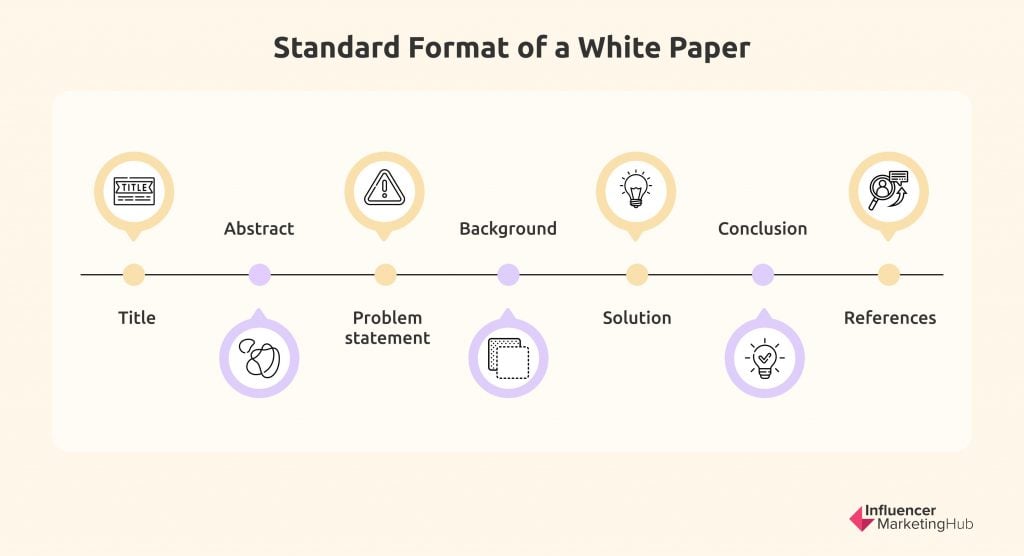
A paper's title should attract the reader's attention and show the topic's relevance. Hiring a copywriter who knows the ins and outs of compelling and persuasive headlines may be worth the cost.
A white paper's abstract gives the reader an overview of what they would get from the document. This should spark their curiosity and compel them to read more.
Problem statement
The white paper's problem statement identifies the subject matter. To ensure that the reader understands the problem, it must be explained in the white paper .
This section provides the background necessary for the audience to comprehend the problem and the solution properly. Information may be modified to meet the individual needs of the reader. For a white paper , it is essential to disclose the methodology utilized in the original study.
The solution of the paper will reveal the answer. This area of the white paper should be evident and apparent that the previous sections have been addressed and solved.
When writing a white paper , include a concluding section that sums up all results. In contrast to most corporate reports, white papers end with a concluding summary. In this part, be sure to provide insight-based suggestions.
A white paper's credibility and trustworthiness heavily depend on its reference section. Do not make any assertions without citing your sources that your readers can opt to verify.
10 Best White Paper Examples
To help you better understand how to write a white paper, we’re sharing 10 examples from different organizations in various industries.
Temenos is a software business that specializes in banking and financial services software. One of its white papers talks about open banking and can be classified as an overview white paper, since it comes with a comprehensive report. Detailed visuals are also used with infographics to represent data.
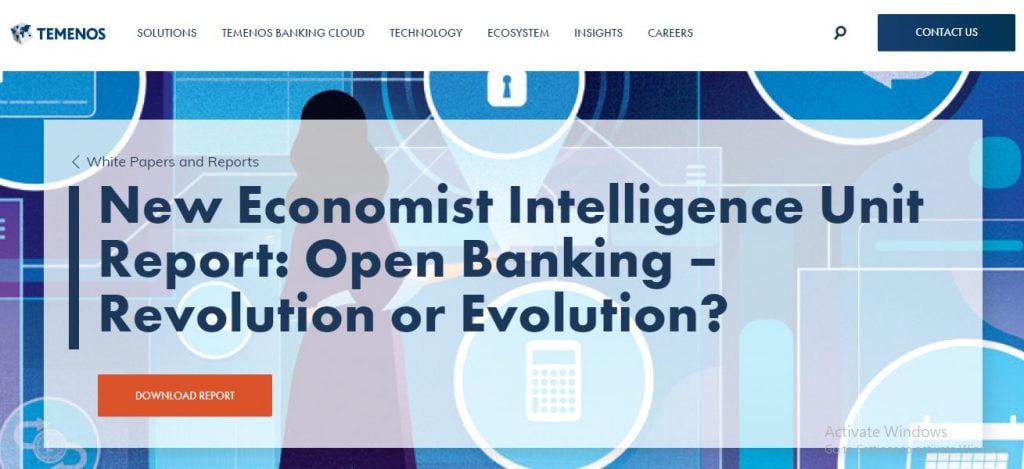
View the white paper
Zendesk is a corporation based in the U.S.. This company offers software for customer service, sales, and customer communications. Its white paper details customer’s experience in the company using engaging graphics and visuals.

Cognizant is a well-respected provider of technology services and consulting in the United States. This white paper explains the future of the IT industry using high quality graphics.

One of the most popular wrap platforms in the industry is Nucleus. Its white paper examines the present, past, and future states of financial planning.
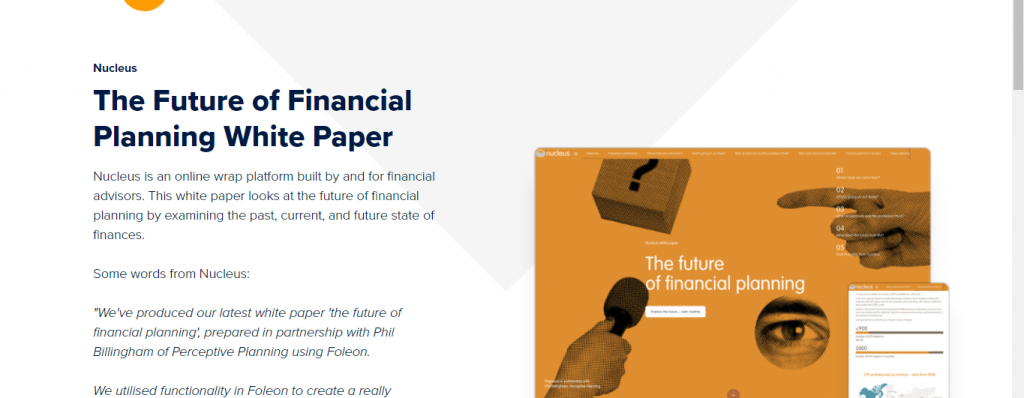
In this white paper, BDO, the world's largest provider of professional accounting services, managed to transform a technical subject into something that's both fascinating to read and entertaining.
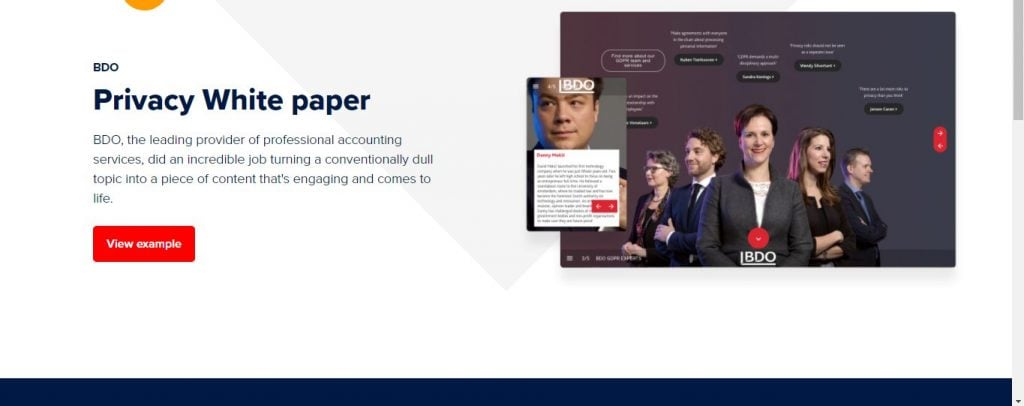
BBN, a leading B2B marketing firm, released a white paper that examines the effect and advantages of 5 distinct technologies on marketing outcomes.

Mdg has a high bar to meet as a well-known marketing-driven company. With the help of this well-designed white paper, it explains how to use the power of content to build year-round interest.

View the whitepaper
8. Cisco White paper
When it comes to networking gear, data security services, and other high-tech services and products, Cisco is unmatched. Its white paper on networking is a comprehensive 19-page text about using your competitive edge in marketing. It comes with visuals to match the company’s brand, and its tone is tailored for a specific demographic.

View the white paper here
9. ADP White Paper
ADP is a major player in the payroll and human resources software and services market. One of its whitepapers talks about dealing with payroll stress for small businesses. Many of its clients are small and medium-sized enterprises that do not have the resources to build up their HR teams to automate payroll. So, this white paper is highly valuable to their target audience.

In the risk assessment and management industry, Sungard AS is a well-known name to many. That similar authority may be seen in their white paper that talks about planning and developing a business continuity plan. The white paper is divided into four parts and each is discussed in detail.
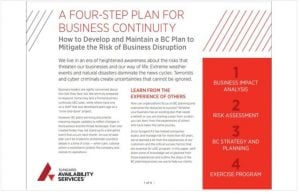
Tips on How to Write a Good White Paper
You can improve your white paper by following these design guidelines and best practices, no matter what software you use.
Create a catchy title
Your white paper's title is the first thing people see. Potential readers may not bother to read further if your title does not stand out.
It is possible to spice up a title by including a bold claim, a significant number or wording, a deadline, or a rapidly approaching promise. You can generate many potential titles before testing them.
Distinguish between white papers and other forms of writing
If you're producing a white paper, you're writing about a specific topic or discovery, not merely a case study. White papers are increasingly being distributed as interactive e-books, with numerous images, hyperlinks, and even interaction tools, rather than as static PDF files.
E-books promoting products and services are often shorter, contain bullet points or short overviews of the products/services, and may not follow the white paper's usual issue-solution-outcome (ISO) structure.
Keep your objective in mind
White papers' primary purpose is to generate and nurture new leads. If it is written correctly, a white paper may build confidence and lead to high-value sales meetings. Build a strong case for your concept by interviewing relevant participants and performing thorough research.
Use a conversational style of writing
Fear of writing is a common phobia among entrepreneurs. If you want to be perceived as trustworthy by your audience, you need to sound genuine and helpful. So, just write in a friendly, conversational tone.
There's no need to use lengthy, complicated statements or industry jargon. Hire an editor if you'd want your final copy to be more polished.
Add eye-catching visuals
It's essential to accompany a well-written white paper with an eye-catching design. Readability is enhanced by including visual aids such as charts, graphics, color, and a clean layout.
Including relevant graphics may make your white paper more readable and understandable. To increase brand awareness and trust, make sure the design aligns with your corporate identity.
Establish the credibility of your information
Using white papers , your business can highlight products and services and the advantages they offer to customers. It is not enough to say that your solutions are better than those of your competitors, mainly because everyone in your industry is making the same claim.
So white papers must be legitimate. Whether that data comes from a genuine client project or a study conducted by analysts, your product or service claims must be supported by evidence.
Avoid using marketing terminology in your content
The content of a white paper should be appealing, but it should not be hard-sell or jargon-loaded. The recommended solution should be supported by facts and logic in a white paper.
Businesses looking to hire marketing agencies look for a well-researched and balanced position supported by facts and data while reading a white paper . Present a well-supported case study to explain how your unique solution may benefit their company and ultimately increase sales.
Engage your reader's emotions
You must select a topic that connects with your target audience if you want people to be interested in your content. Bring in readers by speaking to their concerns and challenges, then focus on your solution's positive effects on the reader's professional and personal life.
You may excite and engage your audience by recounting the story of how you came up with your creative solution.
Do multiple platform promotion and testing
The more you engage your target audience, the more downloads your white paper gets. The most efficient way to get your white paper in front of your target buyer is to promote it on various platforms.
You need a well-designed landing page if you want people to download your white paper and provide their contact information.
Control the revision process
If you have circulated your white paper to many people for evaluation, you should still maintain creative control and make sure the paper's main points still stand.
The higher your capacity to exercise control over the process, the lower your stress level regarding the final output. It is possible to achieve this by placing the white paper on a collaboration site, like Google Docs, and asking for feedback from others.
Another choice is to send your white paper by email. Every piece of input should be kept in a single location, and the main document should be modified to incorporate any criticism and suggestions.
Final Thoughts
White papers are excellent tools for establishing a business’s capabilities. With the help of white papers, your marketing efforts can be strengthened while enabling your business to stand as an authority in your industry.
Customers are more receptive to well-written papers than they are to brazen advertisements. It is not an easy task to write an excellent white paper but the time and effort required to generate a paper that shares your company's expertise and contributes to the advancement of your sector are worthwhile.
If you follow the tips outlined in this guide, especially crafting a good title and providing value, you will surely gain your readers' attention.
What are examples of white paper?
Examples of Whitepapers often include charts, graphs, tables, and other ways of visualizing data that go into creating a whitepaper. The term “white papers” originated in England as government-issued documents. One of the most famous examples includes the Churchill White Paper, commissioned by Winston Churchill in 1922.
How do you write a white paper example?
Here’s how to write a whitepaper with easy steps:
- Pick a topic
- Conduct research
- Understand your target audience
- Build a whitepaper outline
- Write a catchy title
- Write the whitepaper and include subheadings
- Publish the whitepaper
What is included in a white paper?
A whitepaper is a heavily researched report on a topic of your choice. The goal of the whitepaper is to present a solution to a problem within the industry. Whitepapers are often written by companies to demonstrate their knowledge and understanding of certain topics and whitepapers will include facts and evidence.
What whitepaper means?
A whitepaper is a heavily researched information document on a certain topic. Whitepapers are usually written by companies or not-for-profit organizations to highlight a problem in the industry and propose a problem. They can also be used to present policies and legislation and gauge the public response.
How do you start a white paper?
6 Basic Tips for writing an amazing white paper:
- Pick an intriguing topic
- Be descriptive and include research but keep it informational
- Write a great headline
- Emphasize the value add
- Organize your draft
- Edit your draft multiple times and proofread

The Rise of User-Generated Content (UGC)
In recent years, the landscape of content creation has witnessed a shift with the...

13 Best Marketing Campaigns on Facebook
When you’re marketing on a platform like Facebook, where there’s an abundance of...

6 Examples of Viral Social Media Campaigns and What Makes Them...
Here’s an open secret: virality isn’t guaranteed. It may not happen, even if you’ve...
We use essential cookies to make Venngage work. By clicking “Accept All Cookies”, you agree to the storing of cookies on your device to enhance site navigation, analyze site usage, and assist in our marketing efforts.
Manage Cookies
Cookies and similar technologies collect certain information about how you’re using our website. Some of them are essential, and without them you wouldn’t be able to use Venngage. But others are optional, and you get to choose whether we use them or not.
Strictly Necessary Cookies
These cookies are always on, as they’re essential for making Venngage work, and making it safe. Without these cookies, services you’ve asked for can’t be provided.
Show cookie providers
- Google Login
Functionality Cookies
These cookies help us provide enhanced functionality and personalisation, and remember your settings. They may be set by us or by third party providers.
Performance Cookies
These cookies help us analyze how many people are using Venngage, where they come from and how they're using it. If you opt out of these cookies, we can’t get feedback to make Venngage better for you and all our users.
- Google Analytics
Targeting Cookies
These cookies are set by our advertising partners to track your activity and show you relevant Venngage ads on other sites as you browse the internet.
- Google Tag Manager
- Infographics
- Daily Infographics
- Popular Templates
- Accessibility
- Graphic Design
- Graphs and Charts
- Data Visualization
- Human Resources
- Beginner Guides
Blog Marketing 20+ White Paper Examples [Design Guide + White Paper Templates]
20+ White Paper Examples [Design Guide + White Paper Templates]
Written by: Sara McGuire Jun 28, 2023

There’s a reason why white papers are a marketing staple. When created right, white papers boost your authority, solve problems for your clients and stakeholders and act as powerful lead magnets.
But how to you create a white paper that will drive results? In this guide and with the help of Venngage’s White Paper Maker , you’ll learn how to write and design white papers that engage readers, impress clients and generate sales leads.
To add an element of enjoyment to the process, you can explore our collection of white paper templates that offer captivating and informative formats for narrating your story.
[Watch] How to Create a White Paper with Venngage:
White paper examples we’ll cover (click to jump ahead):
Business white paper examples, marketing white paper examples, government white paper examples.
- Policy paper examples
Research white paper examples
Hr white paper examples.
- White paper FAQ
Without further ado, let’s dive right in.
Businesses write white papers for a number of reasons. It’s a great document to showcase a company’s expertise in the field and to win over investors. A white paper can also be used for marketing purposes and brand awareness (which I’ll discuss in the next section ).
Here’s an example of a business white paper:

This business white paper example by Google aims to persuade the reader into adopting AI by leveraging Google’s authority. It also contains a technical deep dive for more advanced readers.
This is a perfect case of a business using white papers to demonstrate its expertise and establish itself as the thought leader in the industry.
To create a business white paper like this one, you can use a white paper template . Here’s an example of one:

Just so you know, some of our templates are free to use and some require a small monthly fee. Sign up is always free, as is access to Venngage’s online drag-and-drop editor.
This business white paper template discusses the importance of employee engagement and different strategies to optimize engagement in a company. A staffing consultancy firm could create a business white paper like this one to demonstrate its expertise.
Now, if you already have a draft of your white paper content, you can just copy and paste it to a template you like. (If you haven’t written it yet, here’s a white paper writing guide you should definitely check out!)
But how do you make the most out of a business white paper template like the one above? Let’s take a look at some design tips you can apply:
1. Create an eye-catching white paper cover page
Don’t underestimate the effectiveness of an eye-catching cover page. Like the cover of a book, a captivating cover page will entice people to open it and read it further.
At first glance, your readers should have an idea of what the white paper will contain. Use a photo that reflects the theme of your white paper, or create a visual using diverse icons .
Let’s check out a B2B white paper example on employee engagement. The two men on the cover could easily be a manager speaking with one of his team members.

Both look energized and engaged, indicating that this business white paper will offer valuable insight to companies looking to invigorate their employees.
2. Highlight key takeaways to summarize the information in your white paper

White papers tend to pack a ton of information within their pages. But in reality, many people aren’t going to take the time to read the whole paper cover to cover.
Try highlighting a few key takeaways that will get them excited about reading your white paper. Or outline exactly what they will trade their time to learn about.
As you can see in this white paper example, there’s a whole section that highlights the key takeaways in the report. Because it’s right on the front page, it’s hard to miss, which is a nice touch:

Pro Tip: Not sure which template is right for your use case? Venngage has a massive catalog of 500+ professional and engaging templates you can customize today. No more boring Word documents or endlessly struggling with expensive design tools. Browse our white paper templates.
3. Incorporate photos which resemble your target users in your white paper layout
Photos help create a connection between the information in your white paper and your reader. Using a photo on the cover also tells the reader what they can expect to find within the pages.
In this healthcare white paper template, the image of a child with a sugary dessert connects directly to the topic. The reader will instantly know what the paper is about.

If your goal with white papers is to promote your services and generate leads, your message needs to be memorable. Incorporating visuals resembling your target audience is one way to do so.
This content marketing white paper template depicts someone hard at work while downing a cup of coffee. The image would resonate most with professional marketers you’re trying to reach in a B2B capacity:

Businesses can use white papers as part of a content (and sales) marketing strategy such as lead generation . Most of the time, the white paper is gated — you need to insert your contact information before downloading/accessing the document. Here’s an example:

This white paper example by Frost & Sullivan (commissioned by Samsung Electronics America) explores the trends in the insurance industry. Specifically, it discusses the impact of digital transformation on this industry and how companies can deal with the change.
In order to access the white paper, you need to put in your contact information:

Now, let’s take a look at some more white paper design tips you can apply to make the best out of your marketing white paper:
4. Use high-quality photos with a consistent style
Photos, icons, and illustrations can play an important role in how effectively your white paper communicates information. It’s almost as important as knowing how to write a white paper that conveys information succinctly.
Don’t just use images for decoration. Instead, use photos to illustrate important concepts, to make information easier to understand, and to convey a mood. Marketing white paper examples, like this one, use bright, colorful photos to engage and excite readers.
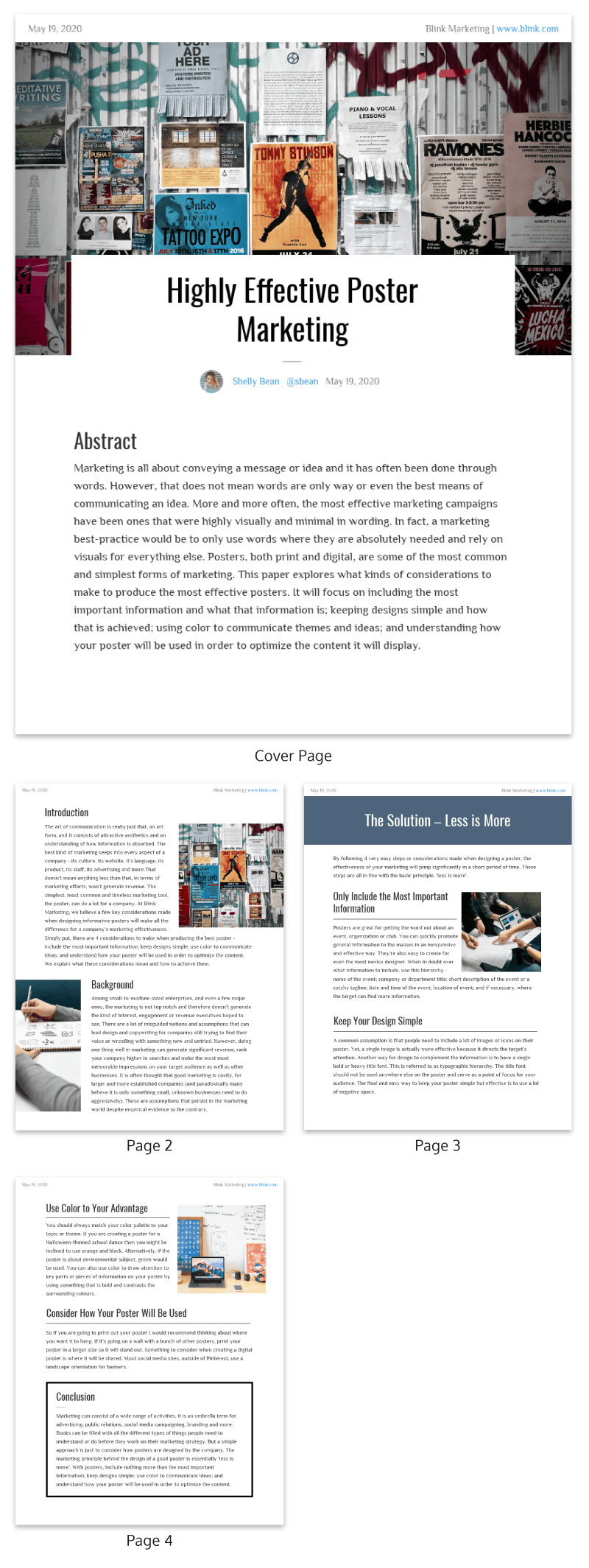
Venngage’s integration with Pexels and Pixabay makes it easy to find thousands of high-quality stock photos. Check out our guide to incorporating stock photos seamlessly into your design.
Pro Tip: Use Venngage’s image swap button to change the images in a template in just 1-click. Your images and icons will be replaced with a new image that is already formatted to the template.
5. Use a neutral color scheme for a modern technology white paper design
Say you want to create a white paper to introduce new technology or explain tech-based solutions to problems. A white paper design with a sleek, modern and minimalistic design will likely appeal to techie people.
Pick a neutral background color like white or light grey. Then, pick visuals with similarly sleek color schemes. Tech white paper examples like this use a cool and muted grey palette:

But a great way to add some visual appeal to your white paper layout is to pick an accent color that you can use to make parts of your page pop. For example, this content marketing white paper template contrasts two cool corporate blue accents:

Pro Tip: With Venngage, you can scale your white paper creation without sacrificing quality. How? Once you’ve created a white paper you like, save it as a template to reuse it again. Or hand the design reins to a team member. Want to create a white paper with your team? Our real-time collaboration feature (Business plan only) can help.
Learning how to write a white paper that speaks to your readers is important. For example, when selecting images for your white paper, keep an eye out for people who resemble your target audience .
This will help communicate that your white paper is actually relevant to the group you’re trying to reach.

That said, in some cases, including photos resembling your target audience might not make sense. If this happens, I’d recommend including non-generic stock photos or authentic product images.
This modern business white paper template uses real product images as well as authentic stock photos to give it that visual flair:
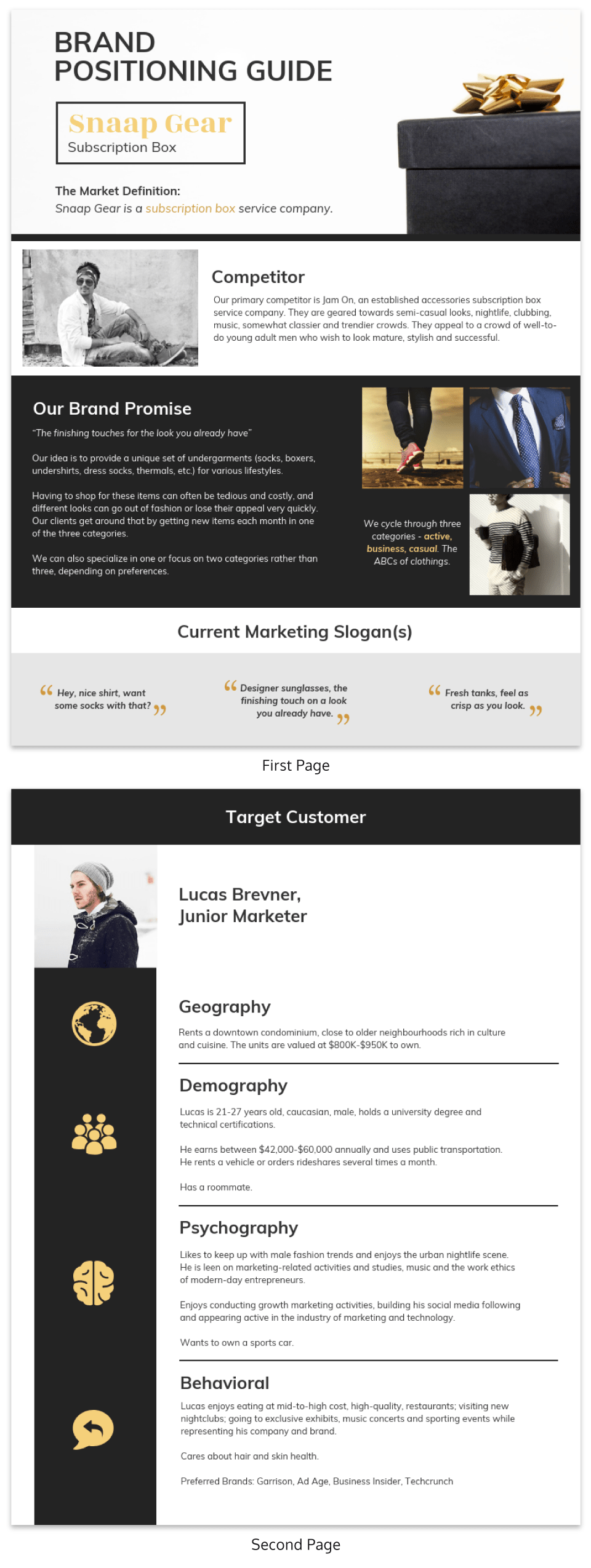
Pro Tip: Need help with creating personas for your target audience? Our in-depth user persona guide will help you quickly get upto speed.
6. Use creative backgrounds for a trendy white paper design
A simple design trick to make your white paper more engaging is to use the right background. You can opt for a simple background pattern design to add some visual impact to your white paper layout, or even try a trendy color gradient.
For example, take a look at how a color gradient background gives this content marketing white paper template some wow factor:

Here’s a simpler marketing white paper template that opts for a vibrant color gradient background but with simpler font choices to give it a sleek professional look:

Alternatively, you can use a different color gradient on your white paper template to make it stand out. Remember to keep your branding in mind when choosing the color combination so readers recognize the white paper as belonging to your brand.

It’s so easy to experiment with white paper backgrounds, so don’t be shy about trying out different options. With Venngage, you can change your white paper background with 1-click:

Pro Tip: Even if you don’t have any design experience (I don’t), the right background image can instantly make your white paper look more polished and professional. Keep this simple yet effective trick in mind, so you can create white papers that captivate readers.
7. Include calls to action throughout your white paper
If you’ve been wondering what makes a great white paper, it’s the strategic use of calls to action (CTAs). It’s an important part of understanding how to write a white paper that readers will engage with.
In a white paper, there are plenty of opportunities to position your product or service as a solution to your target audience’s pain points. This means that there will be ample opportunities to include CTAs throughout your white paper.
For example, if you mention a feature of your product, you can place a clickable CTA button beside it:

CTAs are a great way to move people through the sales pipeline , from your white paper to a landing page or blog post.

Governmental organizations write white papers to outline policies before proposing new bills and legislations. A white paper is a good tool for gathering feedback from the public before implementing wide-reaching policy changes.
This is an example of a government white paper:

There are a lot of ways you can make your government white papers more engaging. Here are some design tips:
8. Make your page numbers stand out so your white paper is easy to scan

When designing your white paper, it’s important to keep your readers in mind. Don’t just think about what they want to read, but how they want to read it.
Your white paper isn’t the latest installment of Stranger Thing s , so it’s unlikely that every reader is going to sit down and read it cover to cover. In fact, there’s a good chance they’re going to want to skip ahead to specific sections that interest them.
Making your page numbers easy to read will be appreciated by your readers who are trying to locate a particular topic in your white paper.
Take a look at the page numbers in this policy white paper template:

The above government white paper template can be used by a government to communicate complex social, political, and economic issues to an audience.
Healthcare white paper templates, for example, can be useful in proposing healthcare policies to the general public.
Governments can distribute healthcare white papers to communicate crucial healthcare policy changes to residents in an easy-to-read and accessible format (just like the one above by the American Heart Association).
The white paper example below has a format that’s easy to customize for any industry. Its straightforward table of contents and simple design elements keep the focus on the text.
Go ahead and customize this template with our intuitive drag-and-drop editor:

You can create a functional table of contents by adding hyperlinks to individual chapters and sections. This will help your readers navigate the white paper’s contents.
Select the text you’d like to turn into a link, then click the link icon in the top bar. Along with the option to add a URL, you can select pages within the eBook. When you download your design, download it as an Interactive PDF .

9. Highlight themes in your white paper template using icons
This white paper template, from the cover page onwards highlights the cybersecurity topic it is focused on — phishing scams — by using a hook icon. The cover also introduces a circle motif that is used throughout this technical white paper, to give it a cohesive design and summarize information.

Pro Tip: Do you work in a boring industry? Whether you’re in finance, law or health care, you can set yourself apart from the competition by creating engaging, yet informative white papers. A well-designed white paper can give you an unfair advantage when it comes to making technical information easy to understand and positioning the value of your business.
Policy white paper examples
Good policy white paper examples include a brief description of the scope of a problem or issue to be discussed, alongside recommendations.
This policy white paper from the Australian government is a good example:

Policy papers also include data to give context to issues. The Australian policy white paper above includes a bar graph describing the percentage of Australians born overseas to illustrate the country’s multicultural societies:

On that note, here’s some ways to best incorporate data visualizations to your white papers:
10. Visualize your white paper data using charts and pictograms
A common problem that marketers and consultants face when creating white papers is finding a way to make the data engaging and easy to understand.
The solution? Visualize your data using charts and pictograms.
While everyone on your team is busy creating boring Word documents, you can be the creative genius that uses charts and pictograms to create visually engaging white papers.
The type of charts you use will depend on the type of data you’re visualizing. Here’s a guide to picking what types of charts to use that can help you there.
You could use a line graph to show revenue growth over time . Or you could use pie charts to show parts of a whole, like in policy white paper examples such as this.

Pro Tip: With our online graph maker, you can create charts and graphs that are more creative and engaging than standard Excel charts. A plain old bar graph won’t do much to inspire anyone, but a creative chart that tells a story can.
Pictograms are also a creative and effective way to visualize statistical data. Take a look at how pictograms are used in technology white paper examples like the below. They act as visual aids to showcase key statistics and changes as it relates to the IT sector.

Don’t be afraid to mix it up. They say variety is the spice of life — the same can be said of white papers! This business white paper design, for example, combines both bar graphs and pie charts.
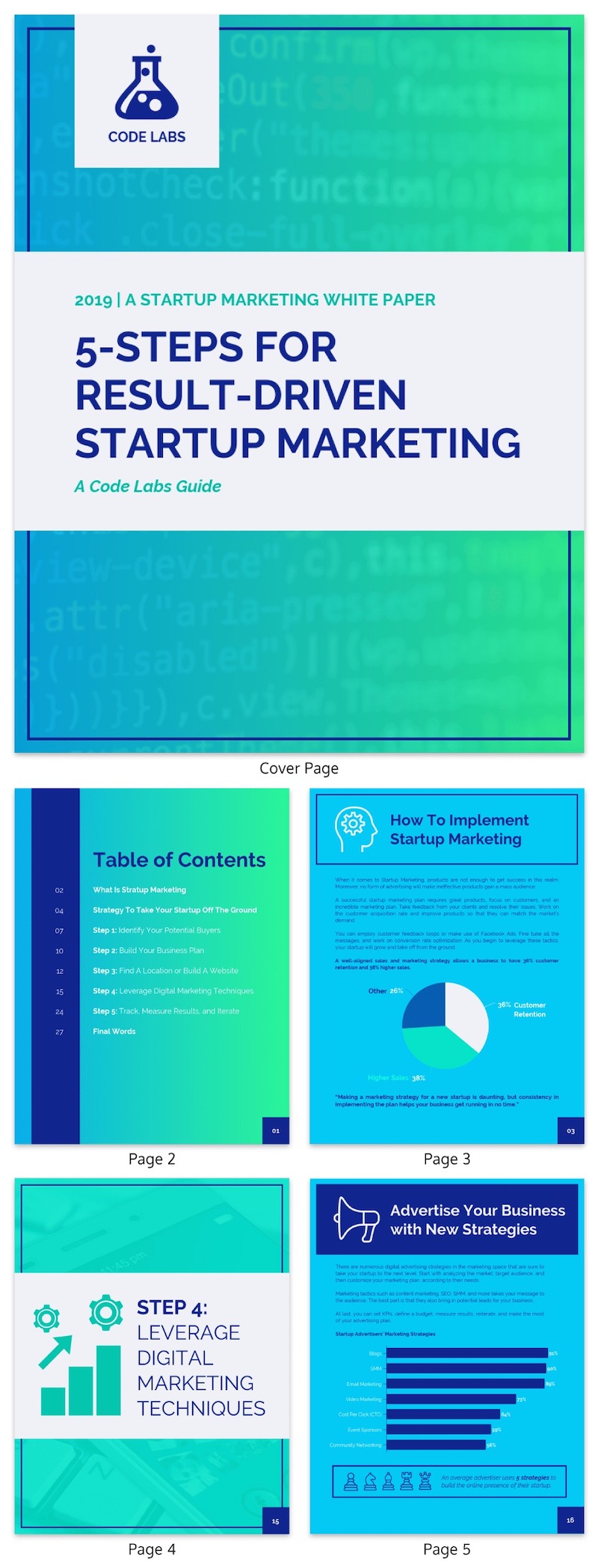
For more ways to add data visualizations to your white papers, check out this post: How to Visualize Data In Your White Papers
Just like other white papers, research white paper examples include reported facts and data aimed at educating readers around a particular topic. Research white papers are also written to help readers understand and address specific problems.
If you’re writing a research white paper for your business, here’s some ways to make it more engaging:
11. Highlight featured quotes using a big font

This is a design trick you’ve probably seen used in magazines and news publications. Well, guess what — it works great for white paper design as well! Pull particularly impactful and persuasive quotes and make them stand out from the rest of the text using big, bold fonts.
Not only will this draw readers’ eyes to the quotes, but it also gives your page design more visual variation. Company white paper examples like this one use a bright orange font to help their featured quotes stand out.

Human resources white papers tackle issues around employment, management, employee retention and churn. HR white papers can also be used to attract potential employees by showcasing the company culture and ethos.
12. Incorporate your branding into your white paper design
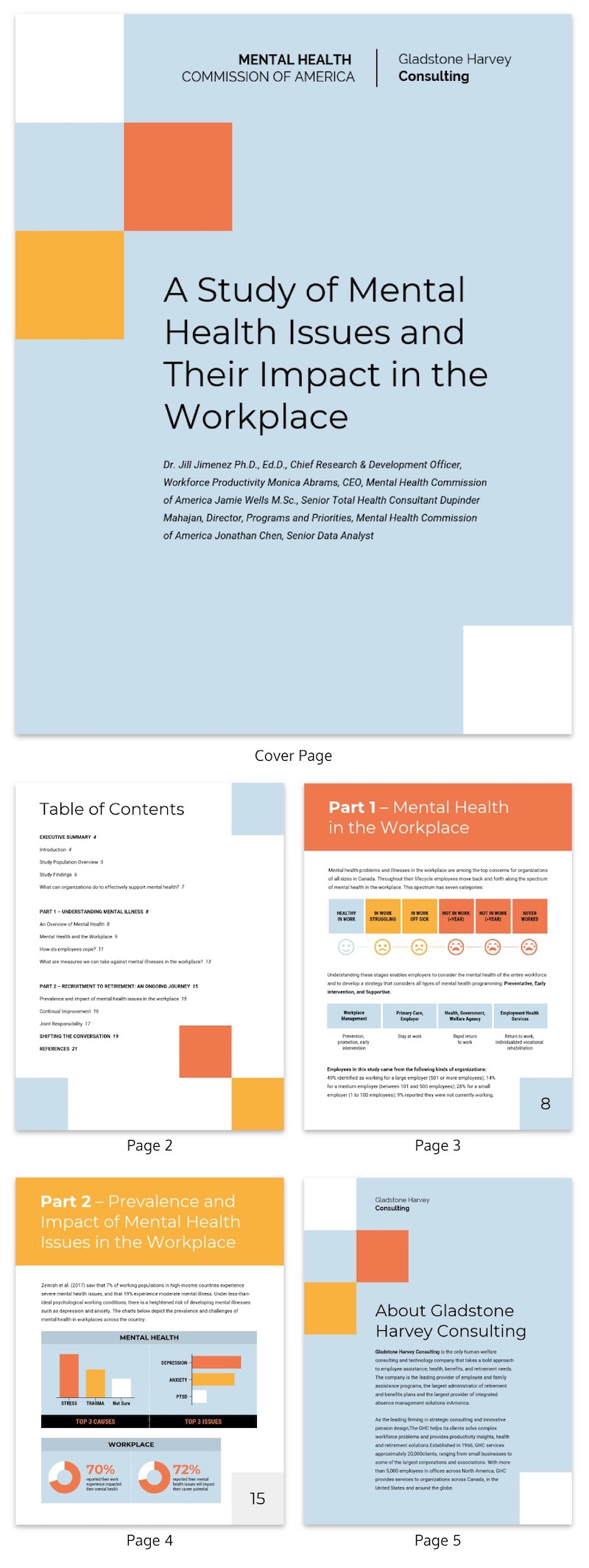
To improve brand recognition , you need to have consistent branding across all marketing collateral. This not only helps your marketing efforts but also helps you maintain consistency in your internal and external comms.
Be sure to incorporate your logo , brand color palettes, and fonts into your white paper design.
Venngage’s Brand Kit makes it easy to save your logos, brand color palettes, and brand fonts for later. Then, you can easily apply them to your designs with one click. No designer needed:

Try thinking of creative opportunities to incorporate your branding . This white paper design, for instance, extends the use of its signature color beyond standard headers and icons.
It actually applies a transparent color overlay to the images, adding an additional punch of color and reinforcing its brand palette in an unexpected way.

Pro Tip: Need help with creating your own brand-style guide? Our guide on brand guidelines will help you create brand collateral that will dictate the look and feel of your brand and in the process, help you stand out from the herd.
13. Use icons to emphasize section headers in your white paper template

One of the primary purposes of a white paper is to visually communicate information in an engaging way. But many businesses end up creating something that reads like a college textbook. No one wants to read that…just ask any college student.
TechSmith studied over 4,500 office workers and found that people absorb information 7% faster when they’re given text with accompanying images, versus just plain text. When designing your white paper, look for opportunities to make the text easier to scan with visuals.
An easy way to bring attention to important points is to place an icon beside the text. Government white paper examples like the one below are text-heavy. But the icons help direct the eye to each section header and break up the text.

This marketing white paper layout uses icons to punctuate the headers and add a dash of personality to reinforce its fun and lively color palette.

Here’s another example of a white paper design where icons are used to visualize points and make information easier to find.

14. Use a visual motif that reflects your white paper topic
A visual motif is a visual element that is repeated throughout your design. When you’re designing a multi-page document like a white paper or a report, your pages should have a cohesive look and flow.
To pick a motif for your white paper design, think of some themes reflected in your white paper. Is your white paper about social media engagement? Then a motif of birds (“tweeting”) or speech bubbles could work.
A white paper topic that is focused on establishing a sprint process could use a race track motif instead.
Hiring strategy white paper examples like the below use a leaf motif. Plants reflect the theme of growth associated with recruitment.

Or you can also use a simple shape motif throughout your white paper design. This approach is more subtle but can still lend to a cohesive and well-thought-out white paper design.
For example, this simple white paper template uses a hexagon motif (it kind of makes you think of a beehive, doesn’t it?).

15. Break up chunks of text with visuals when writing a white paper
When you’re laying out your white paper pages, put your storytelling cap on. Think: what kind of flow do I want my report to have? Where can I use visuals to emphasize certain points? Where can I illustrate an idea?
A common mistake novice designers make is to cram too much text into a page, rather than breaking up the text and giving it space to breathe.
Don’t hesitate to dedicate big chunks of your page–or the page in its entirety–to pictures. Images give the eyes a rest and help to reinforce information.
Visual headers are also a great way to break up expanses of text while still having the visuals serve a purpose (yay for purposeful design!). You can create your own illustrations using icons–they can make for some fun and quirky headers, like in workplace tech white paper examples.

16. Open your white paper with a boldly colored glossary

Like any design project, it’s important to start off on the right foot. You can do this by creating a glossary for your white paper. Think of it as a map that outlines exactly what your white paper will cover.
In bright white paper examples like the one below, you can see how the designers used a bold color to bring attention to the glossary. This ensures that it will be seen by a reader, and actually used to navigate the content.
If you make your white paper design engaging, a lot more people are going to want to read it:

Try using a full-page color fill (like in this white paper example) for your glossary. Otherwise, readers may miss it when quickly flipping through the pages.
17. Include tables and boxes to emphasize key points and takeaways

Visualizing information or data isn’t limited to just graphs. When writing a white paper, you can also section off important pieces of information using tables and boxes.
In the white paper examples below, the designers used a table to organize key points and takeaways from each main section:

Here’s another example of a white paper layout that uses a table to highlight some key statistics:

Breaking up lengths of text with boxes will help make your white paper easier to read:

18. Vary the color, fonts, and styles of your headers

You can create a hierarchy by using a different font or color for your headers and sub-headers. This also helps give your page design more variety.
In this example, they use different fonts and colors for each level of header. This helps make the distinction between main and sub-headers more noticeable.

Your main design goal should be to create a white paper that’s engaging to readers and easy to navigate. When you are working with this much text, it’s important to make it easy to skim through.
19. Dedicate pages to particularly important points

The primary goal of your white paper should be to educate readers. But you also want to strike a balance between being informative and entertaining.
If there is a central point that you want readers to remember, you may want to dedicate an entire page to that one point and an accompanying image to help drive the message home.
Pages like this should be used sparingly. That being said, they can deliver some real impact to readers.
Take this white paper example that dedicates a page to an evocative quote and photo:

20. Allow for plenty of white space on your pages

Unlike one-page reports where you have to fit a lot of information into a small space, white papers allow for more freedom to spread the information out. That will allow you to create page designs with plenty of white space.
In the design world, white space is the empty space around design elements on the page. Leaving some room for your text and images to breathe will help your design look less cluttered.

Check out how this example uses plenty of white space on nearly every page. The result is an organized and modern white paper design.
21. Break chapters or sections into separate columns

Dividing your page into columns is a good way to organize your information and save space on the page. For example, in the white paper above, the Overview and the beginning of Chapter 1 are organized neatly into their own columns.
This makes it easy to jump from one point to the next, without getting lost.
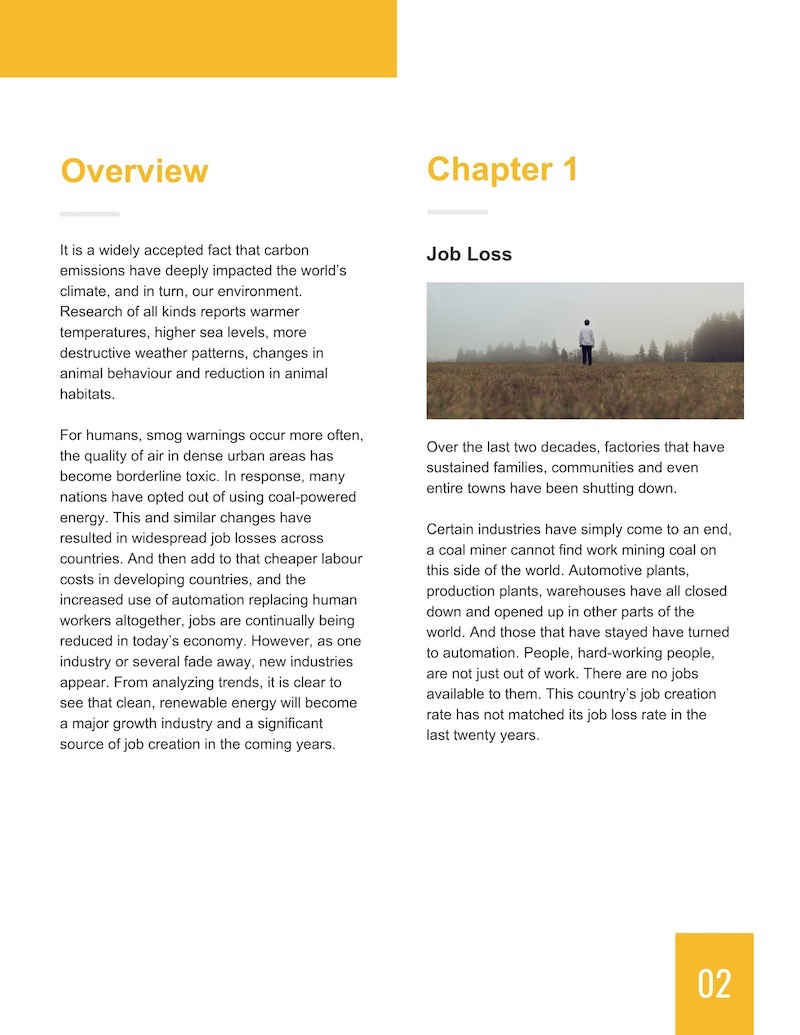
22. Include a question on the front page of your white paper

Speaking directly to your readers can really grab their attention. Asking a question can get them to want to actually read your white paper.
In this white paper example, a simple question to the reader introduces what the report will cover. The designers even bolded it so it was the first thing readers would see!

Now they could have just said “We are going to cover Topic X” on the cover. But that doesn’t place their white paper in the perspective of the person it’s meant to help — the reader.
On the other hand, when you address a common problem people in your niche face, that will pique their interest.
23. Vary your page layouts to keep readers engaged

When people look at the same thing over and over again, it can cause visual fatigue. Their eyes glaze over and their attention drifts.
Varying your page layout will help keep readers engaged by going against their expectations. When the eyes have something new to look at, it’s easier to stay engaged.

This white paper template uses a few different page layouts. One page may have a featured image, another a large quote, and the next only includes written content. This white paper layout is fresh and interesting.
Use these white paper examples to create a design that reflects your brand
Use these examples of white papers as springboards for your own unique and brand-appropriate designs. Knowing how to write a white paper that considers your audience every step of the way will help you develop the perfect response to their questions and make your designs accessible .
FAQs about white papers
What is a white paper.
In the business world, a white paper (or whitepaper) is an in-depth informational report that explains a complex or technical concept in addition to providing a persuasive solution to a problem.
For example, here’s what a technical white paper looks like:

Unlike ebooks , which may address a broader scope of topics, white papers have a singular focus. They’re designed to solve a specific problem for readers and build brand trust in the process.
White papers are also research-based and widely considered to be a valuable resource. In fact, Equinet reports that a whopping 75% of B2B would share information about themselves and their company in exchange for a white paper.
What is the format of a white paper?
White papers can be formatted in any number of ways, but depending on your industry, you may want to consider formatting your white paper for printing on standard printers. In that case, it’s best to stick to a letter-sized page, whether in portrait (8.5×11) or landscape (11×8.5).
These documents also are best in the PDF file format; this is the easiest way both to share them online and to have them printed.
Why should you create a white paper?
White papers can be extremely valuable documents to educate your stakeholders, clients, and top-of-funnel traffic — when the white papers are actually interesting. According to the Demand Gen 2018 Survey Report , 71% of B2B buyers used white papers in the last 12 months to research purchasing decisions.
How long is a white paper?
Typically, white papers are around 3 to 20 pages long. But some white papers can be longer. A white paper should be long enough to cover the concept or problem at hand. Since this usually includes case studies or new research, plus explanations and analyses, a good rule of thumb is writing white papers to provide enough evidence to back up your claims.
How to write a white paper that people will actually read?
If it doesn’t have an appealing design, your white paper probably isn’t going to work as well as you want it to. As with any type of content — from writing blog posts to making presentations to crafting ebooks —a lot of your white paper’s success comes down to the design.
Take this eye-catching hiring strategy white paper example; it uses dramatic images, colors, layouts, and icons to elevate its content to another level.
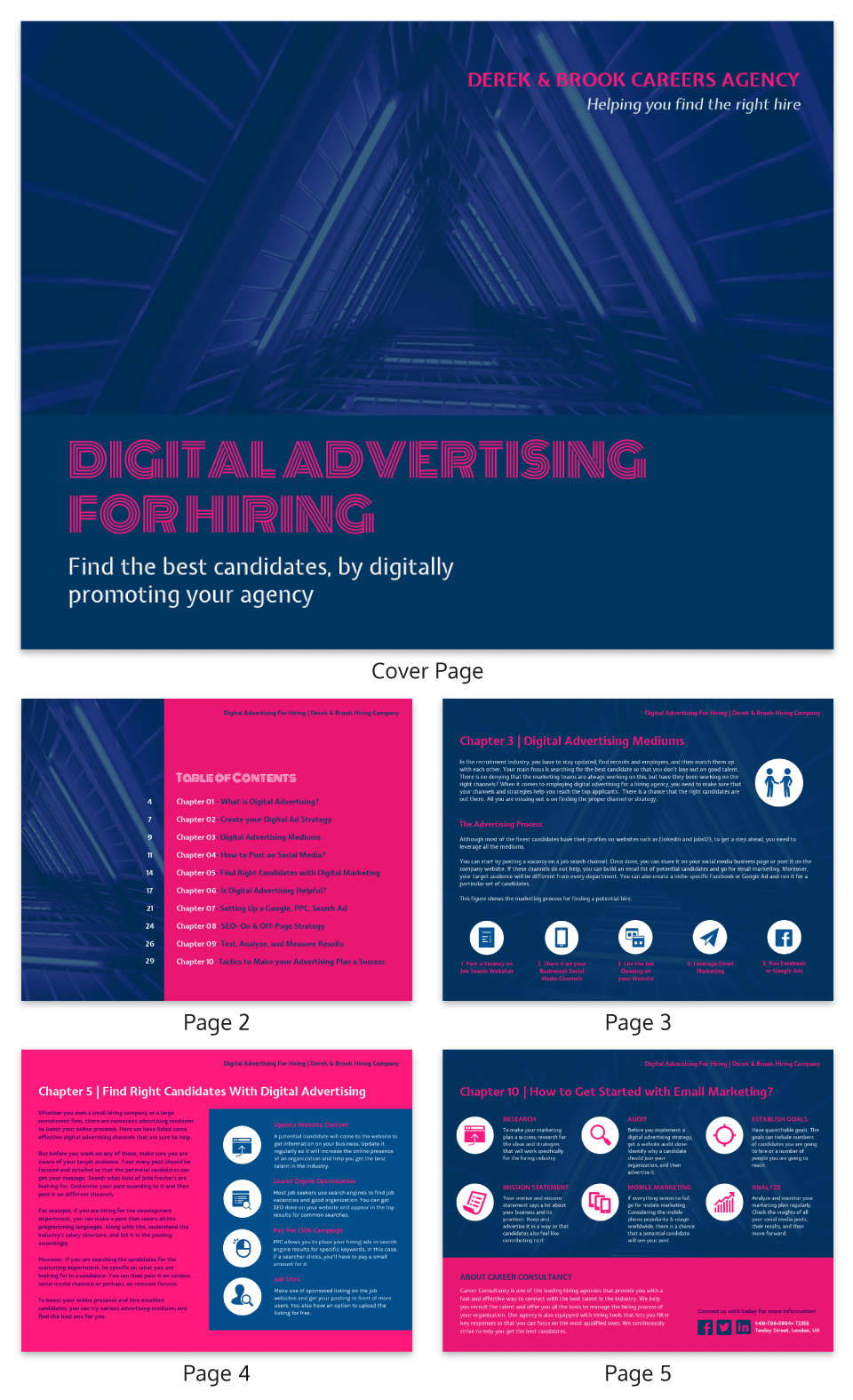
How to format a white paper with design in mind:
- Make sure your cover page immediately informs readers what your white paper is about.
- Summarize key takeaways at the start after writing your white papers.
- Don’t forget to think about your readers’ experience. Use clear page numbers to make it easier to scan your white paper.
- Visualize your data to make your white paper more engaging.
- Use consistent brand colors and fonts throughout your white paper format. This will make your design look more polished and professional.
- Use high-quality photos with a consistent style.
- Keep your target users in mind throughout the design process. If you’re using images of other people make sure they resemble your target users.
- Emphasize section headers in your white paper with icons.
- Break up walls of text with visuals like infographics and charts.
- Use a glossary to outline the specific topics you aim to address.
- Incorporate calls to action throughout your white paper design.
- Format your white paper to allow for plenty of white space. This will prevent your white paper design from looking cluttered.
- Switch up your page layouts to keep readers interested.
This article is also available in Spanish Más de 20 Ejemplos de White Paper Increíbles [Guía de Diseño + Plantillas] and Portuguese White paper: mais de 20 exemplos cativantes [guia de design + modelos]
You might also be interested in some of these helpful design guides:
- What is a White Paper? 15+ White Paper Examples to Get Started
- How to Write a White Paper (Tips & Templates)
- How to Visualize Data In Your White Papers
- What is a Marketing Plan & How to Create One [with Examples]
- 90+ Annual Report Design Templates, Inspirational Examples & Design Tips
Discover popular designs

Infographic maker

Brochure maker

White paper online

Newsletter creator

Flyer maker

Timeline maker

Letterhead maker

Mind map maker

Ebook maker

Buzzy AI Assistant
I'm HIVE's AI assistant and I'm here to add a dash of nectar-sweet fun to your day! Whether you're navigating just for information or looking for a partner with your marketing needs, I'll be your guide on this whimsical journey. So let's make a beeline to adventure and turn your experience into the bee's knees! 🐝✨
Let Buzzy ...

How to Write a White Paper: 5 Essential Steps
Trying to decide which CMS is right for your website?
If you've read much of our content, you know that we're big believers in high value content and some of the most powerful pieces of high value content are white papers. White papers are great tools to generate new leads and educate your prospects, but they have to be valuable and well written. So today we're going to teach you how to write a white paper.
Of course, after it's written you should design and brand it for your company, place it behind a form to generate leads and follow up with those that download the content in order to nurture them into becoming customers. Now, let's dive into our five steps to writing a white paper!
1. Research Your Target Audience
Before even beginning to write a white paper, you need to know your target audience . Your content is essentially a waste of your time if it's not targeted at your buyer personas. Every single thing that you do should relate back directly to your target personas.
In order to get a better idea of who will read and make use of the information in the white paper, you'll need to do some thorough research before you ever write a word.
Once you develop your target personas, you'll learn what your prospect's problem is and how you can meet their needs through the white paper.
Then, you can use this data to offer your company or product as a solution to their problem.
2. Choose an Attention-Grabbing Title
One thing can make or break the success of your white paper, and that is mastering the headline .
Your title has to be precise, clear and catchy in order to generate interest. Your title should be one that you believe that your target persona(s) would be interested in and should be honest. One of the best ways to let your prospects down and tarnish your reputation is to promise something in the title that you don't deliver in the content. Avoid click-baiting at all costs!
3. Identify and Present the Problem
This part of the white paper must be the highlight of your content. It's where you outline the problem your audience has and provide facts, data and your point of view.
It's a space to show them you're an expert in your field and you know exactly what you're talking about and how to solve their problem. The readers need to trust you before they buy from you and that trust is built from your expertise, honesty, and ability to help your prospect fix their problems.
4. Propose a Clear Solution
Now that you've explained the problem in detail, it's time to deliver the solution.
The best way to offer the solution is through a step-by-step approach, using bulleted lists or subheadings. This is also a great way to approach most of your content. Think about it - how many posts, white papers, or any other content do you thoroughly read every word? Probably not many. Providing a bulleted or segmented piece of content allows your prospects to skim it and even helps them get right to the piece of your content that they're most interested in.
PRO TIP : Remember to deliver valuable content , not generic information. There is nothing more frustrating for a prospect than downloading a piece of content that they think is going to be helpful only to realize that it's all fluff.
5. Add Visuals, Examples, and Resources
Although white papers are longer in form and complex in content, you should still make them easy to read and digest.
You can do this by adding visual components such as images, graphs, tables or charts. Also, use real-life examples in the text and state your resources and works cited in the paper. While white papers should not be overly visual, there is something overwhelming about a white paper with no visual elements, only text.
The Bottom Line
Like anything else, learning how to write a white paper takes some practice and planning. Your second white paper will likely be better than your first and your third will be better still. The key is to continue to publish great content for your prospect, measure its success, and produce new content.

Find Out How HubSpot Can Help Your Business Grow Better!
Download our free HubSpot one-pagers and get the inside scoop on all things HubSpot.
Latest Blog Posts

Demystifying Account Based Marketing: It's Not Magic, It's Strategy
Account Based Marketing (ABM) often appears to be a mystical concept to many marketers, but in actuality, it is a strategic and targeted approach that hones in on high-value accounts. This blog post aims to dispel any misconceptions surrounding ABM...

Account Based Marketing: The Secrets of Killer ABM Reporting
Are you tired of B2B marketing feeling like a scattershot approach? You and thousands of other savvy marketers also share the same sentiment. No more wasting precious resources on unqualified leads. It's time to ditch the generic tactics and laser...

Digital Marketing Agencies and AI: How Can They Work Together?
Author David De Cremer and Chess Grandmaster Garry Kasparov answered the following question in a Harvard Business Review article: Will smart machines replace human workers? Their answer was, "Probably not. People and AI both bring different...

How to Write a White Paper – A Simple Step By Step Guide
One of the best ways to make more money as a freelance writer is to offer different types of writing services.
Learning how to write a white paper is a great way to take your business to the next level .
This is a type of marketing tool that businesses use and it can help you make a living as a writer.

But, writing a white paper isn’t the same as a blog post or even writing an eBook.
It’s also not a case study or journal article.
What is a white paper, and how do you write one?
If you’re a new freelance writer, I want to help you start on the path of success and white paper writing can take you there.
In this post, I’ll share with you what a white paper is, how to write a white paper, give examples, offer a white paper template and more!
And just so you know, you don’t need to have experience in writing white papers to declare this as a new freelance writing service!
Many of my course students are presented with this project after writing for a client, and it has opened the doors to new high-paying projects .
But, it’s always nice to get some help on this new type of writing!
What is a White Paper?
The white paper definition is an official report – or government report – which shares the company’s message and informs their potential customers about a complicated issue in an easy-to-read, but highly formal format.
When looking at this definition, you can see that a white paper presents an issue or problem to help the reader understand the issue, and shares a solution to help readers make a decision.
So, a white paper is to inform and educate.
This can be viewed as similar to writing a simple blog post. In a blog post, you are presented with an issue or problem, and the blog post walks you through a solution to help you make a decision.
But, there are critical differences to writing a blog post and writing a white paper:
- A blog post is highly conversational; a white paper is highly formal (think like a mashup of a magazine article and a brochure)
- A blog post is generally short in length; a white paper is usually longer than a typical 800-word blog post
- A blog post doesn’t have to include highly credible sources; you may need to cite a white paper
The purpose of a white paper is also different than a blog post –
A white paper is a lead generation tactic to help businesses gain leads.
What this means is that it helps businesses with improving their conversion rates, closing rates and qualification rates.
They are usually offered as a lead magnet – a free incentive – and marketed on their company site on landing pages .
An important distinction between white papers and other lead magnet guides is that a white paper is data driven and is researched-based. This makes them highly credible, and highly optimized for conversions.
The trick for a freelance writer is to present this research-based report into a magazine-style package that we call a white paper.
And when businesses have optimized white papers, they show and establish their authority in their industry. As a writer, you can help them achieve that, making you a highly valuable resource on their team.
This translates into more money as a freelance writer .
White paper rates vary from as little as $2,500 to upwards of $10,000 for a 5-18 page white paper.
In fact, some freelance writers are making $300k a year writing white papers .
It can even be more profitable than ghostwriting .
So, it’s in YOUR best interest to know what a white paper is and learn how to write a white paper!
To help you understand more about writing a white paper, let’s look at some examples.

White Paper Examples (+ The Most Successful White Paper Example)
Big companies often use white papers to inform and educate their customers or huge brand customers about their platform and products. This is to help other brands become familiar with a company’s product.
For example, Google’s white paper covers the Google Cloud platform products and security policies.
It has a table of contents and is presented online or can be downloaded as a PDF.

Another white paper example is from Hyperledger. They are a blockchain technology company, and their white paper discusses blockchain terminology and performance metrics.

In the health niche, Labiotech has a white paper on the human microbiome. In this white paper, they want to shed a new explanation on health and disease from a microbiome perspective.
As you can see, they are using this white paper as a lead magnet to gain subscribers to their email list.
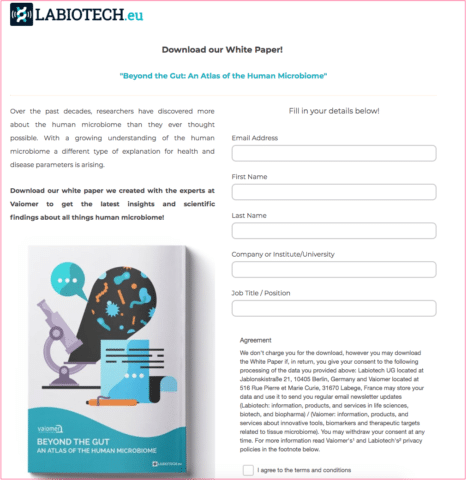
Officemorph’s white paper reads more like a magazine article but is presented in a formal manner. The audience is also different than for an office supply magazine.
This white paper’s audience is office managers and executives.

As you can see, each white paper example is different in the context and type of audience.
And, what’s the most successful white paper that has ever been written?
The Bitcoin white paper by Satoshi Nakamoto (pseudonym)! This helped start the cryptocurrency industry get off the ground.

Types of White Papers
There are several types of white papers a freelance writer can write. The most common types are:
- Overview – This is a product-based white paper that showcases the features and benefits of the product. This type of white paper highlights a product and helps educate a customer on how to use this product.
- Comparison – This white paper compares products to help a customer decide which is the best option for them. These types of white papers are usually promoted towards the end of a sales cycle, when a potential customer is already interested in a product but doesn’t know which one.
- List – This type of white paper is the most similar to a blog post or article. A list white paper gives a reader tips or examples in a list format, making it an easy read.
- Solution-Based – This presents a problem in the company’s industry, current solutions that aren’t working and offers a new solution or approach that works better than any of the other solutions mentioned in the white paper.
White Paper Template
Here is a simple white paper template that you can use to start writing a white paper for your freelance writing job. There are two parts of this white paper format.
The first part is what to include at the beginning of your white paper, and the second part mentions more about the way you structure a white paper and how to end your white paper.
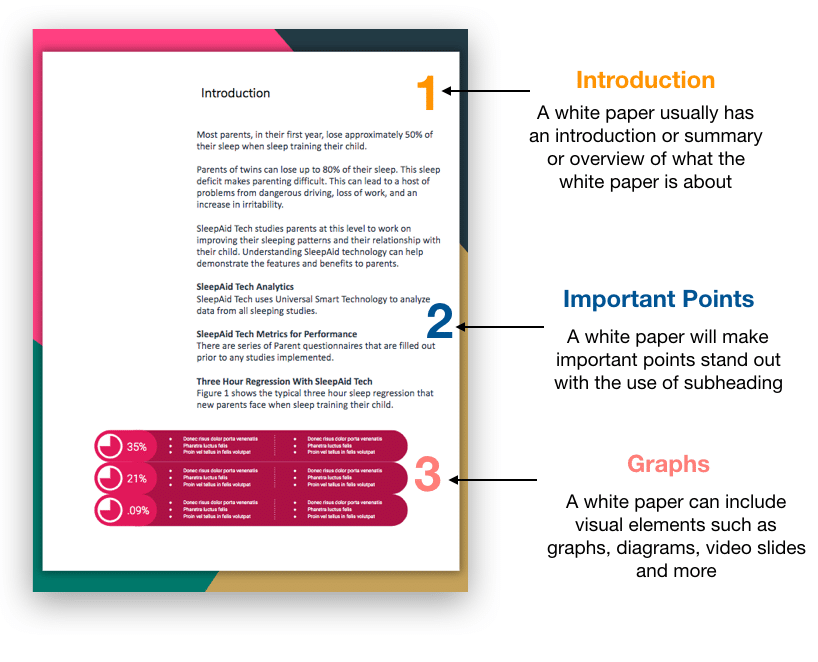
1. Table of Contents/Introduction
Lengthy white papers make use of a table of contents. I didn’t include this in my mockup template, but it might be a good idea to add if your white paper is long.
The introduction can be a summary of the entire white paper or an introduction to the problem or product mentioned. For the mockup white paper example, I used a fictional SleepAid Tech company, and the paper demonstrates their products and the features and benefits of each product.
2. Important Points
In my introduction, I specify the problem and what the company’s products do to help alleviate this problem.
I then make important points by using subheadings to emphasize that performance, analytics, and a three-hour sleep regression are essential to understanding the product.
When you write a white paper, you can use visual elements such as graphs, diagrams, and even video slides (if the white paper is a slide presentation).
For this fictional white paper template, I used a diagram to show the results of the sleep regression study.
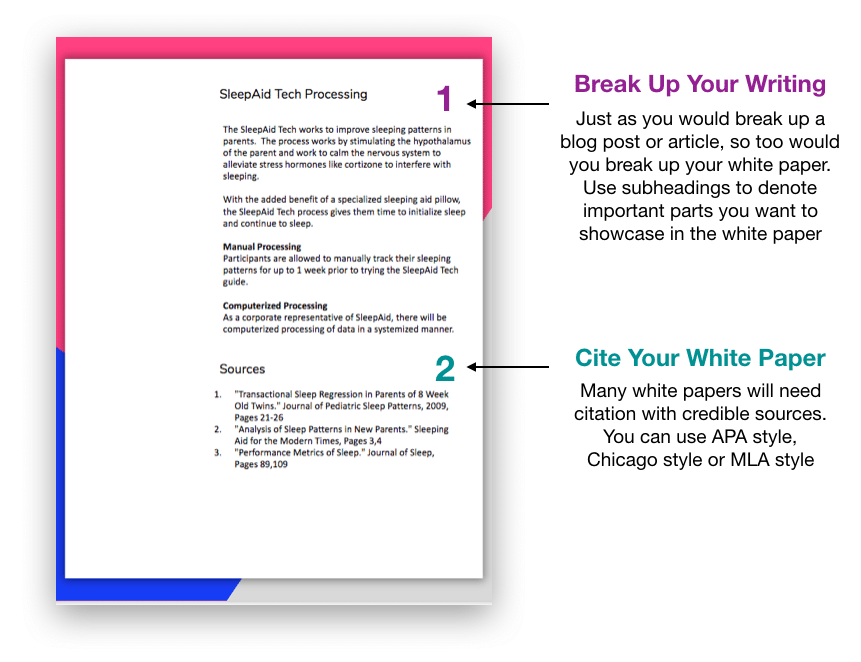
4. Break Up Your Writing
Just like any other type of content, you might write for a client, space out your writing, and break it up with subheadings and visuals.
Some white papers are double columned to break up the writing, but in general, use subheadings to note important topics in your white paper.
5. How to Cite a White Paper
You can end your white paper in many ways –
- Conclusion paragraph
- About company paragraph
Some white papers will need you to cite your sources. There are three styles to citing your white paper – APA style, Chicago style, and MLA style.
Make sure to ask your freelance writing client which citing they want for their paper and if they wish to have in-text citation as well.
Here are three videos that walk you through citing your white paper.
How to Cite a White Paper Using APA Style
How to Cite a White Paper Using MLA Style
How to Cite a White Paper Using Chicago Style
Free Citation Generator
You can use free citation generator tools to cite your sources quickly whether they are books or websites. Here are three free citation generator tools.
- Free Harvard Citation Generator
- Vancouver Referencing Generator
- Mendeley Citation Guides
How to Write a White Paper
The steps to writing a white paper are similar to writing a blog post or article. You have to research your topic from credible sources and use formal writing to write your post, ensuring that you are speaking in the appropriate language for your client.
Finally, you need to add the elements to ending your white paper. So, let’s dig deeper and talk about the way to write a white paper.
1. Where to Write Your White Paper
There are generally two places you can write your white paper – Microsoft Word or Google Docs.
I prefer Microsoft Word, but if your freelance writing client wants you to use a template, then Google Docs has several templates you can use. Or, if you prefer, Venngage has some beautiful white paper templates you can use for free.
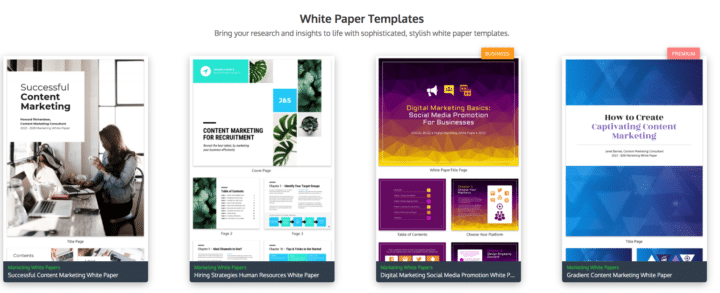
I would also ask the client if they specify APA, MLA, or Chicago style of writing or just to use for the reference section of the white paper (if needed).
Again, each white paper you write will have a different theme and purpose.
2. Topic Generation
Many clients will already have an idea of what they need. For example, a client I had when I first started wanted a white paper on hiring mistakes with the emphasis placed on proper employment background checks.
If a client doesn’t provide a topic, I encourage you to sit down with the client on Skype or via phone to discuss what their reason is for wanting a white paper vs. a case study or some other lead magnet and work around the problems their customers have.
This can drum up some ideas that you can work around.
As well, use Google to search for topics to help out your client. Make sure not to pick topics that are too large and require in-depth analysis or topics that don’t need a lot of explanation to provide.
3. Research Credible Sources
To find credible sources for your white paper, you need to look at trusted sites like Government sites ( Bureau of Labor Statistics ).
Using Journal articles, reference books, or publications are also great ways to find sources. Sometimes you will have to look locally for sources if your white paper is about a city policy or city problem.
4. Formal Writing Tone
White paper writing is formal and less conversational than a blog post. To practice writing in this formal tone, read up on research journal articles and white papers to get a feel of the style of writing needed.
I would also get the help of other freelance writers to review your white paper to see if the style of your writing is easy enough to understand and read, but informational and gets the point across.
As I mentioned, a white paper is a mashup of a magazine article and brochure. So, finding that balance of ease of reading and formally discussing your topics is key.
5. White Paper Format
As a freelance writer it isn’t your job to format the white paper in terms of white paper cover design.
But, this can be a service you offer to increase your value as a writer.
You can use tools like Canva, PicMonkey or Photoshop to design your white paper cover.
How to Market White Papers to Businesses
B2B and B2C businesses can benefit from white papers. But, many businesses may overlook the need for a white paper or not even know what a white paper is as a way to improve their conversion rates.
It’s up to the freelance writer to market white paper writing as a valuable asset to businesses. But, how do you convince potential clients that you are the white paper writer for them?
1. Mention Statistics on Your Services Page
It’s a good idea to use statistics on your service page or writer website copy to help show the value white papers have. This means educating a potential client on this new type of content.
A metric business sites use to see how their business is performing is the website conversion rate. They want to know how many visitors that land on their website convert into a buyer.
For example, the average conversion rates on websites for the B2B industry is 2.23% . White papers can help increase the conversion rates for businesses.
And the best nurturing tactics is providing valuable content, and a white paper can provide that. It can help a potential customer through the buyer’s journey through targeted content .
2. Build a White Paper Portfolio
The proof is in the pudding, right?
Make sure your portfolio page has white paper samples. They can be mock-ups or client pieces. Simply showing proof that you can write a white paper is enough for a potential client to hire you.
3. Niche Down to White Paper Writing
To stand out and get the best conversions for your business, niche down to white paper writing. For example, freelance writer Wilton Blake is niched down for writing white papers and case studies.
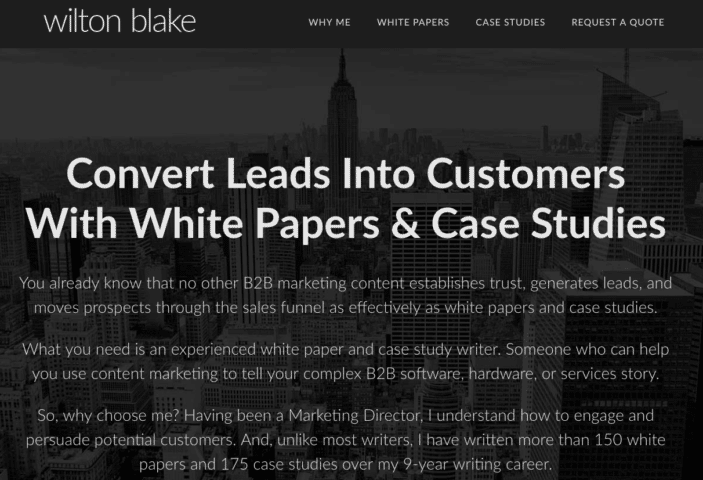
By improving the copy on your writer website and showing samples of your service, you can have a highly optimized writer website.
And, if you need help creating that type of writer website, make sure to check out Writer Website in a Weekend .
White Paper Resource
If you need a breakdown on the exact steps on how to write a white paper, make sure to check out the White Paper for Dummies book ! It’s from the expert white paper guy Gordon Graham.

Definitive Guide on How to Write a White Paper as a Freelance Writer
There you go!
A simple guide to writing your first white paper as a freelance writer. I hope this was helpful! I know my other blog post on how to create a cover letter helped a freelance writer gain a client!
For more writing help, check out these guides:
- How to Write a Letter of Introduction
- How to Write a Case Study
- How to Write a Resume for a Job
- How to Write a Cover Letter
- How to Write an Email as a Copywriter
Share in the comments if you write white papers or if you’re interested to add this to your services!
And please remember to pin me!

Share this post with your friends!
Leave a reply cancel reply, 43 comments.
What is a White Paper? Format, Types and Examples
Key insights from the best white paper examples across 9 industries, a blueprint to guide you.
- What is a White Paper?
- The Purpose of a White Paper
- Establishing Thought Leadership
- Driving high-quality traffic
- Collaborating with potential partners and product evangelists
- Identifying the Target Audience for White Papers
- Business Executives and Decision Makers
- Industry Professionals and Specialists
- Internal Teams
- Researchers and Academicians
- Government Experts and Policymakers
- Investors and Venture Capitalists
- What is the best format for a white paper?
- Executive Summary
- Introduction
- Research and Data Analysis
- Proposed Solutions and Implementation
- Common Mistakes to Avoid in White Papers
- Losing sight of the purpose
- Missing the fine line between fluffy and engaging
- Choosing an Uninteresting Title
- Failing to add structure
- What is the Ideal Length of a White Paper?
- Getting a Subject Matter Expert to Write Your Whitepaper
- Give Wings to Your White Paper with Research
- Are There Any White Paper Design Examples?
- How Do You Make Your White Papers Visually Rich?
- Exploring Types of White Papers
- Product Backgrounders or Evaluator’s Guides
- Numbered Lists
- Technical Papers
- Steps to Write a White Paper
- Plan the research
- Identify your Audience
- Choose a Topic
- Determine Objectives
- Demonstrate a Solution
- Add Character
- Include References and Footnotes
- Who uses whitepapers?
- Marketing Executives
- In The Web3 World
- CTOs, CFOs, CIO’s and more
- How do you distribute your whitepapers effectively?
- Landing Pages, Newsletters, and Blog Posts
- In-Person Interactions
- White Paper Syndication Services
- Private Communities
Lead Generation from White Papers: The Power of Gating
- Qualifies Leads
- Allows for Market Segmentation
- Demonstrates Value
- Limited Organic Traffic
- Pseudo-Qualified Leads
- Lack of Inbound Links
- How to Go About Gating
- Full Form Gating
- Partial Form Gating
- Gating on Social Media
- Gating through Surveys and Questionnaires
- How do you measure and track your whitepaper’s success?
Best Examples Of White Paper
Introduction: what is a white paper.
White papers are great examples of marketing collateral that exhibit your authority over a chosen niche.
Mostly, they are long-form content intended to educate the target audience, that delve deeper into industry trends, issues, and policies and explain its causes, implications, and benefits.
Companies, public institutions, governments , universities, and individuals publish white papers to address an industry problem to propose their solution to it.
That way, their product/solution has better recall value than its competitors.
According to the B2B Content Marketing 2018 Benchmarks, Budgets, and Trends report, white papers are one of the top 4 most effective types of marketing collateral preferred by 71% of companies.
Content marketers across industries use white papers as potential tools for sales . But, a lot of effort, time, resources, and money goes into creating it.
So, how do you ensure your white paper gives you more bang for your buck?
We have condensed our research of more than 70 white papers across industries and have drawn the below insights that will help you create the best white papers.
" White papers are long-form content intended to educate and inform the target audience. They delve deeper into issues, trends, and policies, and explain their causes, implications, and benefits. "
Learn the 8 steps to writing awesome white papers with free templates.
Creating a white paper needs a lot of work even before you begin working on the core structure.
Planning, stakeholder signoff, SEO strategy, value proposition, and ability to drive revenues are vital factors that you need to consider before putting pen to paper.
Let's look at how some of the most famous companies are doing it effectively. Jump to the best white paper examples in your industry:
- Financial Services
- Manufacturing
- Transportation
- Across Industries
- Non-Profits
To make it easier for you, we have outlined below the best practices that you can implement while creating white papers that will resonate with your target audience:
THE PURPOSE OF A WHITE PAPER
This ever-so-important marketing collateral that’s stood the test of time is used by companies, public institutions, governments, universities, think tanks, and consultancies (yup, the list is quite long).
But, each one uses them in their own special way.
So what purpose does a white paper really solve? Good question. Let’s dive into the specifics.
Establishing Thought Leadership:
Well-written white papers demonstrating unique knowledge help solidify trust and credibility in your brand .
White papers with in-depth research and analysis allow you to showcase your expertise, distinguish your brand and stand out as an authority in a topic or specific industry.
Remember, people are more likely to buy from a brand they trust and respect, so make sure you represent it well.
Driving high-quality traffic:
Learning followed by persuasion has proven highly effective in conversion. By building a top-notch lead pool that will likely provide contact information in exchange for white papers, you can simplify the process of creating a concrete, reliable mailing list.
White papers also serve as solid conversation starters, because you know what your lead is looking for.
Collaborating with potential partners and product evangelists:
The benefits don’t stop there. Think bigger and look beyond your organization.
White papers allow you to attract evangelists from different communities.
They will spark interest, cultivate support, and open doors for partnership opportunities that could act as acquisition channels for your brand.
IDENTIFYING THE TARGET AUDIENCE FOR WHITE PAPERS
Writing a white paper is like telling a knock-knock joke;
it won't work if no one's there to respond with "Who's there?" So, when you invest time in writing a white paper,
you must know who your readers will be. Ask yourself, "Who's going to read my white paper?"
Business Executives and Decision Makers:
Senior executives are often the decision-makers in their organizations and are responsible for strategic planning and investment decisions.
Well-researched white papers can influence their judgment.
Industry Professionals and Specialists:
This category includes professionals seeking industry-relevant knowledge to enhance their work.
White papers prove valuable for engineers, doctors, lawyers, researchers, and analysts, bridging the gap between theory and practice, and fostering professional growth.
Internal Teams:
Prospective employees can benefit from white papers as they share insight into a company’s vision, values, and line of thought.
At the same time, they help fill knowledge gaps within the firm for current employees.
Researchers and Academicians:
White papers are platforms for presenting research findings, academic studies, and technical analyses to a broader audience.
They also serve as supplementary materials for students studying relevant subjects and provide case studies for teaching purposes.
Government Experts and Policymakers:
These personas use white papers to propose policies, outline government ventures, and address critical issues.
Consequently, they become a medium to influence policy decisions and shape public initiatives.
Investors and Venture Capitalists:
Startups and companies seeking funding use white papers to present their business plans to potential investors and venture capitalists.
These white papers state the value proposition and present investment opportunities that are seeking financial support.
WHAT IS THE BEST FORMAT FOR A WHITE PAPER?
Even the best white papers vary in structure.
These pointers will give you a general idea of a paper’s multiple components.
However, remember to experiment and see what works best for you.
Before you start writing, create a content outline to serve as a blueprint to guide your progress as you develop and write your white paper.
Your outline could look like this:
Executive Summary:
Focus on developing an attention-grabbing executive summary to engage your readers effectively.
Your readers will encounter this section first and use it to decide if they want to continue reading.
A well-constructed summary should provide a mix of the following building blocks.
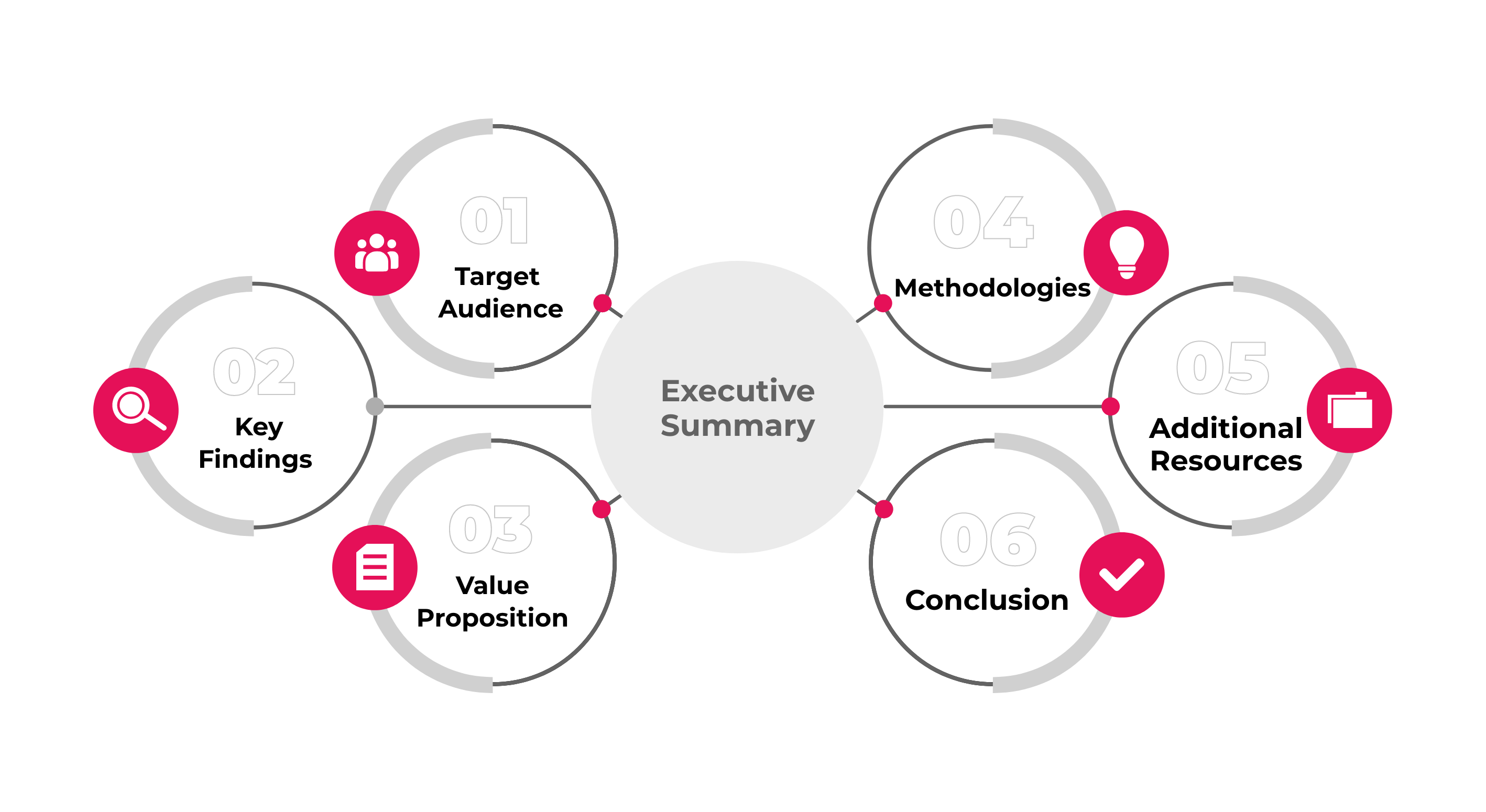
Introduction:
Including the problem statement in your introduction is a good idea, as it immediately arouses curiosity.
An appealing and educative introductory section will incentivize readers to continue. Think of it as an elevator pitch.
What should this section ideally include? The clearly defined purpose that the white paper is trying to accomplish.
Research and Data Analysis:
This section offers a comprehensive topic investigation, drawing from reputable sources and empirical data. It should mention the literature review conducted and the methodologies used.
The analysis interprets the collected data by providing insights and support for proposed claims.
Tables, charts, graphs, and diagrams will make this content visually appealing.
Proposed Solutions and Implementation:
This part builds on the previous section and recommends a solution for the problems identified.
The solution may be a product or course of action.
While presenting your value proposition is essential, avoid taking a hard-selling approach.
Instead, demonstrate to your readers how the proposed solution directly applies to their situation, highlighting its potential benefits, such as Return on Investment (ROI).
Conclusion:
The conclusion serves as the summary of the entire white paper. It’s what your readers will remember, and remember well.
Many will choose to focus on this chunk of the paper alone, so make sure it has notable influence.
Any conclusion should close out with a Call To Action button for your white paper to deliver value. This could be a free consultation or demo of your product.
Platforms like Cleverstory are pushing boundaries, turning these often static documents into highly engaging, interactive experiences.
With a plethora of templates at your fingertips, you don’t need to start from scratch and can go about building a dynamic white paper.
Common Mistakes to Avoid in White Papers:
With a deluge of white papers out there, it’s understandable to feel overwhelmed and label them “redundant” or “unnecessary”.
Here are some common but avoidable mistakes content marketers fail to pick up,
Losing sight of the purpose:
Addressing a specific business need is at the heart of this marketing collateral.
Writing a bland, one-size-fits-all piece is likely to fall short.
White papers that show you how you’re different in knowledge, opinion, and innovative thinking will help you stand out.
Missing the fine line between fluffy and engaging:
Readers want you to avoid beating around the bush and wasting their time.
While essential, efforts to capture and retain attention must stay within the paper.
Ask your audience what they’d want to consume. This will make your white paper highly relevant and pique your readers’ interest.
Choosing an Uninteresting Title:
If it’s not a catchy title, it won’t work.
Vague, generic, textbook-like ones won’t communicate value. Try to be specific, descriptive, and result-driven to arouse interest.
At the same time, over-the-top titles will push readers away. Consider taking a minute to brainstorm titles to ensure it grabs your readers' attention.
Failing to add structure:
Your readers will not resonate with a wall of information.
Clearly defined sections, subheadings, and topic sentences offer readers a coherent, smooth reading journey.
A well-defined layout, bullet points, adequate spacing, and well-timed breaks will make your content easier to consume.
WHAT IS THE IDEAL LENGTH OF A WHITE PAPER?
There is no such thing as 'ideal length' for a white paper.
However, every page must add incremental value to the reader. Keep the curious reader hooked on with new things that they weren't aware of in every sentence that you put out.
It is easy to get carried away by all that you want to write, but your readers may not be interested in knowing them.
If you are publishing a white paper titled "5 ways to prevent cardiovascular diseases," then readers will look for the text under the bullets that speak about these five different ways.
So, devote maximum effort in making this portion of the document valuable for them.
GETTING A SUBJECT MATTER EXPERT TO WRITE YOUR WHITEPAPER
Compare these two: a weather meteorologist predicts that there will be rain tonight. Your 80-year old grandma peering out of the living room window says it is not going to rain anytime soon.
Whose prediction are you more likely to heed? It is natural human psychology to take notice when an expert opines.
So, it is a good idea to partner with a leading academician or a client executive or an independent blogger to co-author a white paper.
It is valuable only because it comes straight from a bevy of experts. You can nominate an SME from your company to partner with an external influencer in the authoring process. This approach adds more heft to your white paper.
GIVE WINGS TO YOUR WHITE PAPER WITH RESEARCH
Think about it – aren’t you eager to know the prediction of poll results in your state even before they are declared? That is because predictions are a cumulation of people's opinions.
From our analysis, we found that some of the best white papers were the ones that had some form of research/survey results embedded in it. These results were an aggregation of public opinion who have given their verdict.
Today, with online surveys, you can compile results within a few hours of putting it up. People want to know what other people in their community are saying. It is bound to engage the target audience more than a one-page newsletter .
ARE THERE ANY WHITE PAPER DESIGN EXAMPLES?
One of the biggest stumbling blocks in the white paper creation process is the availability of templates or design examples.
Here is our post on How to Writ’e a White Paper [with free templates] that you can download and get started right away.
These white paper design examples and templates will help you not be overwhelmed with the monstrosity of the project. Feel free to tweak them based on your needs.
HOW DO YOU MAKE YOUR WHITE PAPERS VISUALLY RICH?
One reason why marketers don’t see a high ROI on their white papers despite the best efforts is that they fail to make it visually enriching.
Include infographics, images, charts, etc. to explain your points as well as giving a takeaway for your target audience. Remember, you could reuse all of these visuals in social media, etc. to boost white paper downloads.
Make Content That Is Bingeable And Not Boring
EXPLORING TYPES OF WHITE PAPERS
Hate to break it to you, but there isn’t just one kind of white paper.
Where’s the fun in that?
These broad variations have arisen from a multitude of use cases.
Product Backgrounders or Evaluator’s Guides:
This paper discusses a value proposition's specific features, benefits, and functions. It aims to establish your company as a market leader while explaining a new product offering.
Such a paper can be effective during a product launch, capturing the attention of potential customers.
Numbered Lists:
Numbered lists deliver crisp information through tips, questions, and key points.
It is flexible enough to be incorporated into other content forms like blogs and e-books.
Technical Papers:
Technical papers often present themselves as user manuals for product upgrades or malfunctions.
The language is often carefully crafted to suit the target audience and includes technical terms (hence, the name).
STEPS TO WRITE A WHITE PAPER
Unfortunately, white papers do not come with a superhero guide. As clique as this may be, each one is unique.
But, keeping in line with this blog being comprehensive, here is a brief plan.
Plan the research:
When writing a white paper, you’re asking for a time investment from your readers at the end of the day. Hence, creating value is the first step.
It’s wise to include market research (your own and external sources) wherever apt.
As mentioned, the goal here is to cater to all the personas within your target audience, not just potential customers.
Remember, this isn’t where you emphasize your technology or product.
Identify your Audience:
We’ve talked about a white paper’s audience multiple times already, and we’ll continue to do it.
That’s exactly how important it is to consider.
How do you intend to target your audience? How can you capture their interest? Which jargon can they comprehend? You need to ask yourself these questions to develop ideal reader profiles.
Acknowledging their objectives and interests will equip you to draw up your white paper accordingly.
You can also adjust your language and style to suit their needs.
Choose a Topic:
Pick a topic you are qualified to write on.
The concept you decide on should give you enough leeway to tap into an unexplored conversation and put your spin on it.
Keep in mind that you should focus on the benefits your reader can derive from your writing.
Determine Objectives:
If your intended audience includes multiple stakeholders, determine which need you want to cater to.
Your goals can be lead generation , brand recognition, or simply education.
Based on your objectives, you can set appropriate parameters to measure success.
Demonstrate a Solution:
Here, every marketer’s muscle memory comes into clutch.
But rather than focusing on your offering, take an expansive approach and include multiple solutions.
First and foremost, your white paper needs to be valuable and flexible.
Basically, aim to create your industry’s gold.
Add Character:
Use creatives and real-life examples to bring your white paper to life. ‘
Remember, you’re trying to have it resonate with your readers.
You want them to remember what you’ve written and come back with questions, comments, and suggestions.
But how can you make your white paper digestible and engaging?
Using Cleverstory, you can incorporate interactive charts, videos, and animations to breathe life into your white paper.
Include References and Footnotes:
If you use data from other sources, acknowledge them in footnotes and reference them to their origins.
You’ve got to give credit where it’s due.
Once you’ve developed your white Paper, release it into the industry to see how your audience receives it.
The results and observations that you generate will set the scene for what’s to come.
If it doesn’t perform well, take a step back to evaluate and improve.
WHO USES WHITEPAPERS?
At the top of our minds, marketing collaterals such as whitepapers, case studies , POV's , infographics, brochures and brand stories are used by the beloved sales team of every organization to send across to potential prospects .
These marketing collaterals serve the singular purpose of providing information to the readers about your company/product/service so that they decide to, well, pick you!
But, you already know all this. We are aware that this definition isn’t terribly helpful.
So, let's get a liiiitle specific.
MARKETING EXECUTIVES
In the universe of marketing, content never serves a singular purpose. There is always room to refresh, refurbish and of course, create magic.
Every marketer will agree that whitepapers aren’t any different. Content rich collaterals such as whitepapers can do wonders such as
Educate new employees on the specifics of a company
Serve as inspiration for other forms of content (social media posts, blogs, feature updates, etc)
Establish your company as a thought leader in your field.
IN THE WEB3 WORLD
Whitepapers are one of the primary sources of information in the Web3 world. Who would’ve thought, right? Whitepapers heavily determine a ton of important factors relating to the assets such as :
- The price of the coin
- The project value
- The use cases
- Dependencies
- Future roadmap
- Predictions
- Integrations
In Web3, potential investors and buyers consider whitepapers to be their make or break component before making a decision.
Since Web3, cryptocurrency and the whole cloud of new age internet built on a blockchain is still a fairly new concept to the world - people are looking to garner all the information they can.
Here’s a guide on how to read Web3 Whitepapers
CTOS, CFOS, CIO’S AND MORE.
No. Not UFOs.
Whitepapers are used by Chief Technical Officers, Chief Financial Officers, Chief Information Officers and so on for distinct purposes in their respective line of work.
This includes -
- To draw comparisons
- Discover new developments
- Analyze the current status of the market
- Analyze fluctuation in numbers amongst various companies
- Analyze the performance & long-term risks
HOW DO YOU DISTRIBUTE YOUR WHITEPAPERS EFFECTIVELY?
Effective distribution has become paramount with the increasing demand for educational content.
Unfortunately, your white paper isn’t going to be a magnet.
Even if you've tailored your paper to your target audience, you still need to consider how they’ll find it.
Landing Pages, Newsletters, and Blog Posts:
Embedding or linking your white paper on these SEO-friendly channels improves distribution and increases visibility.
You can also drive traffic through PPC ads, social media, and other promotions on these pages. Once these visitors land, you can qualify leads by gating the content they view or download.
We’ll talk more about gating in a separate section (it deserves to be the star).
But make sure these channels are accessible through all devices to expand reach.
In-Person Interactions:
Carrying your white paper can deliver tremendous value at meetings and events.
They allow you to solve customers’ pain points instantly, offer deeper explanations and provide “tangible takeaways”.
These interactions could be seminars, workshops, conference presentations, or networking events.
White Paper Syndication Services:
Syndication Services can distribute your content to multiple third-party platforms or websites, increasing visibility, brand recognition, and traffic.
These houses publish white papers after verification to ensure credibility.
They provide a window into a large, typically niche, paid reader base.
Private Communities:
A ton of B2B tea is split on Reddit, Slack, and Discord.
They provide valuable avenues for industry-related conversations and insights.
You can amplify the reach of your content by actively participating and sharing content that tackles community-specific issues.
Make Your Content Available Anywhere Anytime Any Device
While generating new leads through your white papers is great, consider sharing them with your existing lead database.
You’ll be able to generate fresh engagement and gain traction through potential backlinks.
Quick Note: Backlinks are hyperlinks that direct a visitor from one website to another.
We’ve talked about distributing your white papers effectively. But what after? You wouldn’t want to be left in the dark, would you?
With tools like Paperflite, your customer-facing teams can send out white papers via personalized content microsites.
That way, you’ll be able to gain insights into how recipients engage with your content , which parts resonate the most, and how often they return to it.
Get Actionable Insights That Moves Sales Forward
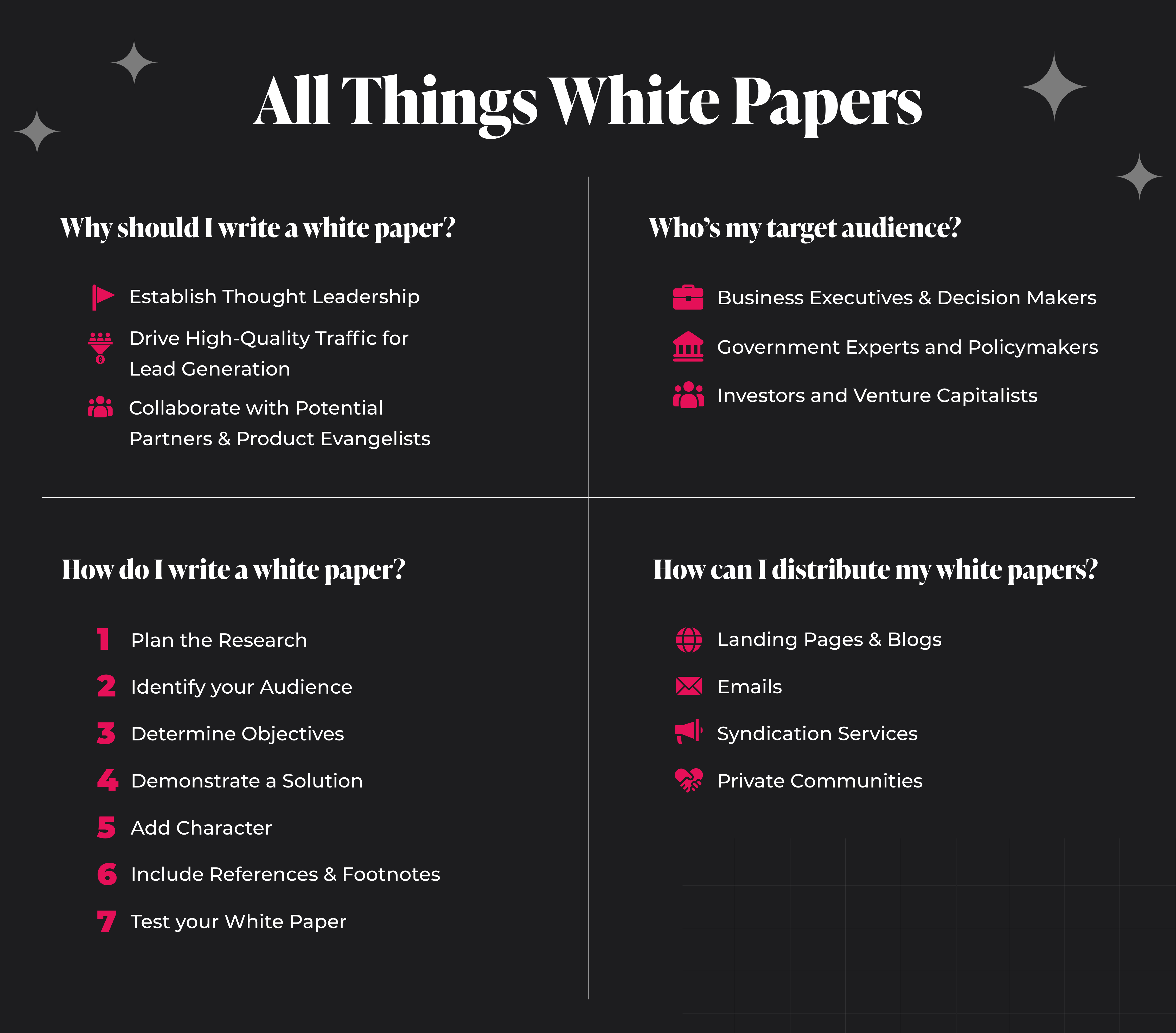
We’re now back to our favorite dating app analogy.
Imagine stepping into the world of a dating app and striking up conversations with potential matches. In this digital realm, you sift through profiles, assessing hobbies, personalities, and compatibility factors – all to decide if someone is worth pursuing.
In the world of marketing, this process is akin to "gating" . Just as you use filters to narrow down your dating prospects, gating helps businesses filter out worthwhile leads from a larger audience. It's a strategy that saves you valuable time and resources.
Sounds good, right? Well, gating can offer more for your lead-generation efforts.
Qualifies Leads:
If a lead chooses to share their personal details in exchange for content, it’s safe to say that they’re “interested” without much hesitation.
Allows for Market Segmentation:
Gating collects lead data, aiding in strategic segmentation and attentive nurturing, ultimately bolstering your lead to customer conversion.
This data spans company details, industry, and geography.
Demonstrates Value:
Gated content creates a sense of exclusivity, making readers perceive it as valuable and worth their time.
But remember, the quality of the asset should always be worth more than the disclosure of information.
In an ideal world, this sounds splendid.
But do you lose out on something?
Is this a classic “you can’t have the cake and eat it too” situation?
Well, don’t say we didn’t warn you. Here are some drawbacks to gating your content:
Limited Organic Traffic:
When you gate content, you’re effectively restricting the ranking of relevant keywords, as search engines cannot crawl into your content.
This limits its use in SEO campaigns and, in turn, lowers organic discovery.
Pseudo-Qualified Leads:
Some leads might supply false information to access gated content, leading to potentially skewed or inaccurate data collection.
Unwillingness to provide any data at all is also an obstacle at times.
Occasionally, a reluctance to share any data at all can also pose an obstacle.
Lack of Inbound Links:
Linking content to other pages and sharing disappears when gating emerges.
Devise an balanced mix of gated and ungated content to ensure success
Ungated content shines in the Awareness stage.
All web content is, by default, ungated. This allows for increased search visibility and brand recognition.
Also, consider which stage your business is in. Visitors may not be willing to provide information to start-ups or lesser-known firms.
You can pair gated content with the right promotional strategy as it finds its place within the Consideration section.
- What kind of content should we gate?
- How many pages?
- What details do we need?
Addressing these questions will make sure the material is accurate and relevant.
HOW TO GO ABOUT GATING
If you’ve chosen to gate content using forms, you have two techniques at your disposal.
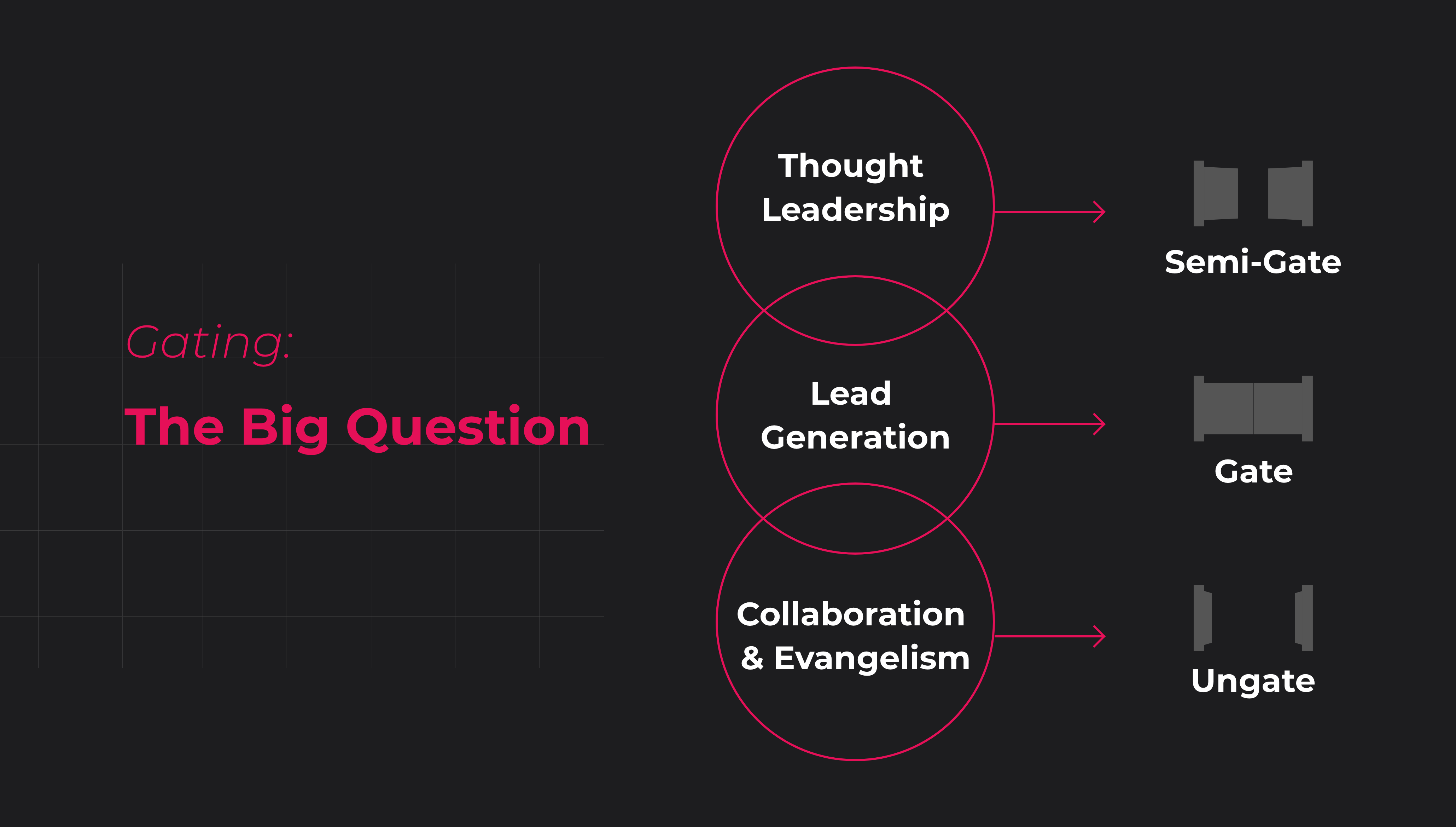
Full Form Gating:
With full form gating, the user needs to provide detailed information (name, email ID, phone number, company, industry, and geography) by filling out the entire form to access gated content like white papers, e-books, etc.
This technique yields valuable information for lead nurturing and segmentation purposes because of how comprehensive and vast the questions are.
But on the flip side, it suffers from high abandonment and low conversion rates due to greater friction.
Partial Form Gating:
Partial form gating involves extracting limited details (name or email address), resulting in a lighter user commitment.
This method offers a positive experience while providing quality lead information.
Users are more likely to complete a form with a few basic questions only. Progressive profiling takes place as the reader delves deeper into the content.
But, beyond gating white papers on websites, here are some alternatives.
Gating on Social Media:
The lead logs into or authenticates their account through this method.
After which, a redirect to the social media platform takes place, and the user grants permission to extract personal profile information from LinkedIn, Facebook, etc.
You can eliminate manual form filling and ensure up-to-date information.
Gating through Surveys and Questionnaires:
This type of gating boasts a dynamic design allowing for personalized, highly efficient data collection.
Subsequent questions are based on answers given in the previous ones leading to higher engagement. Skip logic is also present, smoothening the journey.
A brief overview of the structure:
- Initial questions: This section includes demographic or other inquiries to determine if the survey is relevant.
- Branching: Post the initial questions, the survey branches out into specific topics and follow-up questions.
With Cleverstory you can capture quality leads, through high-intent gating and going beyond the
HOW DO YOU MEASURE AND TRACK YOUR WHITEPAPER’S SUCCESS?
If you have included your whitepaper in your landing page, or published it anywhere in your website - Google Analytics is your guy.
With Google Analytics, you can see from which region your incoming website traffic is being generated. Google Analytics also enables you to track collective data on users such as how long viewers have spent on your asset.
Platforms such as Paperflite enable you to track uber-specific metrics through smart gating such as -
- The name of the user
- How much time a specific user has spent on your asset
- What other assets have they viewed
- Number of times the viewer has shared the asset
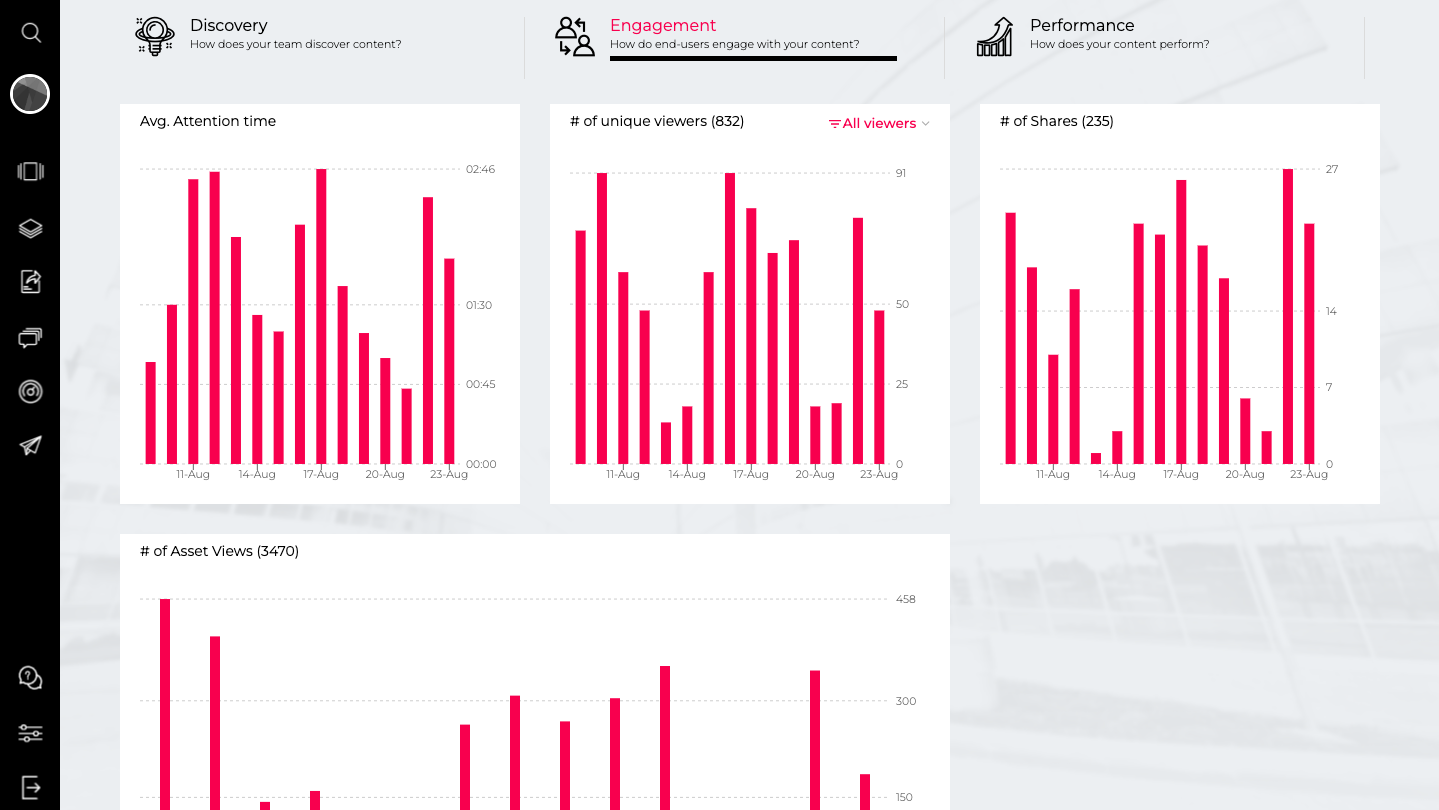
Let us now dive into the best white papers across industries that we analyzed
The Best White Paper Examples for Financial Services Companies
1. 5 steps to rid your small business of payroll stress
Published by: ADP
Why do we like this?
ADP is an established authority in the payroll software industry, and they know what works in their industry. This white paper uses a lot of visual appeals to explain how small businesses can overcome payroll-related challenges.
Moreover, this white paper's target audience (SMEs) does not have much time, so ADP has stuck to the basics. The company has given out vital information that the audience is seeking instead of flooding the white paper with text. While giving out the five steps, they've even given a case study of how they helped one of their clients, which makes their opinion invaluable.
2. Seizing the Digitalization Opportunity
Published by: Siemens
For starters, this white paper is an 'insight paper,' which is a smart move by Siemens . The authors have laid out the key findings upfront, which is the core of the white paper. They have substantiated the concept of TCO (Total Cost of Ownership) financing with examples of how they have helped clients in the real world. It doesn't have a lot of white spaces but is full of core and reference text.
3. RegTech: Helping Your Data Work Smarter and Harder
Published by: Wolters Kluwer
This white paper tackles a complex topic, one that does not have a lot of literature out in the open - Regulatory Technology (RegTech). The company introduces a solution, explain its basics, the necessity for it, how it helps companies in various geographies, and the benefits of implementing it.
Wolters Kluwer explains what their opinion is on RegTech in a manner that an IT professional would comprehend it.
4. Are equities overvalued?
Published by: HSBC
Why do we like it?
This finance white paper has loads of content in it to explain the reasons for the overvaluation of the equity market and why asset allocation could be the answer to it. It has content under five clear headings and is bound to interest portfolio managers, fund managers, and investment professionals.
Authored by the bank's global executives, it is a significant report that has a clear message - investors need to be cautious in their equity allocation approach.
5. How Banks Can Win New Small Business Customers
Published by: VansonBourne
We like this white paper for two reasons:
1) It is an output of the collaboration between Avoka and Vanson Bourne . Avoka creates customer acquisition and onboarding journeys in financial services, while Vanson Bourne is an independent specialist in market research for the technology sector. An excellent example of how a collaborative effort counts a lot more than individual efforts.
2) It compiles verbatim responses to a survey administered to 300 small business owners in European countries. It is rare to see white papers where two vendors catering to similar target audiences join hands to create marketing collateral that serves them both.
The Best White Paper Examples for the Healthcare Industry
1. Journey To Value: The State of Value-Based Reimbursement in 2016
Published by: McKesson
This white paper is well-structured for the healthcare industry, with an academic orientation. It begins with the list of charts and figures used and the definitions of healthcare terminologies. McKesson had already forayed to answer the question " Is value-based reimbursement real? ” two years ago in a similar white paper.
This time in a sequel to the earlier document, they teamed up with a niche research company to survey 465 payers and hospitals to see how far the needle had moved on value-based reimbursement.
By expanding and repeating the earlier study, they have established themselves as an authority on the subject. The white paper moves along from one stage to the next by explaining the survey methodology, the sample design, and the findings.
2. Reinventing Utilization Management to Bring Value to the Point of Care
Mckesson 's Vice President has authored this white paper on the topic of Utilization Management , which is a good strategy as it exhibits how much they value their content.
After a brief introduction, it moves to the limits of traditional utilization management models and how shifting to a collaborative exception-based model combined with analytics will serve as a bridge to the future.
3. Current and New Approaches to Making Drugs More Affordable
Published by: CVS Health
Dealing with industry issues and suggesting remedial measures for a company like CVS Health is an excellent way to build topic authority.
Bringing drug costs under control is an industry-wide problem for US healthcare companies. CVS Caremark has taken the lead to explain how if manufacturers across the board were to reduce drug prices, it would improve health outcomes and reduce medical costs.
Besides suggesting three techniques to reduce costs, the company has suggested three recent innovations that help further reduce costs. The company has explained how medications can be made further affordable by comparing the high-profit percentages of pharmaceutical companies as compared to other industries.
4. The Only Way is Up
Published by: Bayer
In terms of the choice of subject, this is one of the most attractive white papers published by Bayer . The company explains where short cucumbers originate from, how cucumbers are a core component within Middle Eastern cultures and the critical consumption drivers for the vegetable in Europe and North America.
The white paper is a storehouse of insights that includes average household sizes, life priorities of the customers, the evolution of the consumer, etc. For a company of the profile of Bayer, to be opining about short cucumbers and how they have entered the snacking market is unique.
5. The Forgotten Killer: Cardiovascular disease
Published by: Aetna
This white paper serves as a primer for cardiovascular diseases (CVD) and explains its most common conditions. It describes how countries such as Finland are adopting measures to fight it, the promise and limitations of new drug therapies, and technology advancement that could improve diagnosis.
This white paper is an eye-opener for those who are not aware of CVDs and gives out a lot of information on ways to avoid it. With impressive noting of footnotes and charts, this is an excellent piece for people looking to fight CVDs.
The Best White Paper Examples for the Insurance Industry
1. Digital Transformation in the Insurance Industry
Published by: Frost & Sullivan
Commissioned by Samsung Electronics America , this white paper deals with the trends that are shaping the Insurance industry. It deals with how insurance companies can thrive in this changing industry landscape, and how technologies such as mobile, wearables, AR/VR are impacting the industry.
It is a perfect example of how a company specializing in a niche has partnered not just to explain industry trends, but also to explain how they're at the forefront of it.
2. Black Insurance's White Paper
Published by: Black Insurance
Black Insurance 's white paper on the challenges faced by the industry (i.e., multiple parties, high costs, and barriers to entry) shows their deep understanding of the subject.
It explains Black Insurance 's proposed solution to this situation along with with the business model, the pricing framework, licensing, token economics, technical design, etc. It is a comprehensive white paper that positions them as an authority in this domain.
3. Nine ways insurance carriers are driving down combined ratios with video
Published by: Panopto
Panopto is a video platform that enables users to record videos. The company has created a white paper for an industry that uses video extensively.
It is almost a no-brainer that the company has put out a white paper to further their business initiative and showcase its authority in the subject.
4. The Insurance Industry: Supporting SMEs To Prosper
Published by: Allianz
This white paper is similar to other step-by-step pieces that lay down the number of steps that an organization must take to achieve a specific goal.
Each page highlights a challenge that small and medium enterprises face along with the remedial actions that they could bring, which makes it easier for readers to know how to deal with them.
Moreover, this is a survey of 500 SME businesses to identify the top 5 challenges facing the SME industry.
5. Embracing the multi-generation workplace
Published by: AXA
AXA ’s white paper has impressive statistics by experts about an aging UK population followed by a bulleted-executive summary (pretty unconventional, but seems to work!).
It then moves methodically into the challenge that aging employees and the organizations alike face, covers the benefits of having a diverse workforce, recommendations for companies. It is not too long; neither is it abridged and is perfect for a good read for human resource professionals who are dealing with an aging workforce.
6. Enterprise Counterparties: Mortgage Insurers
Published by: Fannie Mae and Freddie Mac
This white paper is by the US government charters to provide liquidity, stability, and affordability to the mortgage market. So, it is a highly valued piece because it has the US government’s stamp on it. Moreover, it is a bible for many mortgage insurers, academics, policymakers, regulators, etc. who want to get to the point straight.
This document is in a free-flowing format without any pictures, but it has substantial intrinsic value. We included this piece to show how government agencies prefer putting out their publications.
7. Accident Insurance
Published by: Prudential
Prudential ’s white paper on accident insurance for the US market is extremely well structured and explains the various aspects of accident insurance. This white paper is insightful with numbers and graphs, explaining the reasons why people need accident insurance, what employers need to do, etc.
With 13 pages of useful content, companies looking to provide accident insurance benefits to its employees can use this document as a handy guide.
The Best White Paper Examples for the Manufacturing Industry
1. How ETERNUS DX contributes to energy efficiency, cost savings, and a human-centric intelligent society
Published by: Fujitsu
Fujitsu describes how their disk storage systems provide energy efficiency in the face of rising energy costs in data centers. It is a technical paper replete with diagrams and process flows. Clearly, Fujitsu has explained technical concepts intending to sell their solution that increases disk storage, saves energy, and improves energy efficiency.
Fujitsu also describes their green IT initiatives and what they're doing to reduce burdens on the environment. With ' caring for the environment ' a core topic of this white paper, their Green IT initiatives resonate well with the document.
2. Win more business with fewer sales resources
Published by: Infor
An example of a white paper that has been created solely to market the company's solutions. It explains the need for change in discrete product sales and other technical concepts very well backed by secondary research. A no-frills document that sticks to the point and conveys its central message within five pages.
It offers suggestions on how manufacturers manage sales and how they have a choice to take advantage of the situation with fewer resources.
3. How Software solutions can help mining companies increase efficiency levels
Published by: Sage Business Solutions
This white paper is well-structured and moves in a step-by-step manner. It explains the challenges of improving mining efficiencies in Australia, available software solutions, and mobile dashboards that can enhance productivity .
It follows the inverted pyramid structure of laying down the most significant challenges and narrowing down on the ideal solution.
The Best White Paper Examples for the Retail Industry
1. Dialogue Marketing: How to Enter and Succeed in the German Market
Published by: Deutsche Post
This exciting piece speaks about ways to enter the German market using dialogue marketing, i.e., all marketing & advertising activities aimed at starting a direct dialogue with customers.
It explains what non-German retailers need to do to enter a new market (if they haven't) already done it. Deutsche Post 's white paper makes them an authority on the subject of marketing in Germany. Besides, being a major German logistics player, this white paper makes a lot of sense for them to publish .
Why? Because if e-commerce companies were to enter Germany, shipments would go up, which will ultimately benefit them.
2. Eligma - AI-driven and blockchain-based cognitive commerce platform
Published by: Eligma
Although this white paper aims to harness AI and Blockchain to improve the decision making for eCommerce customers, it is applicable for all industries.
This white paper is an example of a yet-to-be-launched product. It explores market opportunities, business model, execution plan, technology solution framework that leverages AI and Blockchain, and loyalty programs. One core vision combines all these elements: to offer a set of solutions to discover, purchase, track, and resell eCommerce items.
Seldom do we find such white papers that have the depth and coverage for a solution that isn't launched in the market yet.
The Best White Paper Examples in Technology
1. Design and deliver cloud-based apps and data for flexible, on-demand IT
Published by: Citrix Systems
In this no-frills white paper, Citrix Systems deals with the topic in hand straightaway: A better way to deliver cloud-based workspaces using Citrix Cloud IT.
From a visual perspective, there aren't many pictures in this document, but it makes up for it with use cases that further give evidence of their proposed solution.
2. Hitachi Content Platform
Published by: Hitachi Vantara
This technical white paper is bereft of any visual appeal barring system architecture diagrams. It delves deeper into how Hitachi 's solution can help minimize vulnerability and threat exposure.
A company-specific white paper which focuses on the problem at hand and how their solution can help overcome it.
3. Creating the Foundation for Digital Transformation
Published by: Hewlett Packard Enterprise and Red Hat
This unique white paper is written jointly by HP and Red Hat . It explains how they bring together their consulting and migration expertise to help clients achieve digital transformation.
They've even highlighted the success story of how one of their clients, DreamWorks Animation , was able to accomplish digital transformation. This white paper is an excellent example of how they're bringing their proposition to life.
4. Using Virtual Platforms for Pre-Silicon Software Development
Published by: Synopsys
This white paper is similar to the Hitachi Content Platform piece that we mentioned above but does not propagate their solution.
Instead, they explain how it has become increasingly challenging to sell silicon without the associated software executing on the hardware. It is prevalent in a variety of application domains like wireless, multimedia, networking, and automotive.
It is a common problem that many semiconductor companies are facing and explains how a virtual platform can be used to develop and integrate the software. The target audience for this white paper is semiconductor engineers and IT architects, who know the nuances of semiconductor development.
5. Air, Fluid Flow, and Thermal Simulation of Data Centers
Published by: Autodesk
A technical document explained with diagrams on the usage of computational fluid dynamics cloud-based services within the Autodesk 360 platform. It was published in 2013 and is still very relevant due to how they command authority in their chosen niche.
6. 2018 Fjord Trends
Published by: Fjord (An Accenture Organization)
Fjord 's white paper on global trends is a treat for those who track technology developments closely. Each industry trend has a section on what's happening around the technology, what lies ahead and Fjord 's recommendations for enterprises looking to adopt the technology.
Each trend has examples of how companies are leveraging it to prove its significance to the industry. The report stands out for its clarity, simplicity, and depth of coverage of each trend.
7. Our Approach to Automated Driving System Safety
Published by: Apple
Apple ’s white paper on their approach to automated vehicles explains how their systems work. True to its native style, the white paper contains plain and simple text and does not use pictures to amplify its message.
It reveals fascinating insights on driver safety and pays close attention to every detail. It mandates that drivers must have both hands on the steering wheel, work in a single shift, and take frequent breaks while driving.
The Best White Paper Examples for the Transportation Industry
1. Fast-Forwarding to a Future of On-Demand Urban Air Transportation
Published by: Uber
This document is a quick example of how a transport company predicts a bold new future. While Uber has sponsored the white paper, note how it mentions reviewers from NASA , MIT and other elite organizations that provide air transport.
They've coined the term VTOL - short for ' Vertical Take-off and Landing .' Imagine a service that does not exist today, and you have the opportunity to bring it to life. This white paper introduces the concept of VTOL in urban cities; it talks about all aspects of this - barriers to achieve them, emissions, certifications, safety, performance, and rider experience.
They conclude by saying what steps they will take to bring this to life. A 98-page document, it sure is bound to appeal to the die-hard fans of futuristic transportation.
2. Rethinking Transportation 2020-2030
Published by: RethinkX
This white paper is bold in many ways, because its author, Stanford economist, Tony Seba is a man known for his daring, but accurate predictions. He predicted the rise of the solar industry when solar panels were a lot more expensive than they are today.
In this white paper, Tony predicts the death of the automobile and the oil industry. He goes deeper into every aspect of these predictions and gives the reasons for his predictions.
The predictions, statistics, in-depth research, and recommendations of this white paper make it a unique content asset. The author has explained every concept in detail in the appendix section - an ideal example of a comprehensive white paper.
The Best White Paper Examples Across Industries
1. A Four-Step Plan For Business Continuity - How to Develop and Maintain a BC Plan to Mitigate the Risk of Business Disruption
Published by: Sungard Availability Services
This white paper tells us the four steps needed to plan for Business Continuity (BC). BC applies to all companies and all industries, so the company has a unique advantage in that it can appeal to any company in any industry. It does not lean towards any particular industry; instead, it is a generic document.
2. The Power of Design Thinking
Published by: Dassault Systemes
One of those white papers where the format used is in the first person, and the author is an academic. It is another unique way of creating a white paper by getting academia or an expert from a different organization to write for you.
It contains valuable advice, mainly because it comes straight from Philip Gray, an expert who has spent four decades in product design.
3. Data Resilience with Fallback Protection
Published by: Teradata
Teradata 's technical white paper explains the need for a high-level discussion of the features of Fallback, a unique element to Teradata Database . It enhances the availability of a single Integrated Data Warehouse system.
The target audience for this white paper is data experts who will comprehend fallback recovery tools, performance impact due to Fallback, the benefits of having the Fallback.
4. Interactive content across the buyer's journey
Published by: i-on interactive, Inc.
A common topic across industries, this white paper explains why interactive content is better than static content and the different interactive content tools. The authors have cleverly used the buyer's journey to describe their case why businesses must use interactive content.
5. 10 Best Practices for Writing Effective White Paper Titles
Published by: inSegment
An often neglected feature, this white paper features the top 10 best practices for creating the best headlines. It is a short document and does not have a lot of content, but makes up for it via examples and useful suggestions.
6. MONITORING 101
Published by: Solar Winds
A generic white paper applicable to companies across industries, it introduces the concept of 'monitoring' for someone who is familiar with computers and IT in general, but not with monitoring. As such, (almost) no prior knowledge or experience is required to read this white paper.
It talks about the FCAPS model of surveillance, building blocks of monitoring framework, techniques of monitoring, and more. A seemingly technical concept has been explained well so that readers can understand it easily.
7. AWS Security Incident Response Guide
Published by: Amazon
Amazon 's biggest priority is security, and its collection of white papers on security is unarguably the most comprehensive that we have researched. Published during June 2019, Amazon 's white paper enables the reader to understand better the impact of incident response (IR), and user security choices on corporate goals.
A well-structured white paper, it encourages Amazon's customers to start small, develop runbooks, leverage necessary security capabilities, and create an initial library of incident response mechanisms to iterate from and improve gradually.
The Best White Paper Examples for Nonprofits
We like white papers by nonprofits because their topics are the most varied. They range from human rights issues to researching on butterflies, and so each white paper is a specimen in itself. Every nonprofit has a unique way of authoring white papers to suit their requirements.
1. Human Rights and Australia’s Foreign Policy
Published by: Amnesty International Australia
The first in our collection of white paper examples for nonprofits is the Amnesty International Australia ’s document. It talks about Australia’s role in promoting and defending human rights globally. It outlines ita recommendations at the beginning of the document and then dives deeper into the subject of global human rights issues and Australia’s interests.
Every problem area in the white paper has an immediate recommendation attached to it, so readers know what is the remedy for it. Despite lacking visuals and images, it makes for compulsive reading into Australian principles of multilateralism and human rights.
2. Extending US Biodiversity Collections to Promote and Collections
Published by: National Science Foundation
This white paper has brilliant Instagram-worthy images all through it with a caption that describes the effort behind digitizing biodiversity specimens in the United States.
A short 12-page white paper, it leads the reader through the collection of physical biodiversity specimens (plants and animals) and digital data gathering around them. It concludes with the steps needed for implementing and sustaining biodiversity collection efforts for the 21st century.
3. Under the Radar: Degradation in Canada’s Boreal Forest and Climate Consequences
Published by: Natural Resources and Defense Council
This manuscript may not be a white paper in its real sense. However, it weaves a story as a white paper would through do vibrant imagery. Every page is replete with stunning images that explain how Canada’s forestland is gradually receding.
Originally presented during the 21st Century Conference in Oxford, each page has insights about the shrinking carbon-absorbing capacity of Canada’s forests. It concludes with recommendations on steps needed to introduce afforestation. 4. The United Nations Children Fund – Women or Children First?
Published by: International Organizations Group
This detailed white paper is 102-pages long and divided into six sections. It traces UNICEF ’s history in combating epidemics, diseases, assisting women in childbirth, their health, and nutrition. It decries the reign of Carol Bellamy as the UNICEF executive director and the emergence of a feminist revolution that nurtures the girl child and cares for them. It recommends greater transparency in the operations of UNICEF and a more careful approach to spending their resources.
5. White Paper on Cancer Carers
Published by: European Cancer Patients Coalition (ECPC) and Eurocarers.
Carers are unpaid folks who provide care for patients with chronic illnesses such as cancer, who account for 80% cancer care in Europe. ECPC ’s white paper in collaboration with Eli Lilly , Merck , and Pfizer on cancer carers methodically explains the need for specific attention towards their needs, and the importance of an improved framework for carers generally.
It is an excellent example of a white paper created by the private sector and nonprofits towards providing sustainable care for chronic illnesses. It includes case studies of how European countries have been implementing different measures successfully and recommends employment, social, healthcare, and educational policy changes across Europe.
6. A 5˚C Arctic in a 2˚C World - Challenges and recommendations for immediate action
Published by: Columbia Climate Center, WWF, Woods Hole Research Center
This white paper summarizes the key outcomes of a workshop held in June 2016 to discuss the 1.5-2˚C change in global warming highlighted during the United Nations Framework Convention on Climate Change at Paris in 2015. A 1.5-2˚C change in global warming means a 3.5-5˚C change for the Arctic region, which can be disastrous. This white promptly highlights the immediate and long-term measures such as carbon dioxide removal and exploring the usage of alternate energy on a global scale.
It meticulously lays the background, the urgency of the situation, the need for immediate action, and recommendations.
7. Satoshi Nakamoto's Bitcoin White Paperflite Published by: Satoshi Nakamoto Why do we like this? No collection of white papers is complete without mentioning Satoshi Nakamoto's seminal piece on Bitcoin. This white paper, published in the wake of the 2008 financial crisis, is text-based and is a good starting point for anyone looking to learn more blockchain and cryptocurrency.
It describes the mechanics of a simple peer-to-peer electronic cash system, later known as Bitcoin. It succinctly explains how the Bitcoin might function without relying on a country's government or central bank. There is hardly any information about Satoshi Nakamoto in the public domain, but this white paper ushered in the era of blockchain technology.
Should a white paper include counter arguments or opposing viewpoints?
Sure! Including counterarguments adds depth to your white paper by addressing potential objections. It’ll showcase an exhaustive and balanced view of the topic.
Can white papers be repurposed into other content forms?
Yes, you can repurpose your content from white papers into blogs, infographics, videos, and more. This allows your insights to cater to different audience preferences.
How often should a company produce white papers?
It’s always going to be Quality over Quantity. Choose to produce white papers when you have valuable insights to share. There is no strict schedule you need to adhere to.
What is a typical timeline for creating a white paper?
The timeline will vary based on your topic’s complexity, research, and writing process. However, on average, the process might take a few weeks to a couple of months to complete.
What are Your Favorite White Paper Examples?
Do you have any favorite white paper examples that you'd like to feature here? Is there any white paper that has awed you? Let us know your choices at [email protected] , and we will make sure it is part of this list.
- Marketing Collateral
- White Paper
- B2B Marketing
PAPERFLITE'S CONTENT TECHNOLOGY IN ACTION
It's easier than falling off a log.
(DON'T ASK US HOW WE KNOW THAT)

Thanks for joining Paperflite! One of our customer success representatives will be in touch with you shortly.
Please watch your mailbox for an email with next steps.
- Design for Business
- Most Recent
- Presentations
- Infographics
- Data Visualizations
- Forms and Surveys
- Video & Animation
- Case Studies
- Digital Marketing
- Design Inspiration
- Visual Thinking
- Product Updates
- Visme Webinars
- Artificial Intelligence
25 White Paper Examples & Templates to Use Right Away [2024]
![how to write a great white paper 25 White Paper Examples & Templates to Use Right Away [2024]](https://visme.co/blog/wp-content/uploads/2021/03/header-38.png)
Written by: Brian Nuckols

White papers are a great way to educate readers and prospective customers on topics related to your business.
Yet, as resourceful as white papers are, some people find creating one intimidating. Where do you start and what’s the best right format to present your research in an engaging and professional way? Start with white paper templates!
We’ve compiled a list of 25 of the best white paper examples and templates you can use for your next research topic. Each is designed for various industries, topics and niches, so you’re sure to find one you’ll want to use.
Here's a short selection of 8 easy-to-edit white paper templates you can edit, share and download with Visme.

The best part? You can easily edit these templates online or via Visme’s mobile app to give you the flexibility to work on your whitepaper anywhere. Pick the template you like from our list below and start designing your white paper . If you're new to creating ebooks, this ultimate guide contains a step-by-step tutorial on how to write a white paper .
1 Social Media Risk White Paper Example
If you’re looking for white paper ideas that focus on presenting a solution to your customer’s daily problems, this social media risk whitepaper provides a great starting point. It helps to effectively outline social media's negative effects or risks while providing proactive tips and practices to resolve or avoid them. This white paper is an example of the various risks we take when using social media.

You can use it as a template to create an attractive white paper that outlines a specific problem or challenge your brand helps customers overcome. Take it a step further and add or remove design elements that suit your taste.
For example, you can start by adding some high-quality icons , customizing the fonts or adding pictures from our library of free stock photos .
After finishing your creative process, download the white paper as an HTML5, JPG, GIF or PDF file or shared via a link. If you’re ready to upgrade your long-form content, take action by downloading this professional social media risks template.
2 Design White Paper Example
If your white paper needs to have a strong visual influence to complement your research or guide, this elegant white paper template provides just the layout.
Inside, this white paper template provides a balance of visuals and text so you can easily display your use cases, industry trends, topics your brand is a subject matter expert on and major takeaways to educate your audience.

Remember that each template is customizable so that you can change the colors, images and fonts in this template to your brand or company’s instead.
Visme provides two options for you to easily access your branding elements. You can manually create a brand kit in Visme, so you or anyone on your team can access it. Helping to maintain brand integrity.
Or you can use Visme’s AI-powered Brand Wizard . Simply share your website’s URL, and Visme’s AI system will automatically add your company logo, colors, and fonts to your whitepaper and even share templates that best match your brand.
3 Travel Guide White Paper Example
Our next sample white paper template is the travel guide white paper. This template is an excellent choice for any brand that needs to create white paper topics about travel. For example, you can create white papers on destination research, historical sites, travel trends or a quick guide to popular places.

If you’re unable to find the perfect image for your travel white paper’s topic, don’t worry. You can access Visme’s library of royalty-free stock images and videos, each professionally taken, in high resolution and licensed for commercial and non-commercial use.
4 Environmental White Paper Example
Our next white paper example is the environmental white paper. This template is an attractive design created to showcase environmental issues.
This white paper is not only visually stunning but it also provides layouts and sections to help navigate the reader through your issue while keeping them engaged.

As important as your research is, don’t forget to make it engaging to the reader.
To keep your readers from skipping through your pages, make your white paper interactive. Visme offers easy-to-use interactivity and animation features that will take your content to the next level.
Including hotspots, a clickable menu, hover effects or clickable pop-ups. Each can be used to hold immersive information without crowding your white paper with additional text or reports.
5 Water Pollution White Paper Example
The fifth white paper example on our list is this water pollution white paper template.
This template addresses the dangers of arsenic contamination. No matter what industry you’re in, if you’re looking to highlight the risk or side effects that a product, chemical or event has on the environment, this white paper example is an excellent choice.

If you’re ready to create an attractive white paper highlighting how your brand creates value by providing data-driven reports as a thought leader in its industry, you can use this template to make quick progress. The highly intuitive design helps make your white paper goals a reality.
If you’d prefer to swap out a few of the visuals with charts to showcase your data by leaning into the power of data storytelling in your white paper, Visme makes it easy to create and add data visualization with 30+ intuitive data widgets, graphs, heat maps and more.
You can also integrate data from apps like Google Excel directly into your Visme dashboard as you edit your white paper so you can edit or update your chart’s data in real-time.
6 Investor Outreach White Paper Example
This investor outreach white paper template design can help make your potential investors enthusiastic about your startup or new business opportunity. Alternatively, you can personalize this template to pitch services or ideas to an interested party.

When you’re finished editing this investor white paper, you can publish or share it in a range of ways that will impress your prospects or investors. For example, you can share using these white paper formats:
- Publish it as a website and share it as a private link that only selects people who can view it or may need a password to access it.
- Embed it on your website or landing page so any potential prospect scrolling through your site can read it.
- Download it in multiple formats, such as PDF, HTML file, PNG, or JPG as well as make it printable for publishing.
7 Innovation White Paper Example
If you’re a tech or start-up brand looking for a business white paper example to bring disruptive or innovative solutions to life this template will do the trick. It offers a sleek and modern design that makes it versatile for various technical white paper examples.

While you’re designing this template, don’t forget that you can invite team members to Visme to work simultaneously on this white paper project. With Visme, you never have to do work alone.
Visme offers team collaboration features such as being able to add comments (private or public), allowing team members to work on each section of your white paper with real-time updates and user permission controls, so only those on a need-to-know basis have access to it.
“Visme helped us in a big way. The hours saved each month from meeting time, working back and forth between the two groups is an irreplaceable wow factor for my team.” -Kimberly Barrett, Wellbeing Consultant at Ameritas.
Click here to learn more about how Ameritas used Visme to increase team productivity and bridge the gap between departments.
8 Electronic Media White Paper Example
For individuals that would like to add white papers to their repertoire, social media content, or portfolio, this electronic media white paper template can be used to help you establish or reaffirm yourself as a thought leader in your industry.

Once you’ve finished your white paper, you’ll need to decide how you’ll share it with the world. If it’s free to view, you can do this via a shareable link where you can post it on social media or embed it on your website.
If you’d prefer to make it gated content, meaning it can only be accessed by providing information like an email address, you can use Visme forms to help collect emails and then share your white paper.
9 Nature White Paper Example
Whether you’re a business with distinct marketing goals or a nonprofit looking to impact advocacy efforts, this white paper template will help you deliver your message in the best way.

When you’re using a Visme white paper template, it’s easy to customize until you get a final product that you’re happy with. You can swap in your images or choose from the endless free stock photo options available in the Visme image library.
If you’re not sure what kind of color themes or designs to choose from, you can always take advantage of the pre-designed color palettes available in the editor.
Once you’re done, you can download your white paper in your preferred format, such as PDF or HTML5, share it with a link or embed it on your website.
10 Travel Issues White Paper Example
So much has changed with the way people have traveled since the pandemic and the years to follow. You can use this travel issues white paper to keep on hand to keep your audience informed on new changes, ways of travel and place to go.
The template design is focused on visuals with a bright accent color to highlight any important features, fonts or items. Its crisp and clean layout helps to guide the reader through your page with ease as well.

Additionally, you can swap out the icons or shapes with elements that reflect your design style. You can also create layers of interactivity in your white paper with tropical or travel videos, animated text or social media icons. When you have something you’re satisfied with, you can save the white paper as a download or share it online with a link or an embed code.
11 Organic Food White Paper Example
As a food-centric brand that would like to educate your audience or provide educational information to your audience while presenting your product or brand as a solution, you can use this organic food white paper to do just that and more.
The design is focused on showcasing eye-catching visuals of food, green color blocks and accented icons beside your white paper text. You can use it as is or go in the Visme editor and use your brand colors and copy easily.

We know that visuals are a key element to making your white paper memorable. So if you’re unable to find the perfect image(s) in our library or from your resources to add to this template, you can easily bring your imagination to life with Visme’s AI Image Generator . Our advanced artificial intelligence technology lets you generate unique images in seconds.
Additionally, Visme allows you to share a simple link that will direct your audience straight to the white paper. You can also embed your content on a website using a snippet of code.
12 Social Issue White Paper Example
This social issues template is one of our top academic whitepaper examples tailored for educators , nonprofits and businesses that want to address critical issues or communicate problems and offer solutions your audience needs.
This educational template doubles down as potential training material to keep employees or staff informed.

If you’re short on time and looking for a way to customize and complete this or any other Visme template quickly and easily, try Visme Shortcuts. This simple feature allows find features by pressing the forward slash “/” on your keyboard.
13 Public Health Awareness White Paper Example
The template is framed as a compelling public health awareness resource with a sleek white paper format. If you’re working on a similar or adjacent issue, this template may be perfect for you.
Because the template is so easy to customize, you can use it to explore a wide array of issues. With Visme’s beginner-friendly drag-and-drop template editor, you can start and finish customizing your template in a matter of minutes.

The next step is to start making the template your own with images, fonts, graphics, charts and graphs, and more. Use the built-in assets in Visme or upload your own.
Once you’re finished, you can download the white paper in your favorite file formats, such as PDF or HTML5, or share the document online using a link.
14 Digital Marketing White Paper Example
Our next example is the digital marketing white paper example. This template is explicitly for digital marketing professionals or marketing brands. Whether they are covering B2B or B2C audiences, this template can help you reach your white paper marketing goals.

As a marketing expert, it's normal to desire the need to be able to edit or create content on the go. You're in an industry that never stops.
With Visme's IOS app for iPhone and iPad, you can edit this template and more on your desktop or mobile phone.
Experience the same great features on your Visme desktop on your mobile phone, from adding images to editing video and even sharing your white paper with team members or with a live link.
Create reports, proposals, ebooks and more
- Dozens of content types to choose from
- Add your brand colors and fonts
- Team collaboration available
Sign up. It’s free.

15 University White Paper Example
Use this template if you're a university student or professor who needs to discuss emerging topics or trends that have been assigned to you during the semester.
The template has a page dedicated to contributors if this white paper happens to be a group project, main highlights, trends, challenges and more. It comes with a cool color combination that adds flair but still provides a professional approach.

Take advantage of the bright, bold colors and fonts here that can really help to drive your points home. Or add in your university's brand colors and fonts to ensure your white paper is immediately recognizable by your target audience.
16 Cybersecurity White Paper Example
White papers tend to be centered around in-depth and complex topics, and cybersecurity is no different. This white paper example for business takes on a futuristic design to match its topic with a number of icons and data visualizations, helping to keep readers engaged.

Don’t forget that color psychology can also sway your audience when creating your white paper. For example, this template comes with blue tones as it represents safety, intelligence and security. So it’s best to keep the colors as is, or if you choose to use a different color or template, use this color physiology guide to ensure your colors provoke the right emotions.

17 Cryptocurrency White Paper Example
Cyrptocurrency, blockchain and NFTs are all anyone is talking about these days. Take advantage of that by customizing this template and offering an in-depth explanation to a more complex subject.

Upload your own white paper graphics and images, or take advantage of the thousands of options available to you in Visme's software. Take advantage of over 200 fonts or upload your brand fonts.
18 Employee Engagement White Paper Example
This template is one of our many company white paper templates designed with a modern twist.
Sometimes a more basic, monochromatic color scheme is the best way to make sure your information really gets across. Take a page out of this white paper and choose a single accent color, sticking to black and white for every other design element.

Stick with blue if you're talking about a topic that needs your audience to trust you. Or consider green for a more environmental post. Or another color depending on what your main message is. Color psychology is key when creating your white paper graphic design.
19 Engineering White Paper Example
Here's another great white paper example that focuses more on a greyscale color scheme with a minor accent color that draws attention to just a few of the more important sections.

For example, using this red for data widgets and page titles helps to grab attention where it's most important. Again, keep color psychology in mind to determine what the best accent color for your white paper design would be.
As a general rule, the paragraph copy in your white paper should always be in black or dark grey, to ensure it's readable and easy on the eyes.
20 Real Estate White Paper Example
White papers can be useful for any industry, including real estate. Realtors or those in the professional space can use white papers to educate customers, provide trends as thought leaders or add them to their B2B marketing strategy or campaigns .

This real estate white paper template comes with a bold design that provides layouts for the architecture of stunning buildings. Use this template as is, or feel free to fully customize it to fit your needs. Feel free to add additional pages or elements to complete your real estate white paper.
21 Investment White Paper Example
When designing your white paper, match your accent or brand color to your visuals. As we see here in this example, the stock images all have some element of green, making them fit perfectly into this creative white paper design.

This helps make sure that even when you're using stock photos in your white paper design, the entire document looks cohesive and put together.
22 Army White Paper Example
Another great way to catch your reader's eye is by using cutouts on your white paper pages. In Visme's editor, we have a number of existing cutouts you can use, but you can also remove the background from any image you'd like, whether it's a stock image or a photo you upload.

White papers don't always have to have a cut-and-dry design, even if the content is more formal. Keep this in mind when you move onto the design part of your document creation. It's okay to have a more engaging design to make sure your reader doesn't fall asleep while digesting your information.
If you need help proofreading, summarizing, or editing copy in your white paper, try Visme's AI Writer . This AI-powered tool can provide copy suggestions when you have writer's block, help you find the right tone, and even suggest technical terms or industry-specific language to ensure your white paper sounds expertly written.
23 Technical White Paper Example
In general, white papers are considered a form of technical writing. They use formal language and industry jargon, and they highlight very complex topics.
This white paper example is the pinnacle of technical writing content and is a great go-to if you're not sure what kind of design you should be looking for.
Plus, you can use this template to create marketing white papers on in-depth analytics or c-suite marketing topics.

Easily customize this generic gray, black and red template with your own content and visuals, ensuring that you have a professional white paper from start to finish. Adjust the white paper layout to match your content and needs before distributing it to your audience. You can also tap into other technical white paper examples in our template library.
24 Government White Paper Example
Yet another black, red and gray white paper template. Are you seeing a trend? This bold combination works beautifully for a technical document like a white paper, especially when related to government and the economy.
It comes with a number of pages and color blocked sections to beautifully display your white paper research.

Customize this template for your own white paper content, taking advantage of this popular color scheme or adding in your own.
25 Organizational Design White Paper Example
In stark contrast to the red accent color, this organizational design white paper example uses a cool color scheme with blues and greens. This is a great color scheme to use for a more creative industry or topic.

Each of the images in the template has a dark blue color overlay atop it to ensure it fits in well with the overall design. You can easily customize the color overlay color in the Visme editor if you decide to switch up the color scheme.
Ready to Design Your Own White Paper?
If you're looking for a quick and easy way to create white papers, there's no better tool than Visme.
Browse through more examples of white paper templates above or take a look at all the other customizable documents in our vast template library to find one that fits your vision.
Sign up for a free Visme account today and get started with the best white paper design today.
If you need more information, check out this quick tour of Visme below.
White Paper Examples FAQs
What is a white paper.
A white paper is an informational document, report or guide that a company creates and distributes to educate its audience on a specific topic. They are typically long-form documents, spanning multiple pages and doing a deep dive into the topic at hand.
What Is an Example of a White Paper?
One example of a white paper in action is this customer experience report created and published by Zendesk .

Zendesk is using this white paper as a lead magnet in order to get interested parties on their email list so they can nurture them into becoming customers.
Why Is It Called a White Paper?
White papers were originally created as a type of government document as a type of in-depth report used to address issues. They got their name from the government’s color-coding system. Documents were color-coded based on distribution—white-denoted public distribution.
What Is the Purpose of a White Paper?
A white paper is meant to inform in a manner that helps to persuade the reader towards the writer’s perspective. As these are often used as a form of sales collateral , they’re typically used to inform a potential customer about something relevant to a company or its industry in a manner that may entice them to make a purchase or sign up for a service.
What Is a White Paper vs. Research Paper?
A research paper is an in-depth paper that is often peer-reviewed and covers the scope of an entire topic—often scientific. A white paper is typically written by a single person or team and doesn’t require peer review for publication.
How Long Is a White Paper?
White papers can be short or long. There’s no rule of thumb for how long or short it should be. The length of a white paper depends on how much data or content is being added to it. Be sure that the white paper only contains information or data relevant to the reader. Click here for more on writing white papers, tips and templates.
White Paper vs Case Study: What’s the Difference?
While a white paper and case study are great for B2B marketing, they serve two very different purposes.
A white paper analyzes and solves a problem, including research and data to support its findings or argument. On the other hand, a case study highlights real-life examples of a customer whose problem was successfully solved with a brand’s service or product.
A white paper aims to educate and persuade, while a case study demonstrates the effectiveness of a solution with evidence. When the two are used together, both make are extremely effective in attracting B2B leads.
Create your own white paper design with Visme.

Trusted by leading brands
Recommended content for you:

Create Stunning Content!
Design visual brand experiences for your business whether you are a seasoned designer or a total novice.
About the Author
Brian Nuckols is a writer working in Pittsburgh, Pennsylvania. He enjoys communicating visionary ideas in clear, action oriented language. When he’s not working on content for a transformative company you can find him analyzing dreams, creating music, and writing poetry.

How to write a white paper title that sizzles
Which white paper would you sooner read:.
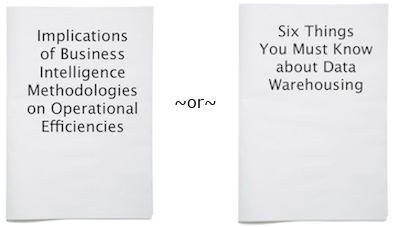
If you’re like most people, the title on the left makes your eyes glaze over …while the one on the right has a fighting chance to get your attention.
Here are 11 tips on putting together compelling titles for white papers.
Title tip #1: Understand the title is critical
Think about it: How do most prospective readers find your white paper?
Most likely they do a Google search, or visit a site like Bitpipe.com or Knowledgestorm.com or FindWhitePapers.com .
In any case, what do they see?
A list of titles, with a snippet of text under each one. Your challenge is to compel prospects to pick your title out of the pack.
Title tip #2: Learn to spot tired titles
A boring title usually contains no active verbs and loads of lengthy buzzwords.
Worst of all, it sounds just like 100 other titles you’ve heard before.
It’s just too generic, too careful, too corporate-sounding, and too packed with SEO buzzwords.
Title tip #3: Consider using a number
This article could be called “11 tips on white paper titles.”
But remember: Some say David Letterman ruined the Top 10 list forever. Everyone knows he only had five or six good ones and the rest were filler.
So don’t be afraid to stop at fewer than 10… or to push it past 10, as we did here.
See this article for more on using the numbered list format (aka “listicle”).
Title tip #4: Take time to find a dynamic name
With so much at stake, don’t just grab the first title anyone suggests.
Play around with some variations of your first idea until you have the punchiest possible name.
Title tip #5: Stress the benefits for readers
Always tell your readers what your information can do for them.
What will they gain from investing their precious time to download and read it?
Title tip #6: Address prospects by job title
That would look like “6 Things Every CIO Must Know about Data Warehousing.”
That makes it harder for any CIO to pass by without pausing and wondering if they know all six things.
Maybe they should check out your white paper; they might learn something.
Title tip #7: Call it what it is
Not everything has to be called a white paper.
Perhaps you should call your document an executive overview, a technology backgrounder, an evaluator’s guide, a special report, or something else entirely.
You can slip this in as a subtitle:
“6 Things Every CIO Must Know about Data Warehousing: an Executive Overview.”
Title tip #8: Never mention a product name
Putting a product name in a white paper title makes it sound like a sales pitch. Period.
So if that’s what you’re writing, don’t try to pass if off as a white paper. Call it a “brochure” or a “product brief.”
And remember that a sales pitch is the last thing most white papers readers want.
The only exception to this rule is a backgrounder or vanilla. For that flavour, you can and should mention the product in the title.
Title tip #9: Knock a tired title down to a subtitle
What if your manager or client hands you a boring title that you must use?
One tactic is to come up with a better title, then knock down the original to the subtitle.
For example, say your manager wants to call a white paper:
Making On-Board Sensors More Effective through Information Infrastructures
What a yawn?!
Then you come up with an intriguing image: The cutesy little lap dog can become an effective watch dog.
Combining these two gives you:
From Lap Dog to Watch Dog: Making On-Board Sensors More Effective through Information Infrastructure
What an improvement… and now you’re both happy.
Title tip #10: Run possible titles past sample readers
After all, someone in your intended audience can judge better than you or I what works for them and their colleagues.
Don’t guess, test.
Title tip #11: Back up your title with lively content
A title is like a promise. Don’t tack a great title on a ho-hum document.
Use your lively title to motivate you to create an exceptionally interesting white paper.
You’ll be way ahead of the crowd when you do.
Want to see more quick tips? Get my free newsletter, White Paper World .

About Gordon Graham
Worked on 320+ white papers for clients from Silicon Valley to Switzerland, on everything from choosing enterprise software to designing virtual worlds for kids, for clients from tiny startups to 3M, Google, and Verizon. Wrote White Papers for Dummies which earned 60+ 5-star ratings on Amazon. Won 16 awards from the Society for Technical Communication. Named AWAI 2019 Copywriter of the Year.
If you liked this post...

You asked: Is copywriting different from content writing?

Quick tip: Use AI to make a Mini-Me

White Paper World 42: June 14, 2024
Worst advice ever in 2015, coming into 2016. This would be relevant five, maybe three years ago. List-style articles/blog posts/documents/whatever are prevalent and considered the norm now. They make my eyes glaze over. In fact, not only when I see them my eyes glaze over, but I just think “the author can’t think of anything original to say” and then proceeds to list off things that have been “doing the rounds” on the internet.

Thanks for your opinion, Dan. I do agree that listicles can be over-used. But people click on them because they appeal to today’s time-pressured audiences who want a quick scan, not an in-depth essay. I still believe there’s nothing wrong with a numbered list or two in a library of white papers.
I agree with you Gordon. I love what you’ve written and contrary to what Dan said above, you offer good “food for thought”. I don’t have to use exactly what you offer, and probably shouldn’t. After all, I know my audience. But your piece (all your posts actually) have stimulated some great ideas I’m following through on that will be killer! Thanks for what you’re posting. Keep it up please Gordon!
[…] –Thatwhitepaperguy.com […]
Leave a Comment Cancel Reply
This site is protected by reCAPTCHA and the Google Privacy Policy and Terms of Service apply.
Need a great white paper?

- SUGGESTED TOPICS
- The Magazine
- Newsletters
- Managing Yourself
- Managing Teams
- Work-life Balance
- The Big Idea
- Data & Visuals
- Reading Lists
- Case Selections
- HBR Learning
- Topic Feeds
- Account Settings
- Email Preferences
How to Make a “Good” Presentation “Great”
- Guy Kawasaki

Remember: Less is more.
A strong presentation is so much more than information pasted onto a series of slides with fancy backgrounds. Whether you’re pitching an idea, reporting market research, or sharing something else, a great presentation can give you a competitive advantage, and be a powerful tool when aiming to persuade, educate, or inspire others. Here are some unique elements that make a presentation stand out.
- Fonts: Sans Serif fonts such as Helvetica or Arial are preferred for their clean lines, which make them easy to digest at various sizes and distances. Limit the number of font styles to two: one for headings and another for body text, to avoid visual confusion or distractions.
- Colors: Colors can evoke emotions and highlight critical points, but their overuse can lead to a cluttered and confusing presentation. A limited palette of two to three main colors, complemented by a simple background, can help you draw attention to key elements without overwhelming the audience.
- Pictures: Pictures can communicate complex ideas quickly and memorably but choosing the right images is key. Images or pictures should be big (perhaps 20-25% of the page), bold, and have a clear purpose that complements the slide’s text.
- Layout: Don’t overcrowd your slides with too much information. When in doubt, adhere to the principle of simplicity, and aim for a clean and uncluttered layout with plenty of white space around text and images. Think phrases and bullets, not sentences.
As an intern or early career professional, chances are that you’ll be tasked with making or giving a presentation in the near future. Whether you’re pitching an idea, reporting market research, or sharing something else, a great presentation can give you a competitive advantage, and be a powerful tool when aiming to persuade, educate, or inspire others.
- Guy Kawasaki is the chief evangelist at Canva and was the former chief evangelist at Apple. Guy is the author of 16 books including Think Remarkable : 9 Paths to Transform Your Life and Make a Difference.
Partner Center
He is dangerous in word, deed and action
He puts self over country, he loathes the laws we live by, donald trump is unfit to lead.
The editorial board is a group of opinion journalists whose views are informed by expertise, research, debate and certain longstanding values . It is separate from the newsroom.
Next week, for the third time in eight years, Donald Trump will be nominated as the Republican Party’s candidate for president of the United States. A once great political party now serves the interests of one man, a man as demonstrably unsuited for the office of president as any to run in the long history of the Republic, a man whose values, temperament, ideas and language are directly opposed to so much of what has made this country great.
It is a chilling choice against this national moment. For more than two decades, large majorities of Americans have said they are dissatisfied with the direction of the country, and the post-Covid era of stubborn inflation, high interest rates, social division and political stagnation has left many voters even more frustrated and despondent.

The Republican Party once pursued electoral power in service to solutions for such problems, to building “the shining city on a hill,” as Ronald Reagan liked to say. Its vision of the United States — embodied in principled public servants like George H.W. Bush, John McCain and Mitt Romney — was rooted in the values of freedom, sacrifice, individual responsibility and the common good. The party’s conception of those values was reflected in its longstanding conservative policy agenda, and today many Republicans set aside their concerns about Mr. Trump because of his positions on immigration, trade and taxes. But the stakes of this election are not fundamentally about policy disagreements. The stakes are more foundational: what qualities matter most in America’s president and commander in chief.
Mr. Trump has shown a character unworthy of the responsibilities of the presidency. He has demonstrated an utter lack of respect for the Constitution, the rule of law and the American people. Instead of a cogent vision for the country’s future, Mr. Trump is animated by a thirst for political power: to use the levers of government to advance his interests, satisfy his impulses and exact retribution against those who he thinks have wronged him.
He is, quite simply, unfit to lead.
The Democrats are rightly engaged in their own debate about whether President Biden is the right person to carry the party’s nomination into the election, given widespread concerns among voters about his age-related fitness. This debate is so intense because of legitimate concerns that Mr. Trump may present a danger to the country, its strength, security and national character — and that a compelling Democratic alternative is the only thing that would prevent his return to power. It is a national tragedy that the Republicans have failed to have a similar debate about the manifest moral and temperamental unfitness of their standard-bearer, instead setting aside their longstanding values, closing ranks and choosing to overlook what those who worked most closely with the former president have described as his systematic dishonesty, corruption, cruelty and incompetence.
That task now falls to the American people. We urge voters to see the dangers of a second Trump term clearly and to reject it. The stakes and significance of the presidency demand a person who has essential qualities and values to earn our trust, and on each one, Donald Trump fails.
Moral Fitness Matters

Presidents are confronted daily with challenges that require not just strength and conviction but also honesty, humility, selflessness, fortitude and the perspective that comes from sound moral judgment.
If Mr. Trump has these qualities, Americans have never seen them in action on behalf of the nation’s interests. His words and actions demonstrate a disregard for basic right and wrong and a clear lack of moral fitness for the responsibilities of the presidency.
He lies blatantly and maliciously, embraces racists , abuses women and has a schoolyard bully’s instinct to target society’s most vulnerable. He has delighted in coarsening and polarizing the town square with ever more divisive and incendiary language. Mr. Trump is a man who craves validation and vindication, so much that he would prefer a hostile leader’s lies to his own intelligence agencies’ truths and would shake down a vulnerable ally for short-term political advantage . His handling of everything from routine affairs to major crises was undermined by his blundering combination of impulsiveness, insecurity and unstudied certainty.
This record shows what can happen to a country led by such a person: America’s image, credibility and cohesion were relentlessly undermined by Mr. Trump during his term.
None of his wrongful actions are so obviously discrediting as his determined and systematic attempts to undermine the integrity of elections — the most basic element of any democracy — an effort that culminated in an insurrection at the Capitol to obstruct the peaceful transfer of power.
On Jan. 6, 2021, Mr. Trump incited a mob to violence with hateful lies, then stood by for hours as hundreds of his supporters took his word and stormed the Capitol with the aim of terrorizing members of Congress into keeping him in office. He praised these insurrectionists and called them patriots; today he gives them a starring role at campaign rallies, playing a rendition of the national anthem sung by inmates involved with Jan. 6., and he has promised to consider pardoning the rioters if re-elected. He continues to wrong the country and its voters by lying about the 2020 election, branding it stolen, despite the courts, the Justice Department and Republican state officials disputing him. No man fit for the presidency would flog such pernicious and destructive lies about democratic norms and values, but the Trumpian hunger for vindication and retribution has no moral center.
To vest such a person with the vast powers of the presidency is to endanger American interests and security at home as well as abroad. The nation’s commander in chief must uphold the oath to “preserve, protect and defend the Constitution.” It is the closest thing that this secular nation has to a sacred trust. The president has several duties and powers that are his alone: He has the sole authority to launch a nuclear weapon. He has the authority to send American troops into harm’s way and to authorize the use of lethal force against individuals and other nations. Americans who serve in the military also take an oath to defend the Constitution, and they rely on their commander in chief to take that oath as seriously as they do.
Mr. Trump has shown, repeatedly, that he does not. On numerous occasions, he asked his defense secretary and commanders in the American armed forces to violate that oath. On other occasions, he demanded that members of the military violate norms that preserve the dignity of the armed services and protect the military from being used for political purposes. They largely refused these illegal and immoral orders, as the oath requires.
The lack of moral grounding undermines Mr. Trump even in areas where voters view him as stronger and trust him more than Mr. Biden, like immigration and crime. Veering into a kind of brutal excess that is, at best, immoral and, at worst, unconstitutional, he has said that undocumented immigrants were “ poisoning the blood of our country ,” and his advisers say he would aim to round them up in mass detention camps and end birthright citizenship . He has indicated that, if faced with episodes of rioting or crime surges, he would unilaterally send troops into American cities. He has asked aides if the United States could shoot migrants below the waist to slow them down, and he has said that he would use the Insurrection Act to deploy the military against protesters.
During his time in office, none of those things happened because there were enough people in military leadership with the moral fitness to say “no” to such illegal orders. But there are good reasons to worry about whether that would happen again, as Mr. Trump works harder to surround himself with people who enable rather than check his most insidious impulses.
The Supreme Court, with its ruling on July 1 granting presidents “absolute immunity” for official acts, has removed an obstacle to Mr. Trump’s worst impulses: the threat of legal consequences. What remains is his own sense of right and wrong. Our country’s future is too precious to rely on such a broken moral compass.
Principled Leadership Matters

Republican presidents and presidential candidates have used their leadership at critical moments to set a tone for society to live up to. Mr. Reagan faced down totalitarianism in the 1980s, appointed the first woman to the Supreme Court and worked with Democrats on bipartisan tax and immigration reforms. George H.W. Bush signed the Americans With Disabilities Act and decisively defended an ally, Kuwait, against Iraqi aggression. George W. Bush, for all his failures after Sept. 11, did not stoke hate against or demonize Muslims or Islam.
As a candidate during the 2008 race, Mr. McCain spoke out when his fellow conservatives spread lies about his opponent, Barack Obama. Mr. Romney was willing to sacrifice his standing and influence in the party he once represented as a presidential nominee, by boldly calling out Mr. Trump’s failings and voting for his removal from office.
These acts of leadership are what it means to put country first, to think beyond oneself.
Mr. Trump has demonstrated contempt for these American ideals. He admires autocrats, from Viktor Orban to Vladimir Putin to Kim Jong-un. He believes in the strongman model of power — a leader who makes things happen by demanding it, compelling agreement through force of will or personality. In reality, a strongman rules through fear and the unprincipled use of political might for self-serving ends, imposing poorly conceived policies that smother innovation, entrepreneurship, ideas and hope.
During his four years in office, Mr. Trump tried to govern the United States as a strongman would, issuing orders or making decrees on Twitter. He announced sudden changes in policy — on who can serve in the military , on trade policy, on how the United States deals with North Korea or Russia — without consulting experts on his staff about how these changes would affect America. Indeed, nowhere did he put his political or personal interests above the national interest more tragically than during the pandemic , when he faked his way through a crisis by touting conspiracy theories and pseudoscience while ignoring the advice of his own experts and resisting basic safety measures that would have saved lives.
He took a similar approach to America’s strategic relationships abroad. Mr. Trump lost the trust of America’s longstanding allies, especially in NATO, leaving Europe less secure and emboldening the far right and authoritarian leaders in Europe, Latin America and Asia. He pulled out of the Iran nuclear deal, leaving that country, already a threat to the world, more dangerous, thanks to a revived program that has achieved near-weapons-grade uranium.
In a second term, his willingness to appease Mr. Putin would leave Ukraine’s future as a democratic and independent country in doubt. Mr. Trump implies that he could single-handedly end the catastrophic war in Gaza but has no real plan. He has suggested that in a second term he’d increase tariffs on Chinese goods to 60 percent or higher and that he would put a 10 percent tariff on all imported goods, moves that would raise prices for American consumers and reduce innovation by allowing U.S. industries to rely on protectionism instead.
The worst of the Trump administration’s policies were often blocked by Congress, by court challenges and by the objections of honorable public servants who stepped in to thwart his demands when they were irresponsible or did not follow the law. When Mr. Trump wanted an end to Obamacare, a single Republican senator, Mr. McCain, saved it, preserving health care for millions of Americans. Mr. Trump demanded that James Comey, his F.B.I. director, pledge loyalty to him and end an investigation into a political ally; Mr. Comey refused. Scientists and public health officials called out and corrected his misinformation about climate science and Covid. The Supreme Court sided against the Trump administration more times than any other president since at least Franklin D. Roosevelt.
A second Trump administration would be different. He intends to fill his administration with sycophants, those who have shown themselves willing to obey Mr. Trump’s demands or those who lack the strength to stand up to him. He wants to remove those who would be obstacles to his agenda, by enacting an order to make it easier to fire civil servants and replace them with those more loyal to him.
This means not only that Americans would lose the benefit of their expertise but also that America would be governed in a climate of fear, in which government employees must serve the interests of the president rather than the public. All cabinet secretaries follow a president’s lead, but Mr. Trump envisions a nation in which public service as Americans understand it would cease to exist — where individual civil servants and departments could no longer make independent decisions and where research by scientists and public health experts and investigations by the Justice Department and others in federal law enforcement would be more malleable to the demands of the White House.
Another term under Mr. Trump’s leadership would risk doing permanent damage to our government. As Mr. Comey, a longtime Republican, wrote in a 2019 guest essay for Times Opinion, “Accomplished people lacking inner strength can’t resist the compromises necessary to survive Mr. Trump and that adds up to something they will never recover from.” Very few who serve under him can avoid this fate “because Mr. Trump eats your soul in small bites,” Mr. Comey wrote. “Of course, to stay, you must be seen as on his team, so you make further compromises. You use his language, praise his leadership, tout his commitment to values. And then you are lost. He has eaten your soul.” America will get nowhere with a strongman. It needs a strong leader.
Character Matters

Character is the quality that gives a leader credibility, authority and influence. During the 2016 campaign, Mr. Trump’s petty attacks on his opponents and their families led many Republicans to conclude that he lacked such character. Other Republicans, including those who supported the former president’s policies in office, say they can no longer in good conscience back him for the presidency. “It’s a job that requires the kind of character he just doesn’t have,” Paul Ryan, a former Republican House speaker, said of Mr. Trump in May .
Those who know Mr. Trump’s character best — the people he appointed to serve in the most important positions of his White House — have expressed grave doubts about his fitness for office.
His former chief of staff John Kelly, a retired four-star Marine Corps general, described Mr. Trump as “a person who admires autocrats and murderous dictators. A person that has nothing but contempt for our democratic institutions, our Constitution and the rule of law.” Bill Barr, whom Mr. Trump appointed as attorney general, said of him , “He will always put his own interest and gratifying his own ego ahead of everything else, including the country’s interest.” James Mattis, a retired four-star Marine general who served as defense secretary, said , “Donald Trump is the first president in my lifetime who does not try to unite the American people — does not even pretend to try.”
Mike Pence, Mr. Trump’s vice president, has disavowed him. No other vice president in modern American history has done this. “I believe that anyone who puts themselves over the Constitution should never be president of the United States,” Mr. Pence has said . “And anyone who asked someone else to put them over the Constitution should never be president of the United States again.”
These are hardly exceptions. In any other American administration, a single cabinet-level defection is rare. But an unprecedented number of Mr. Trump’s appointees have publicly criticized his leadership, opposed his 2024 presidential candidacy or ducked questions about his fitness for a second term. More than a dozen of his most senior appointees — those he chose to work alongside him and who saw his performance most closely — have spoken out against him, serving as witnesses about the kind of leader he is.
There are many ways to judge leaders’ character; one is to see whether they accept responsibility for their actions. As a general rule, Mr. Trump abhors accountability. If he loses, the election is rigged. If he is convicted, it’s because the judges are out to get him. If he doesn’t get his way in a deal, as happened multiple times with Congress in his term, he shuts down the government or threatens to.
Americans do not expect their presidents to be perfect; many of them have exhibited hubris, self-regard, arrogance and other character flaws. But the American system of government is more than just the president: It is a system of checks and balances, and it relies on everyone in government to intervene when a president’s personal failings might threaten the common good.
Mr. Trump tested those limits as president, and little has changed about him in the four years since he lost re-election. He tries to intimidate anyone with the temerity to testify as a witness against him. He attacks the integrity of judges who are doing their duty to hold him accountable to the law. He mocks those he dislikes and lies about those who oppose him and targets Republicans for defeat if they fail to bend the knee.
It may be tempting for Americans to believe that a second Trump presidency would be much like the first, with the rest of government steeled to protect the country and resist his worst impulses. But the strongman needs others to be weak, and Mr. Trump is surrounding himself with yes men.
The American public has a right to demand more from their president and those who would serve under him.
A President’s Words Matter

When America saw white nationalists and neo-Nazis march through the streets of Charlottesville, Va., in 2017 and activists were rallying against racism, Mr. Trump spoke of “very fine people on both sides.” When he was pressed about the white supremacist Proud Boys during a 2020 debate, Mr. Trump told them to “stand back and stand by,” a request that, records show, they took literally in deciding to storm Congress. This winter, the former president urged Iowans to vote for him and score a victory over their fellow Americans — “all of the liars, cheaters, thugs, perverts, frauds, crooks, freaks, creeps.” And in a Veterans Day speech in New Hampshire, he used the word “vermin,” a term he has deployed to describe both immigrants and political opponents.
What a president says reflects on the United States and the kind of society we aspire to be.
In 2022 this board raised an urgent alarm about the rising threat of political violence in the United States and what Americans could do to stop it. At the time, Mr. Trump was preparing to declare his intention to run for president again, and the Republican Party was in the middle of a fight for control, between Trumpists and those who were ready to move on from his destructive leadership. This struggle within the party has consequences for all Americans. “A healthy democracy requires both political parties to be fully committed to the rule of law and not to entertain or even tacitly encourage violence or violent speech,” we wrote.
A large faction of one party in our country fails that test, and that faction, Mr. Trump’s MAGA extremists, now control the party and its levers of power. There are many reasons his conquest of the Republican Party is bad for American democracy, but one of the most significant is that those extremists have often embraced violent speech or the belief in using violence to achieve their political goals. This belief led to the Jan. 6 attack on the Capitol, and it has resulted in a rising number of threats against judges, elected officials and prosecutors.
This threat cannot be separated from Mr. Trump’s use of language to encourage violence, to dehumanize groups of people and to spread lies. A study by researchers at the University of California, Davis, released in October 2022, came to the conclusion that MAGA Republicans (as opposed to those who identified themselves as traditional Republicans) “are more likely to hold extreme and racist beliefs, to endorse political violence, to see such violence as likely to occur and to predict that they will be armed under circumstances in which they consider political violence to be justified.”
The Republican Party had an opportunity to renounce Trumpism; it has submitted to it. Republican leaders have had many opportunities to repudiate his violent discourse and make clear that it should have no place in political life; they failed to. Sizable numbers of voters in Republican primaries abandoned Mr. Trump for other candidates, and independent and undecided voters have said that Mr. Trump’s language has alienated them from his candidacy.
But with his nomination by his party all but assured, Mr. Trump has become even more reckless in employing extreme and violent speech, such as his references to executing generals who raise questions about his actions. He has argued, before the Supreme Court, that he should have the right to assassinate a political rival and face no consequences.
The Rule of Law Matters

The danger from these foundational failings — of morals and character, of principled leadership and rhetorical excess — is never clearer than in Mr. Trump’s disregard for rule of law, his willingness to do long-term damage to the integrity of America’s systems for short-term personal gain.
As we’ve noted, Mr. Trump’s disregard for democracy was most evident in his attempts to overturn the results of the 2020 election and to encourage violence to stop the peaceful transfer of power. What stood in his way were the many patriotic Americans, at every level of government, who rejected his efforts to bully them into complying with his demands to change election results. Instead, they followed the rules and followed the law. This respect for the rule of law, not the rule of men, is what has allowed American democracy to survive for more than 200 years.
In the four years since losing the election, Mr. Trump has become only more determined to subvert the rule of law, because his whole theory of Trumpism boils down to doing whatever he wants without consequence. Americans are seeing this unfold as Mr. Trump attempts to fight off numerous criminal charges. Not content to work within the law to defend himself, he is instead turning to sympathetic judges — including two Supreme Court justices with apparent conflicts over the 2020 election and Jan. 6-related litigation. The playbook: delay federal prosecution until he can win election and end those legal cases. His vision of government is one that does what he wants, rather than a government that operates according to the rule of law as prescribed by the Constitution, the courts and Congress.
As divided as America is, people across the political spectrum generally recoil from rigged rules, favoritism, self-dealing and abuse of power. Our country has been so stable for so long in part because most Americans and most American leaders follow the rules or face the consequences.
So much in the past two decades has tested these norms in our society — the invasion of Iraq under false pretenses, the failures that led to the 2008 financial crisis and the recession that followed, the pandemic and all the fractures and inequities that it revealed. We need a recommitment to the rule of law and the values of fair play. This election is a moment for Americans to decide whether we will keep striving for those ideals.
Mr. Trump rejects them. If he is re-elected, America will face a new and precarious future, one that it may not be prepared for. It is a future in which intelligence agencies would be judged not according to whether they preserved national security but by whether they served Mr. Trump’s political agenda. It means that prosecutors and law enforcement officials would be judged not according to whether they follow the law to keep Americans safe but by whether they obey his demands to “go after” political enemies. It means that public servants would be judged not according to their dedication or skill but by whether they show sufficient loyalty to him and his MAGA agenda.
Even if Mr. Trump’s vague policy agenda would not be fulfilled, he could rule by fear. The lesson of other countries shows that when a bureaucracy is politicized or pressured, the best public servants will run for the exits.
This is what has already happened in Mr. Trump’s Republican Party, with principled leaders and officials retiring, quitting or facing ouster. In a second term, he intends to do that to the whole of government.
Election Day is less than four months away. The case against Mr. Trump is extensive, and this board urges Americans to perform a simple act of civic duty in an election year: Listen to what Mr. Trump is saying, pay attention to what he did as president and allow yourself to truly inhabit what he has promised to do if returned to office.
Voters frustrated by inflation and immigration or attracted by the force of Mr. Trump’s personality should pause and take note of his words and promises. They have little to do with unity and healing and a lot to do with making the divisions and anger in our society wider and more intense than they already are.
The Republican Party is making its choice next week; soon all Americans will be able to make their own choice. What would Mr. Trump do in a second term? He has told Americans who he is and shown them what kind of leader he would be.
When someone fails so many foundational tests, you don’t give him the most important job in the world.
From top, photographs and video by Damon Winter/The New York Times (2) and Jay Turner Frey Seawell (5).
- Share full article
Advertisement
Press Herald
Account Subscription: ACTIVE
Questions about your account? Our customer service team can be reached at [email protected] during business hours at (207) 791-6000 .
Ossipee Valley Fair, Moxie Festival and more happening this weekend
The Maine International Film Festival starts Friday in Waterville.

You are able to gift 5 more articles this month.
Anyone can access the link you share with no account required. Learn more .
With a Press Herald subscription, you can gift 5 articles each month.
It looks like you do not have any active subscriptions. To get one, go to the subscriptions page .
Loading....
Now that we’re all comfortably settled into the rhythm of summer, let’s do a classic summer thing and go to a fair!

Jeremy Schoff of York leads his oxen, Pete and Red, during the ox pull on Thursday at the Ossippe Valley Fair in 2021. Ben McCanna/Staff Photographer
The Ossipee Valley Fair starts today and runs through Sunday. We especially love the Farmer Olympics because the hay bale toss and blind wheelbarrow obstacle course competition is fierce. Ray Routhier has details about Ossipee Valley and several others fairs happening this summer in Bangor, Waterville and Acton, among other locales.
Go a little farther afield and find a Maine summer fair for you

Aretha Aoki & Ryan MacDonald (right, in bear suit) performing IzumonookunI (stet capital letter at the end). Aretha Aoki & Ryan MacDonald will be bringing this dance program to the Bates Dance Festival July 12 and 14, 2024 at the Schaeffer Theatre on the Bates College campus in Lewiston, Maine. Photo by Colin Kelly
Another summer tradition is the Bates Dates Festival in Lewiston . Performances are underway, and arts writer Megan Gray has the scoop on “IzumonookunI” by Aretha Aoki and Ryan MacDonald. See it tonight and Saturday.
Topsham couple’s Bates Dance Festival performance is inspired by kabuki, punk rock and their 7-year-old

Big Yellow Taxi. Photo by Julian Parker Burns
I’m headed to One Longfellow Square on Friday night to see the Massachusetts-based Joni Mitchell tribute band Big Yellow Taxi. They’ll be playing Mitchell’s 1974 album “Court and Spark,” along with other tunes.
Tribute to Joni Mitchell celebrates 50 years of ‘Court and Spark’

“3 Vendors of Ipanema” is directed by Lewiston native Jonathan S. Lee. Courtesy of JSL Films
We weren’t kidding when we said there’s a lot going on right now. The 27th annual Maine International Film Festival starts on Friday and runs through July 21 in Waterville. Our film writer, Dennis Perkins, offers up his picks for 12 screenings worth your while.
12 hidden gems of this year’s Maine International Film Festival

Spectators watching a previous year’s Moxie Festival Parade in Lisbon Falls. Carl D. Walsh/Staff Photographer
Our weekly events roundup includes the East Bayside block party in Portland and the Moxie Festival in Lisbon Falls. Should you make it to the festival on Saturday, don’t miss “American Idol” alum Julia Gagnon singing at 1:30 p.m.
Kennebunks garden tour, Moxie Festival, East Bayside block party

One with Everything from Gunnar’s Icelandic Hot Dogs. Photo by Ray Routhier
Need a break from standard-issue hot dogs? We love them too, but sometimes a new twist is just what your taste buds need. Ray Routhier stopped by Gunnar’s Icelandic Hot Dogs cart . If you like what you read, you can find it parked from 4-9 p.m. Thursday at Apres in Portland, then on the roof of Bayside Bowl on Friday and Saturday evenings.
Sick of red snappers? Try an Icelandic hot dog instead
Modify your screen name
Join the Conversation
Please sign into your Press Herald account to participate in conversations below. If you do not have an account, you can register or subscribe . Questions? Please see our FAQs .
Your commenting screen name has been updated.
Send questions/comments to the editors.
« Previous
Covered bridges in Maine: 8 historic sites plus some modern options
Next »
Coastal Maine Botanical Gardens is free on Wednesdays for kids 17 and under
Member Log In
Please enter your username and password below. Already a subscriber but don't have one? Click here .
Not a subscriber? Click here to see your options

COMMENTS
Format and finalize: Format your white paper to make it visually appealing and reader-friendly. Use appropriate headings, subheadings, fonts, and spacing. Consider adding a table of contents for easy navigation. Finally, proofread your document one last time before publishing or sharing it.
Add a text box and choose to write with AI. In the prompt window, explain the main topic of your white paper, what you're planning to cover and ask it to write an outline for you. If you're writing from scratch, use high-level headings for the critical sections of your content, and then branch out into subheadings.
This article will help you decide if a white paper is right for you, and if yes, how to prepare and produce one. To write a white paper, thoroughly research a topic and propose a comprehensive solution in a well-structured, factual, and persuasive document. A white paper should include: 1. Title (accurate but enticing)
Step 1: Grasp the white paper's core. Recognize that a white paper is more than just a long article. It's a detailed report on a specific topic, designed to educate and address issues. Understand its origins from government documents and its evolution into a tool for thought leadership.
A white paper is an authoritative document designed to inform and persuade stakeholders by providing in-depth research and solutions to specific problems. Key elements include the title, abstract, introduction, problem statement, solution, conclusion, and references. Creating a detailed outline is essential for organization and effectiveness.
White Paper Guide: How to Write a White Paper. Written by MasterClass. Last updated: Aug 17, 2021 • 5 min read. A white paper is a marketing and sales tool and document used by businesses to explore a particular subject matter related to its product or service and to generate sales leads. A white paper is a marketing and sales tool and ...
As the founder of Uplift Content, Emily leads her team in creating done-for-you case studies, ebooks and blog posts for high-growth SaaS companies like ClickUp, Calendly and WalkMe. Connect with Emily on Linkedin. Find out how to write a white paper: 1. Know your audience 2. Strategize and plan 3.
8. Edit and proofread. Once you've completed your white paper, edit and proofread to ensure the utmost accuracy. You can either have a professional editor or writer go over your draft, or you can edit your document yourself. Be sure to edit for not only spelling and grammar but also for content.
3. How to write a white paper. Starting a white paper can be a daunting task. So much information and research are required that it's easy to get lost in that portion of the work and let it become a roadblock to actually putting things on paper. Even after the writing itself has begun, white papers are tricky to do well.
Phase 2. Writing a white paper from start to finish. With a plan in place, it's time to conduct your research, develop your white paper structure and deploy any surveys for data collection. With the Index™, we use a platform like SurveyMonkey to conduct two different surveys: one for 1,000 consumers and one for 1,000 social marketers.
A white paper presents information, research, or findings on a specific topic comprehensively and authoritatively. It presents research findings, incorporates expert opinions, and offers evidence-based recommendations. White papers are written in a clear, authoritative, and unbiased tone to establish the writer's knowledge as respectable.
Here are some tips for writing a white paper, from choosing a topic to sharing your content with the world. 1. Choose a compelling topic. White paper topics should focus on things people actually want to read about. This seems obvious, but finding the right topic can be your biggest challenge.
10 Best White Paper Examples. To help you better understand how to write a white paper, we're sharing 10 examples from different organizations in various industries. 1. Temenos White Paper. Temenos is a software business that specializes in banking and financial services software.
Writing a white paper isn't easy but it's a great way to stand out in your field and build authority with your audience. For that reason, developing your white paper should take time since you need to write with purpose. Don't rush the process: An effective white paper needs quality over quantity. 5 steps to write white papers that impress
Business white paper examples. Businesses write white papers for a number of reasons. It's a great document to showcase a company's expertise in the field and to win over investors. A white paper can also be used for marketing purposes and brand awareness (which I'll discuss in the next section). Here's an example of a business white paper:
5. Add Visuals, Examples, and Resources. Although white papers are longer in form and complex in content, you should still make them easy to read and digest. You can do this by adding visual components such as images, graphs, tables or charts. Also, use real-life examples in the text and state your resources and works cited in the paper.
If your instructor asks you to write a white paper, follow their instructions regarding length. Be prepared to write a minimum of five pages. Note that images should be used as supplements to the written word, not substitutes. In other words, one page of content is 300 words on average; if your assignment requires 10 pages, you should write ...
Simply showing proof that you can write a white paper is enough for a potential client to hire you. 3. Niche Down to White Paper Writing. To stand out and get the best conversions for your business, niche down to white paper writing. For example, freelance writer Wilton Blake is niched down for writing white papers and case studies.
Beginning white paper writers often get a couple of surprises on their first projects. Surprise #1: Even though we call it "writing a white paper" the writing is only one of a dozen steps along the way. Few of these steps involve composing or revising text. Most of them involve something else.
14. Parallel Tracks: Drills down into a series of related ideas, with an identical set of subsets for each idea. This is something like using a table with the same rows for each column heading, or a database with the same categories for each item. This could certainly work for a white paper.
White papers are great examples of marketing collateral that exhibit your authority over a chosen niche. Mostly, they are long-form content intended to educate the target audience, that delve deeper into industry trends, issues, and policies and explain its causes, implications, and benefits. Companies, public institutions, governments ...
25 Organizational Design White Paper Example. In stark contrast to the red accent color, this organizational design white paper example uses a cool color scheme with blues and greens. This is a great color scheme to use for a more creative industry or topic. Create your own White Paper with this easy-to-edit template.
Title tip #8: Never mention a product name. Putting a product name in a white paper title makes it sound like a sales pitch. Period. So if that's what you're writing, don't try to pass if off as a white paper. Call it a "brochure" or a "product brief.". And remember that a sales pitch is the last thing most white papers readers want.
Summary. A strong presentation is so much more than information pasted onto a series of slides with fancy backgrounds. Whether you're pitching an idea, reporting market research, or sharing ...
Remember, writing is as much a skill as understanding economic theory; like any skill, it improves with practice. Read widely about writing. Refer to well-known guides such as Strunk and White's "Elements of Style" and William Zinsser's "On Writing Well." Get a copy of them. Read them—again and again and again—to internalize the advice.
A once great political party now serves the interests of one man, a man as demonstrably unsuited for the office of president as any to run in the long history of the Republic, a man whose values ...
John McEntee, former director of the White House Presidential Personnel Office and one of Trump's most trusted aides, is a senior adviser for the project. McEntee said in April that the Trump campaign and Project 2025 plan to "integrate a lot of our work" this summer, according to the liberal watchdog Media Matters.
You are able to gift 5 more articles this month. Anyone can access the link you share with no account required. Learn more. The Ossipee Valley Fair starts today and runs through Sunday. We ...